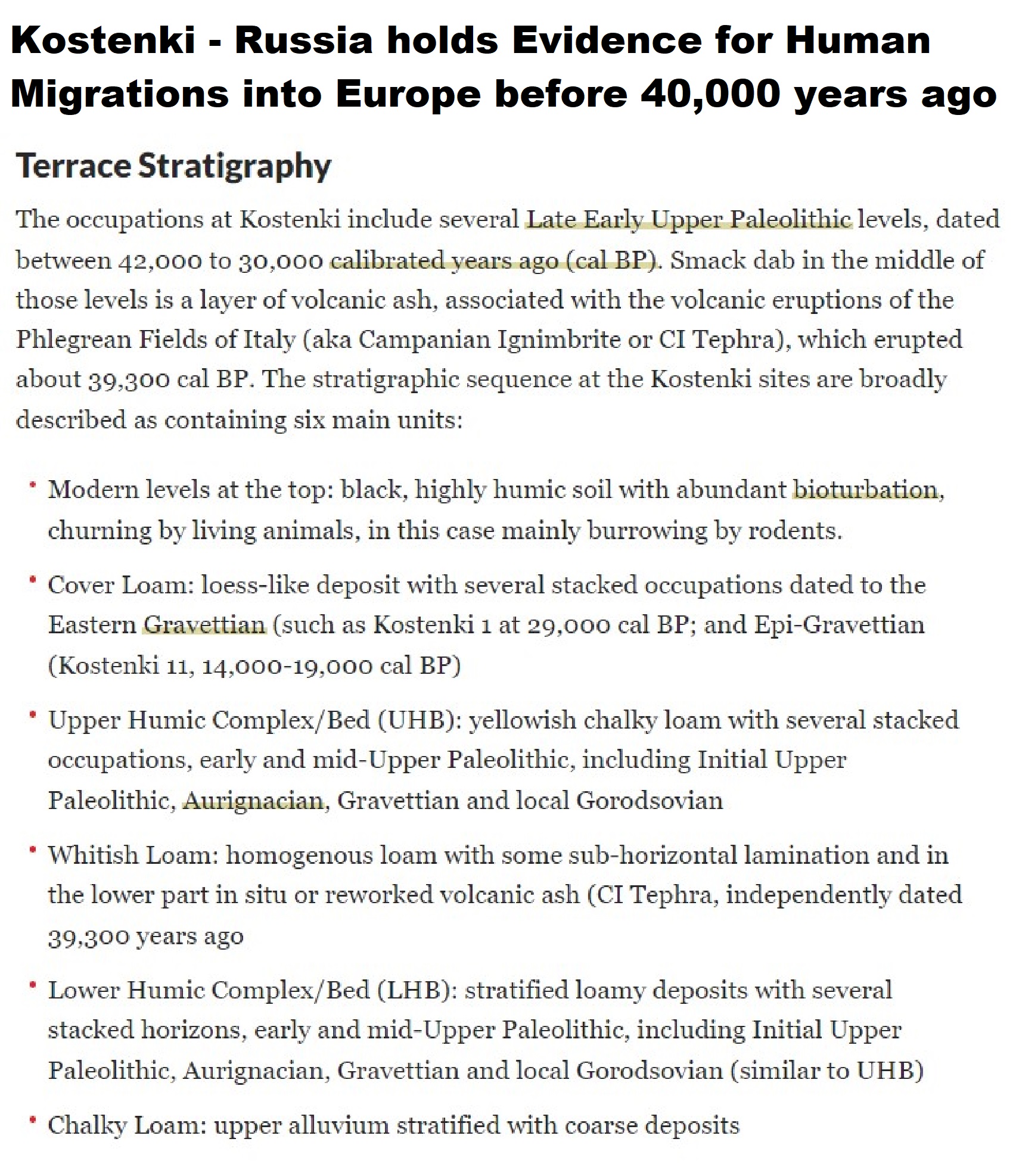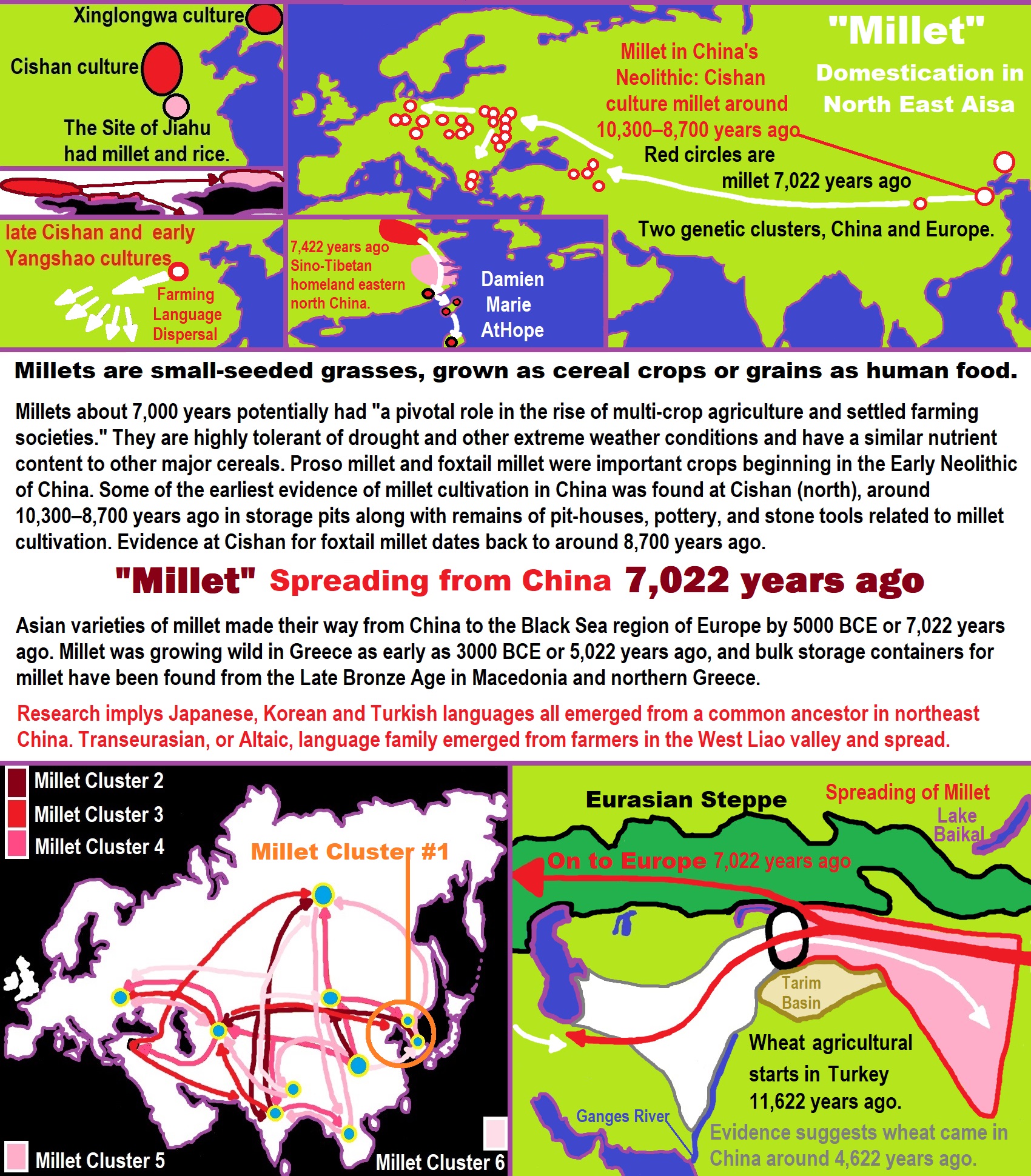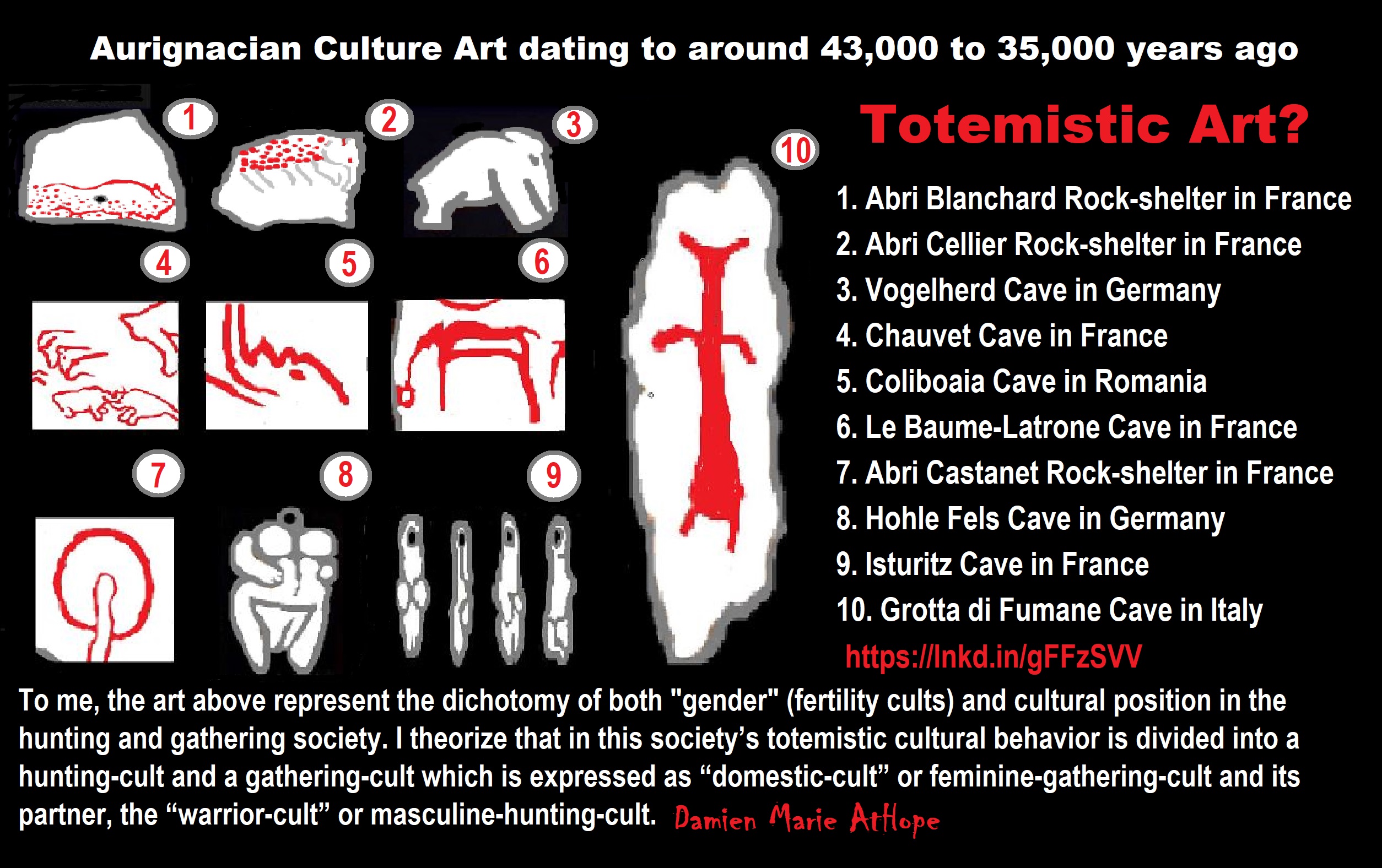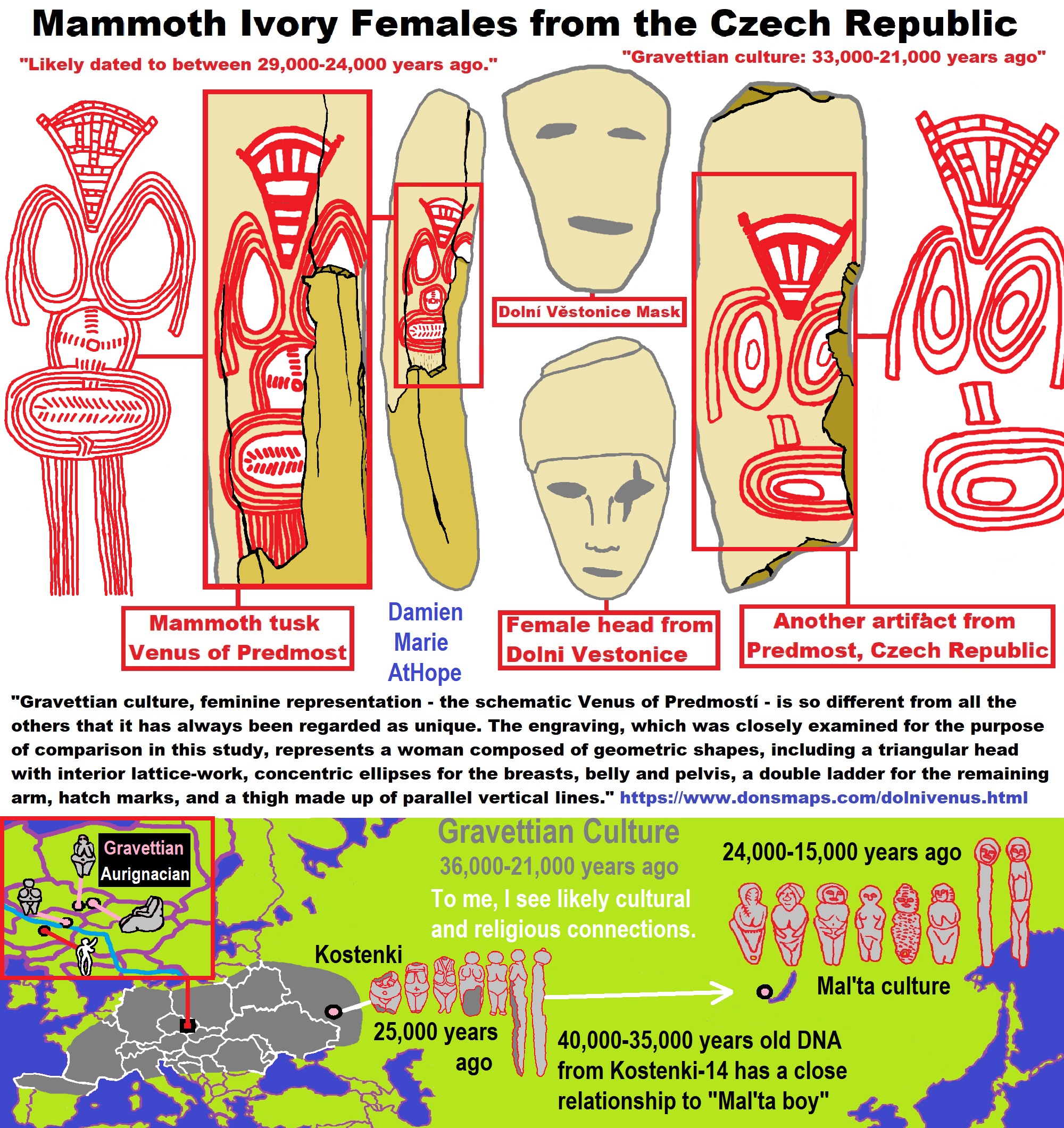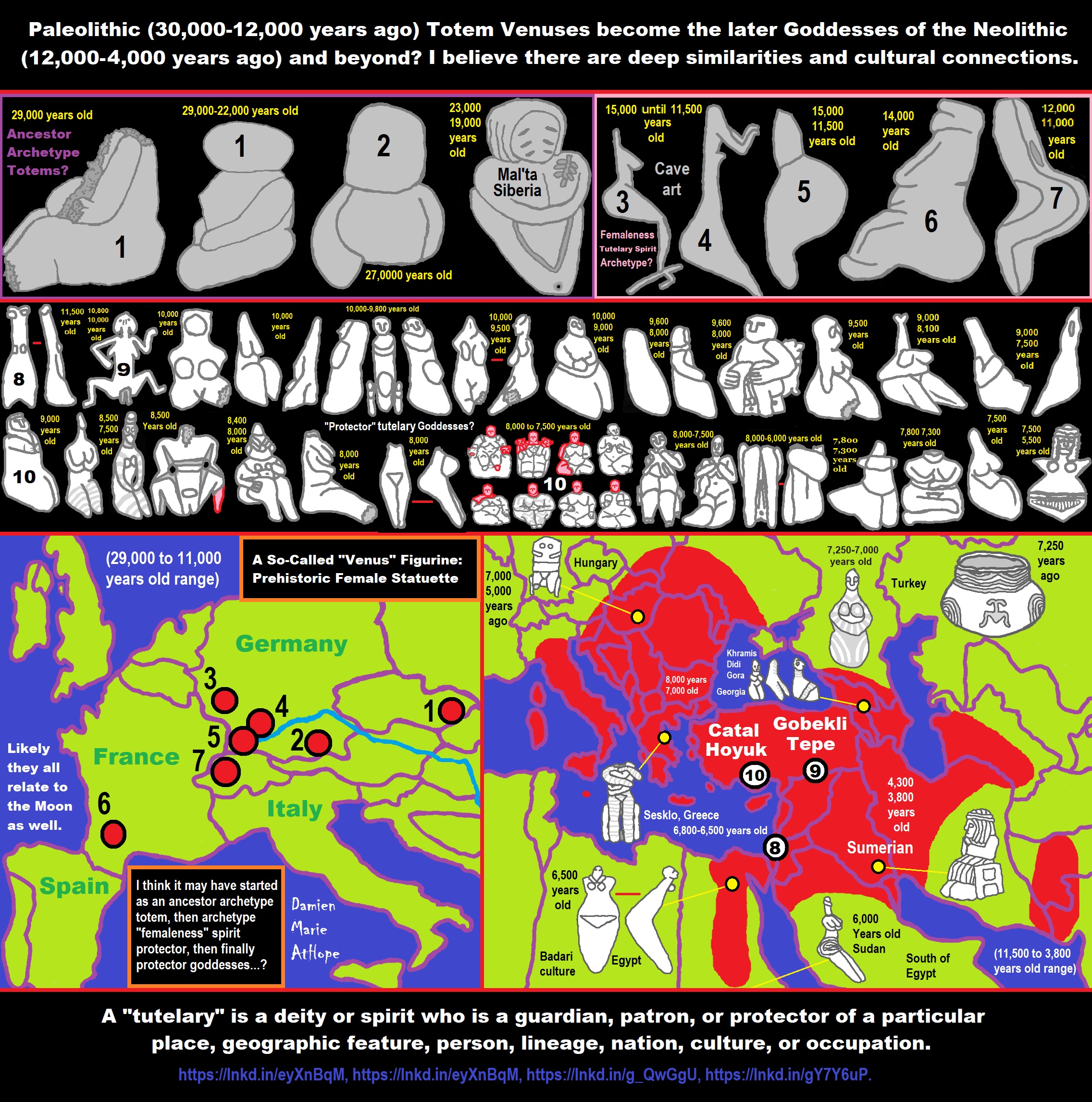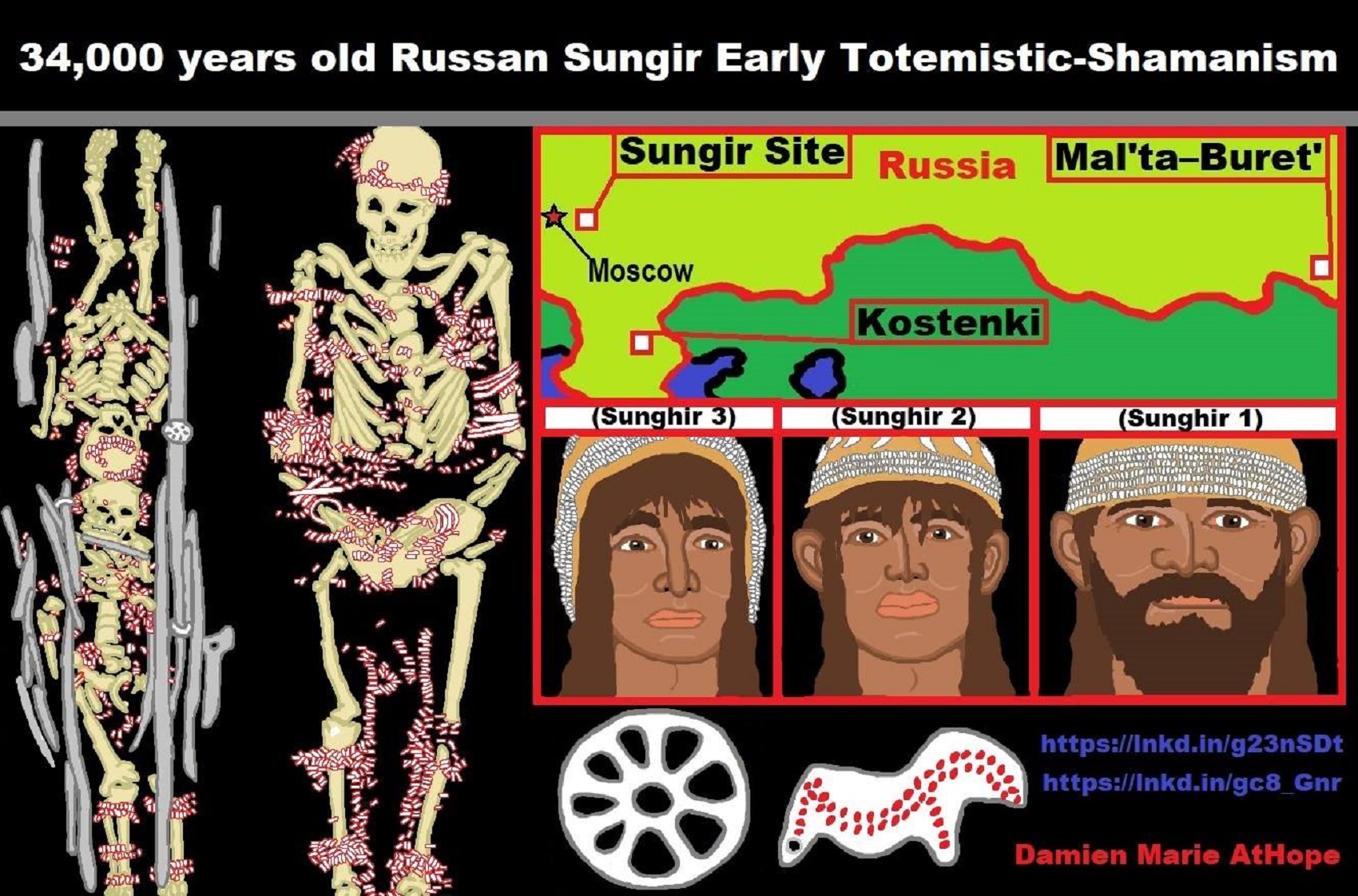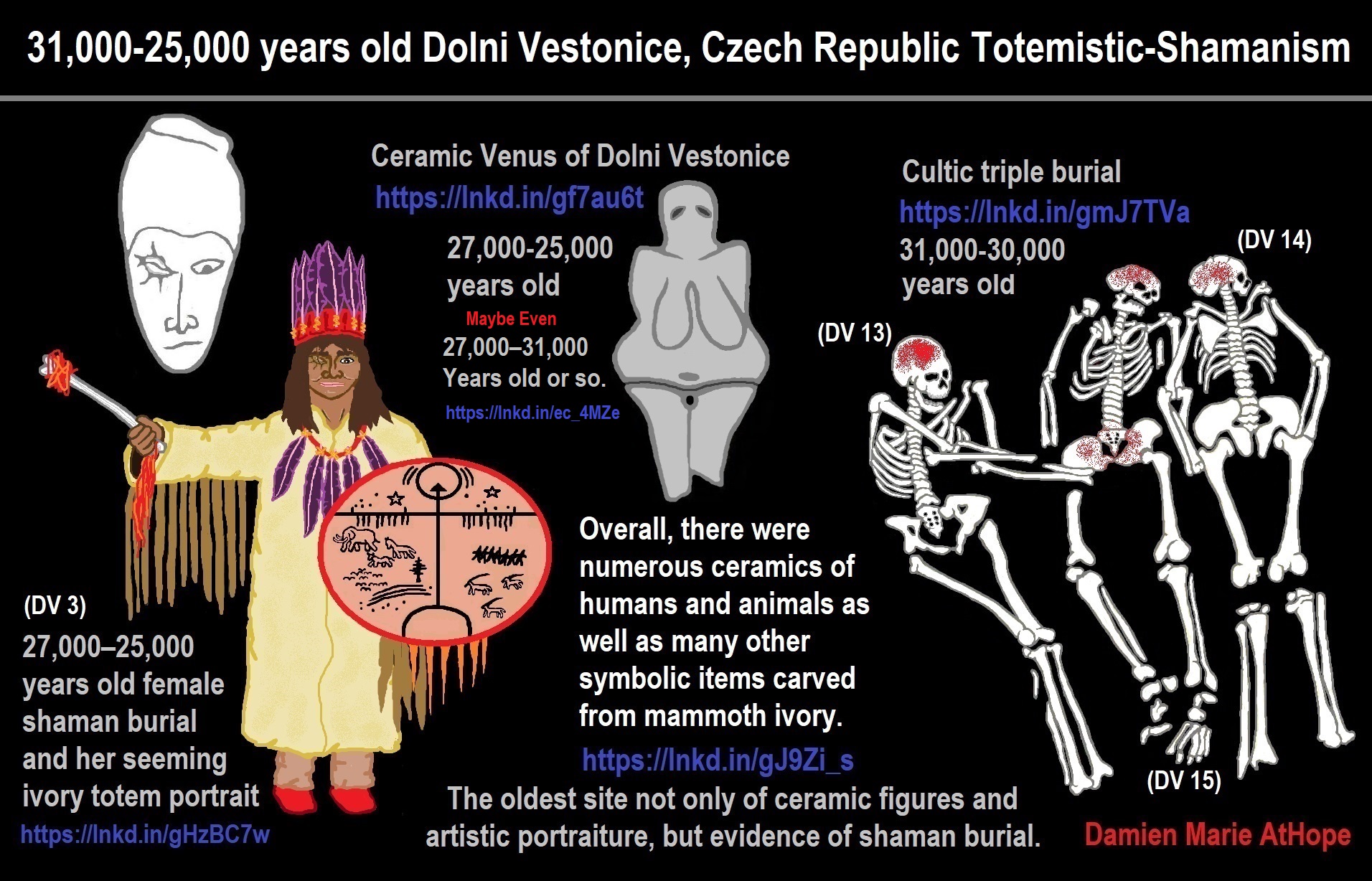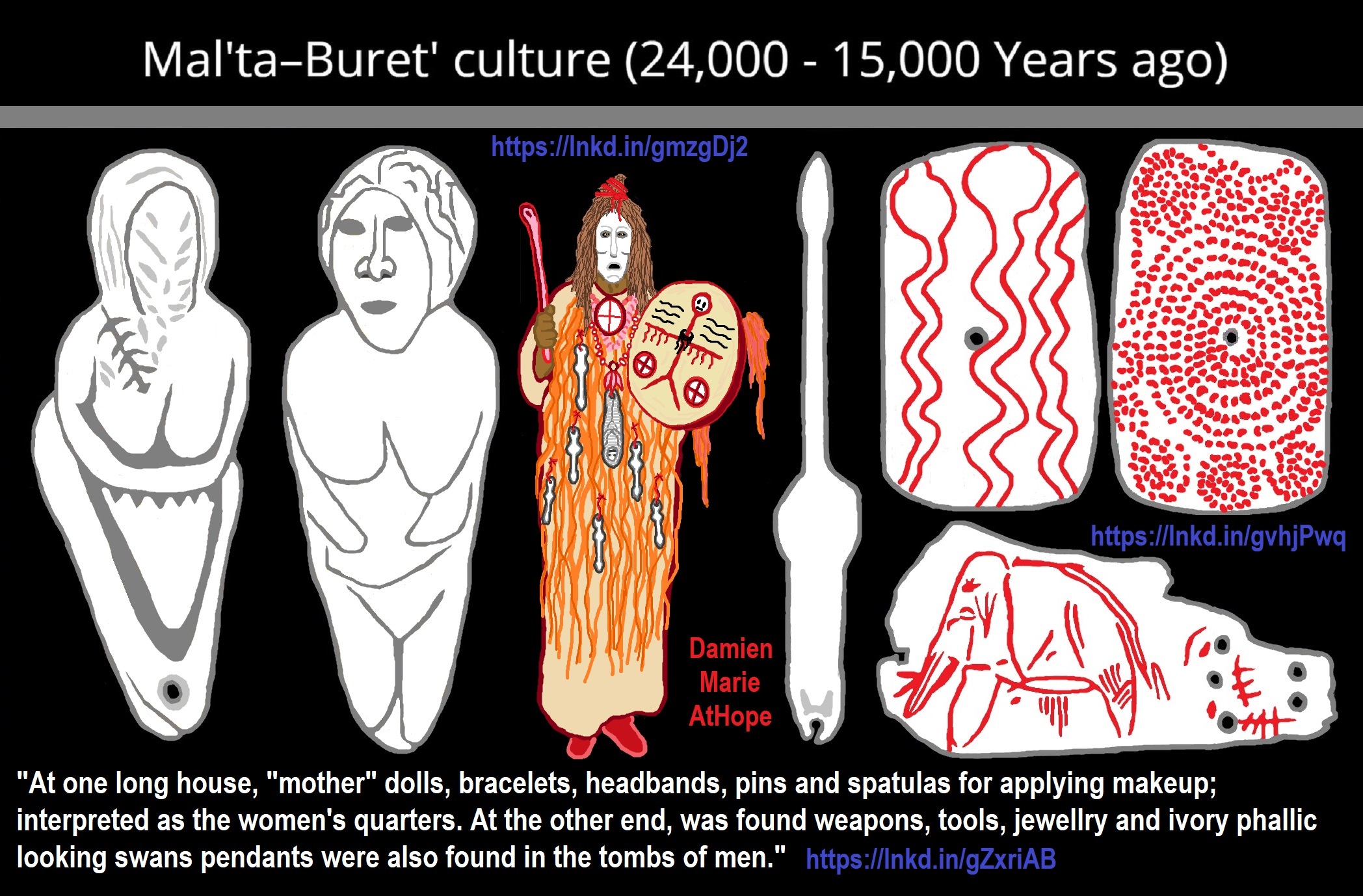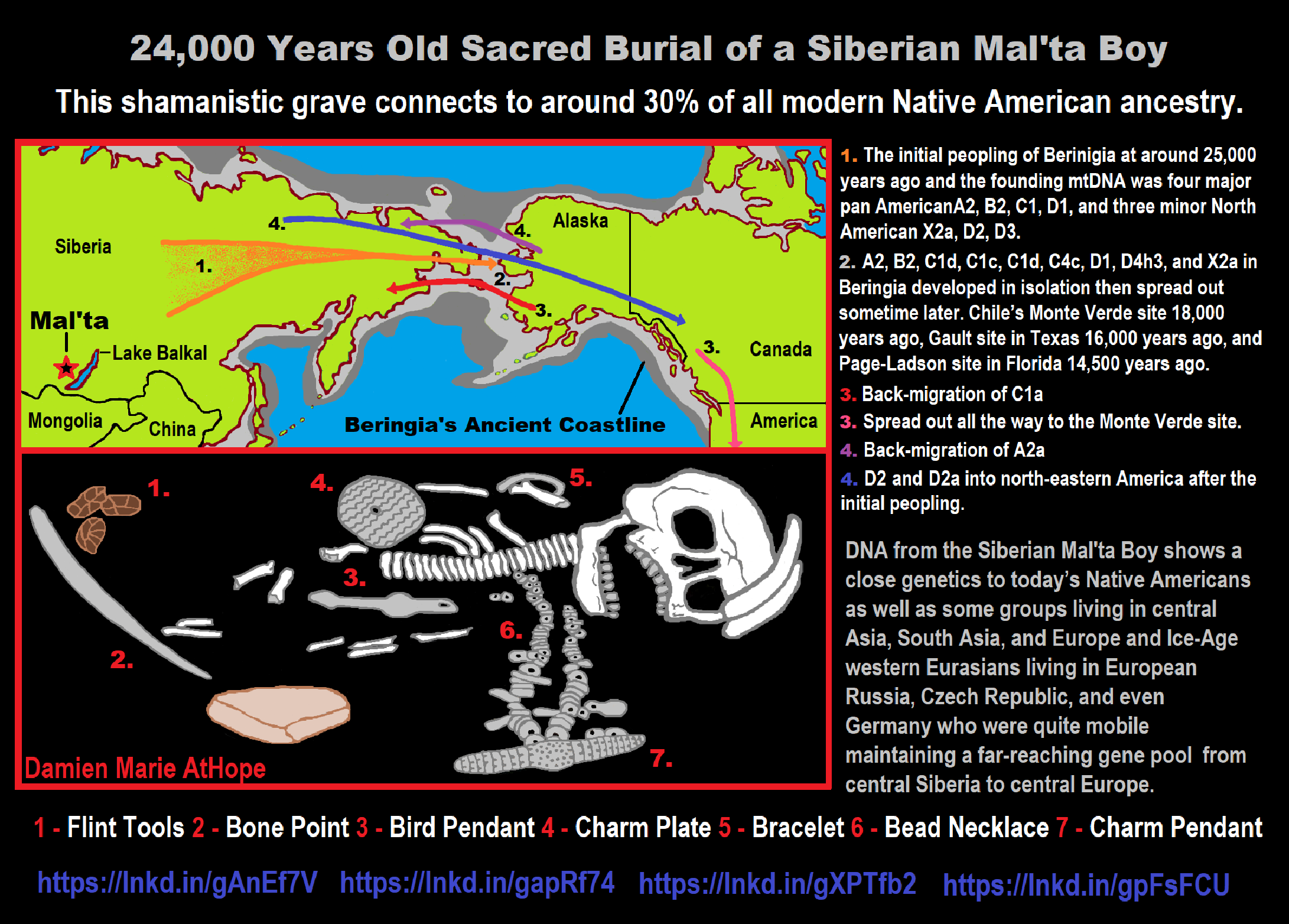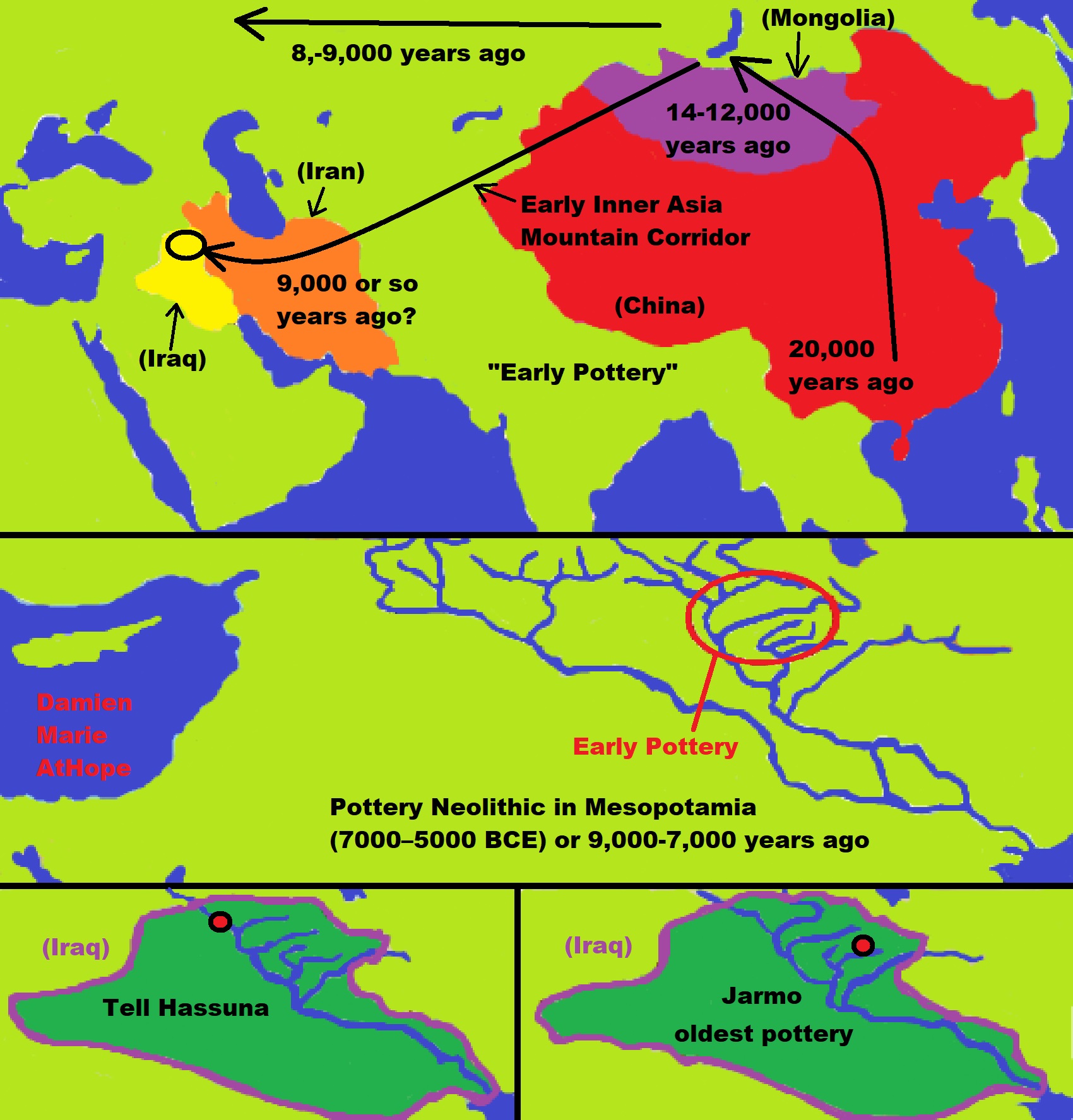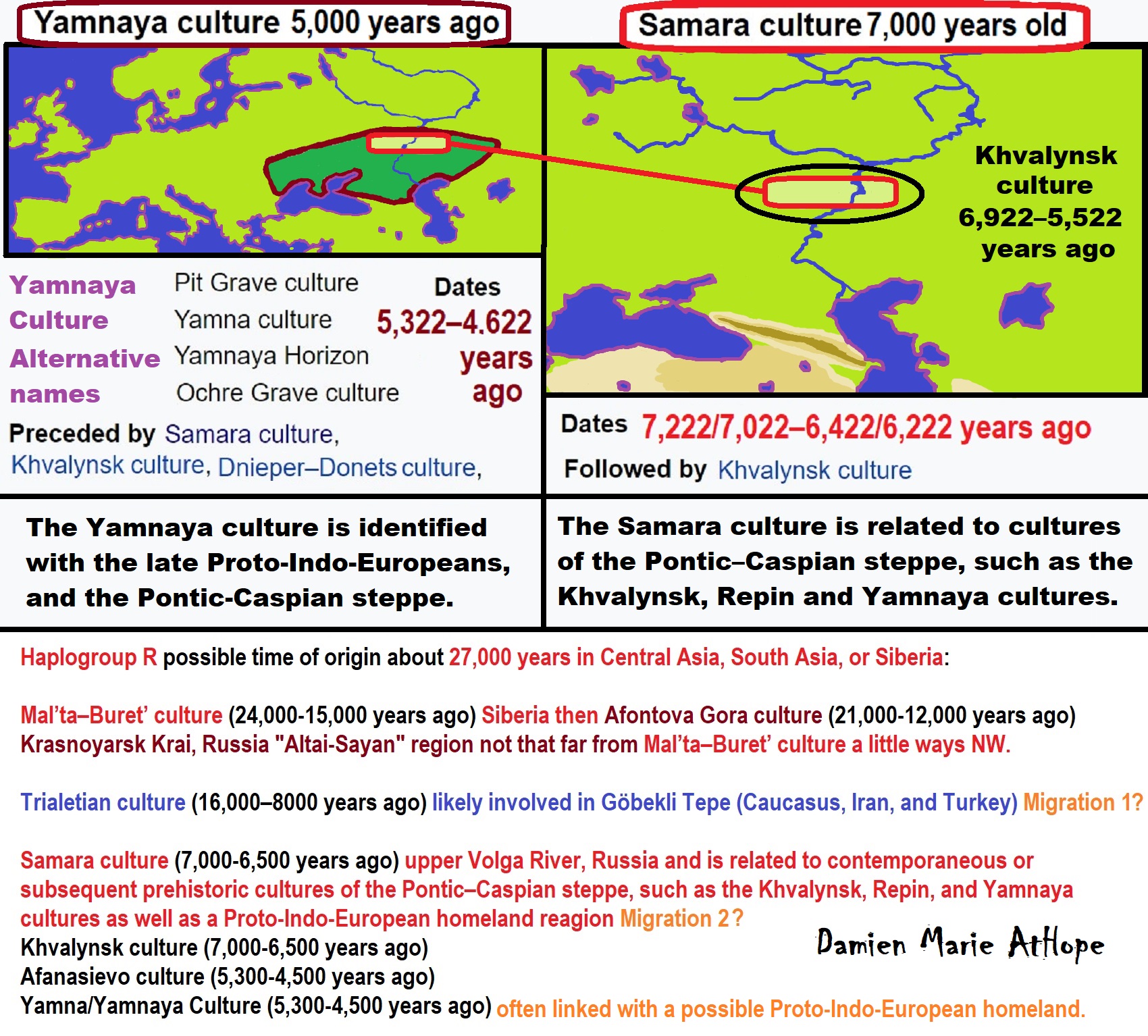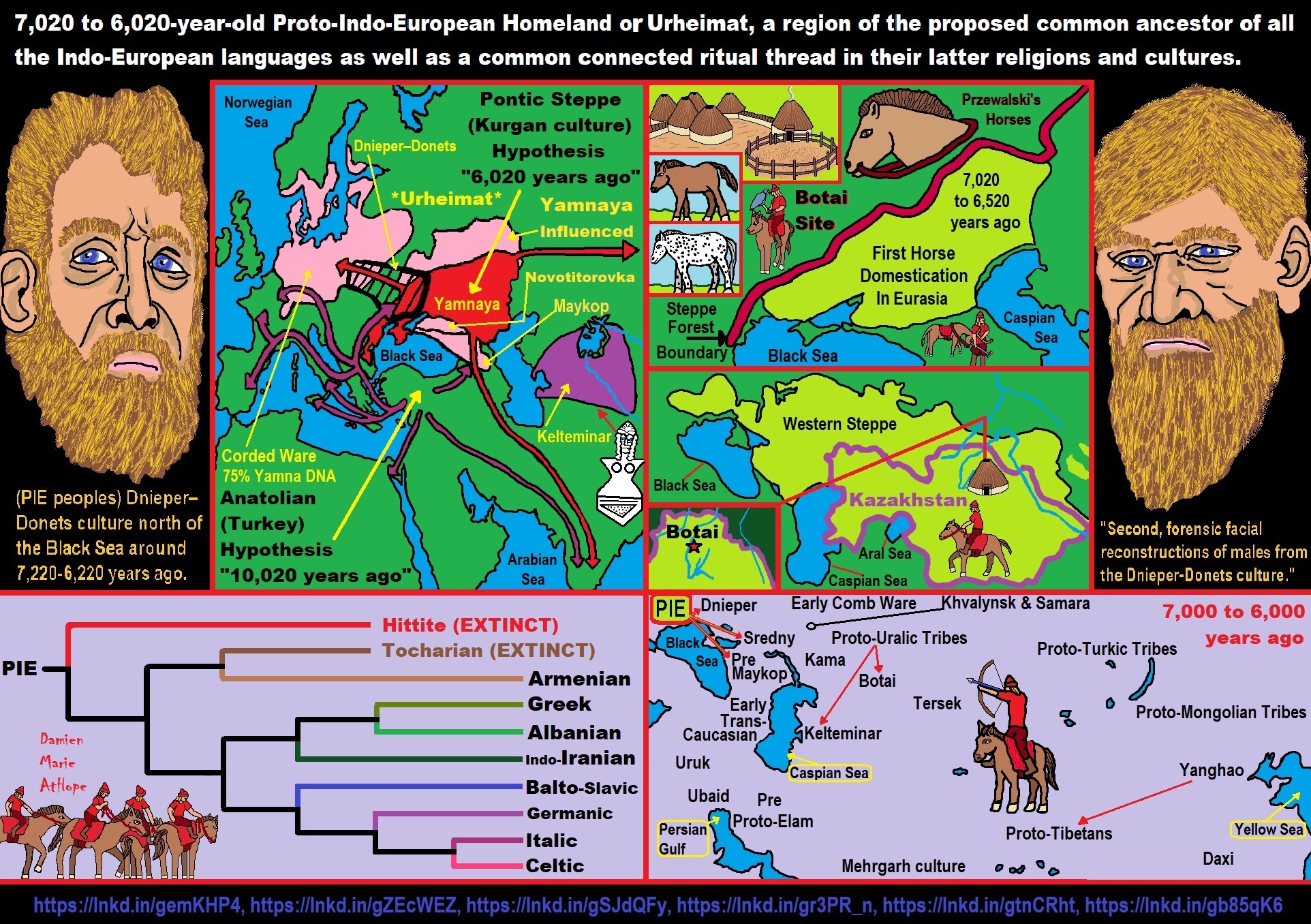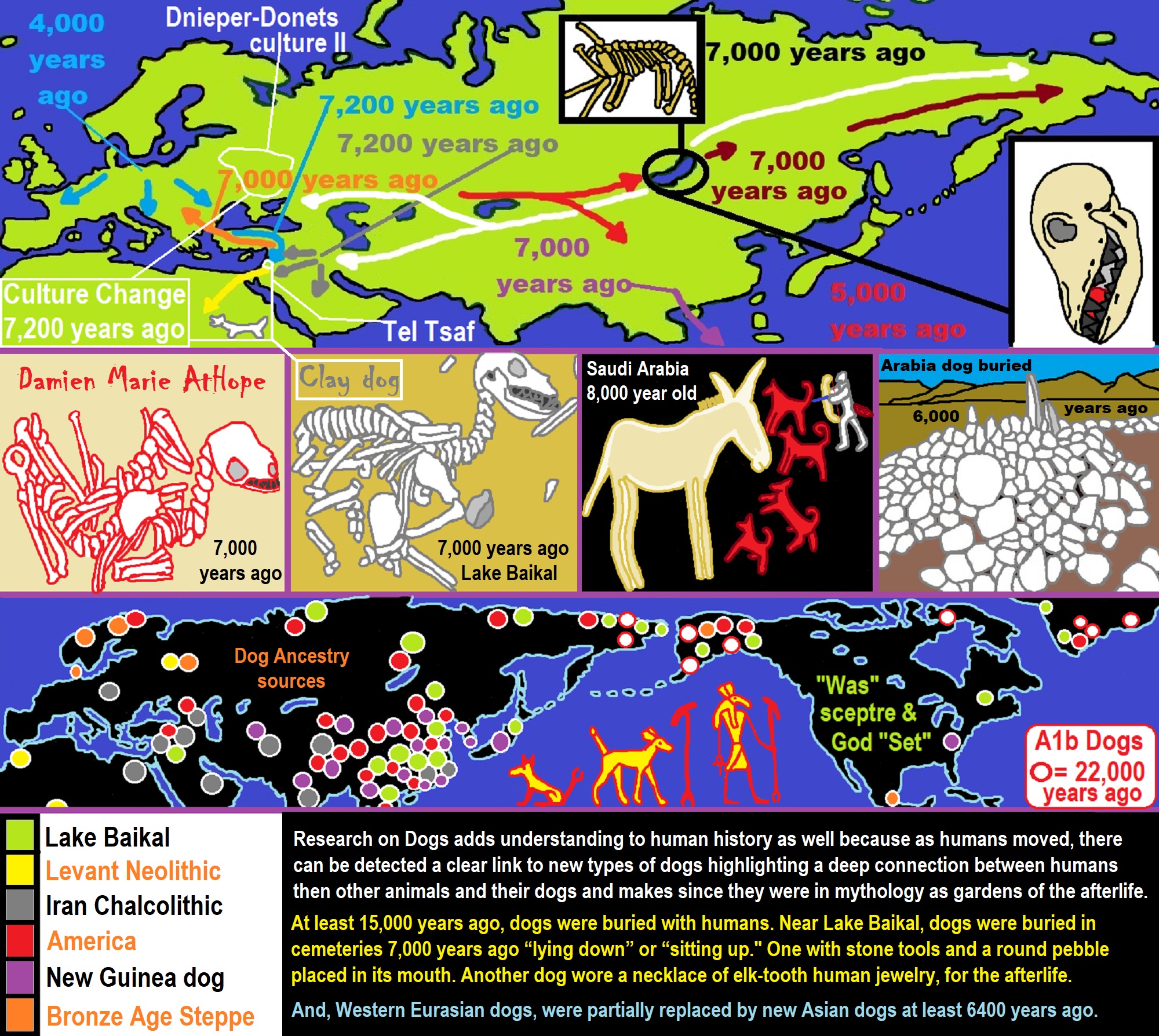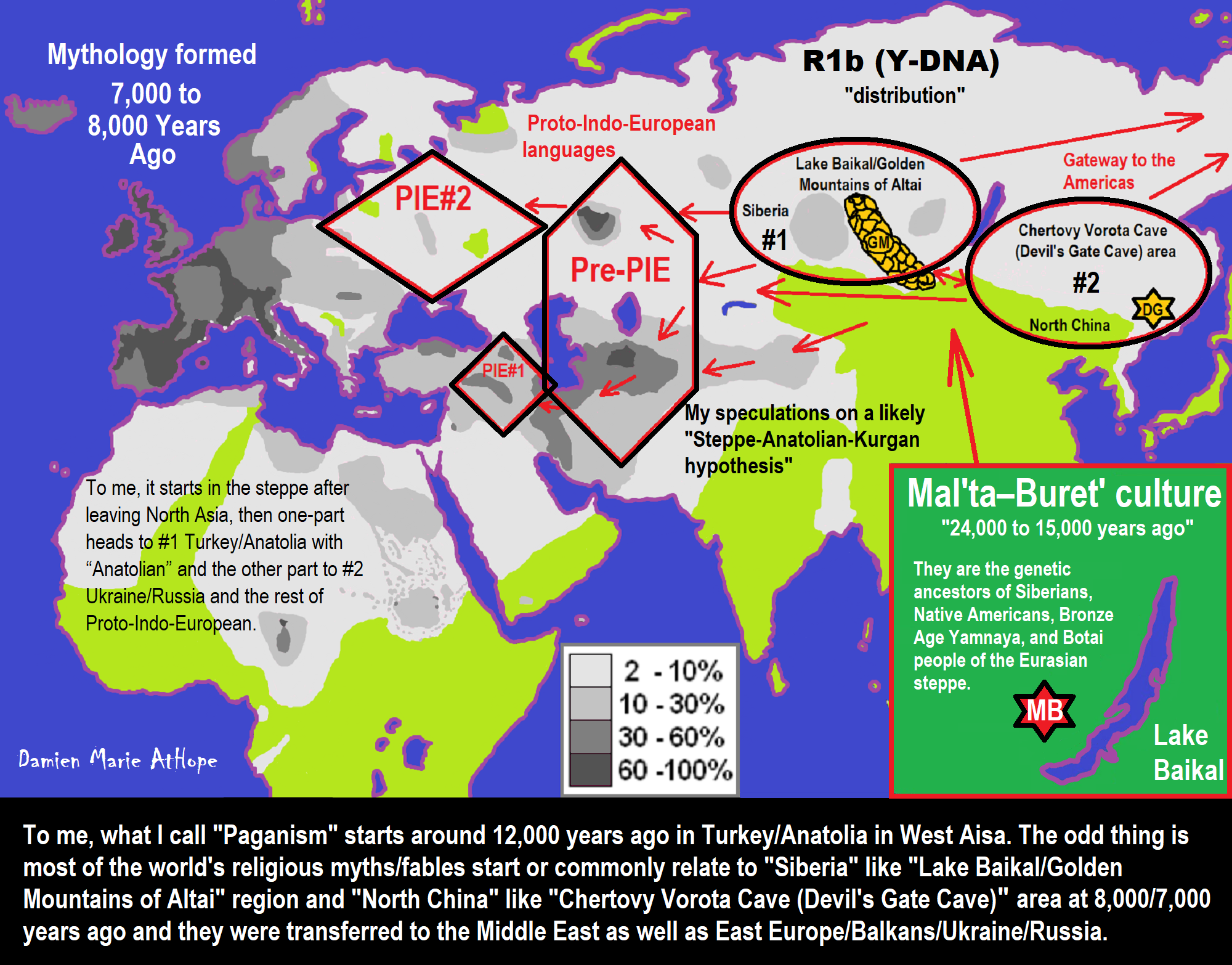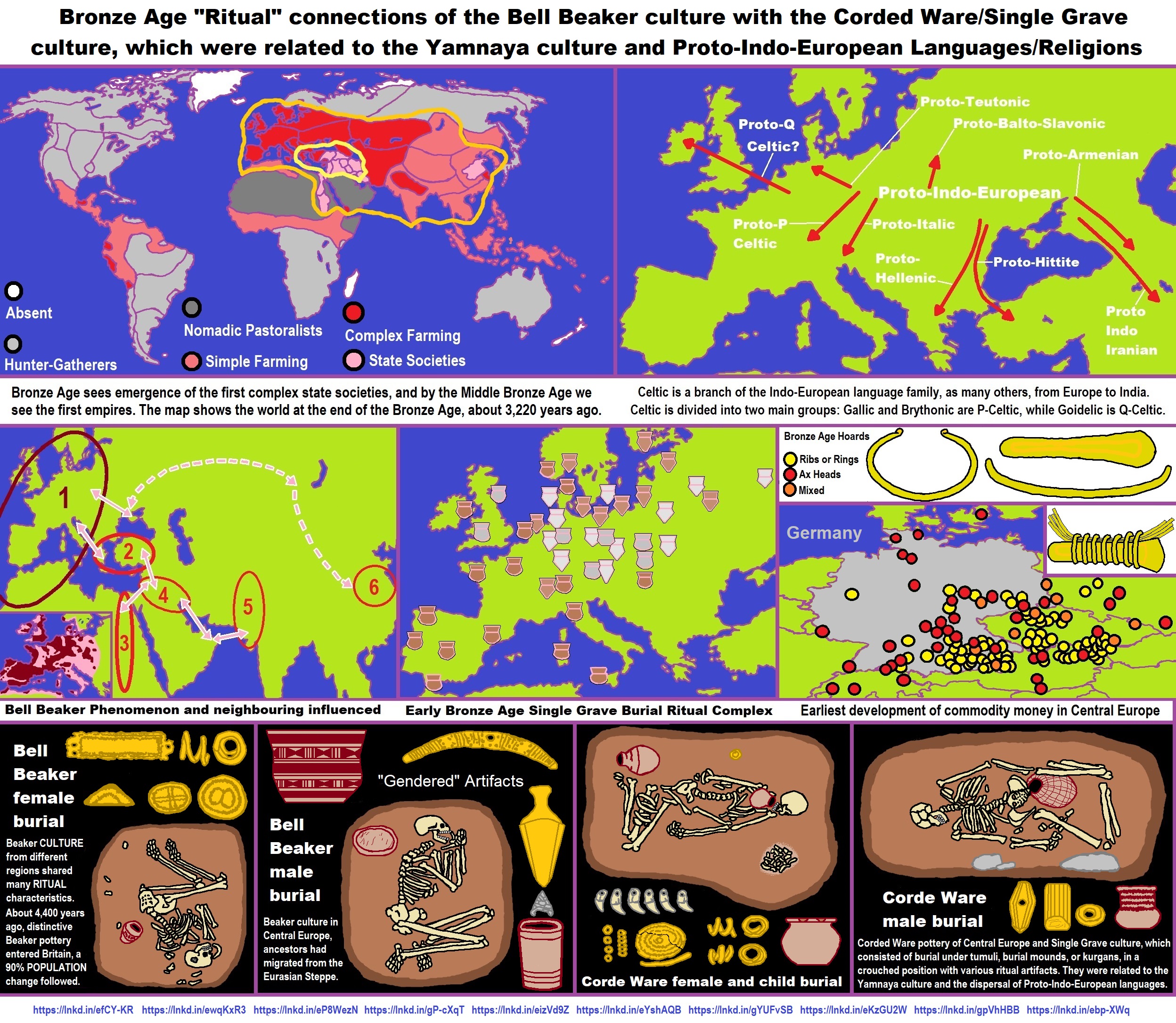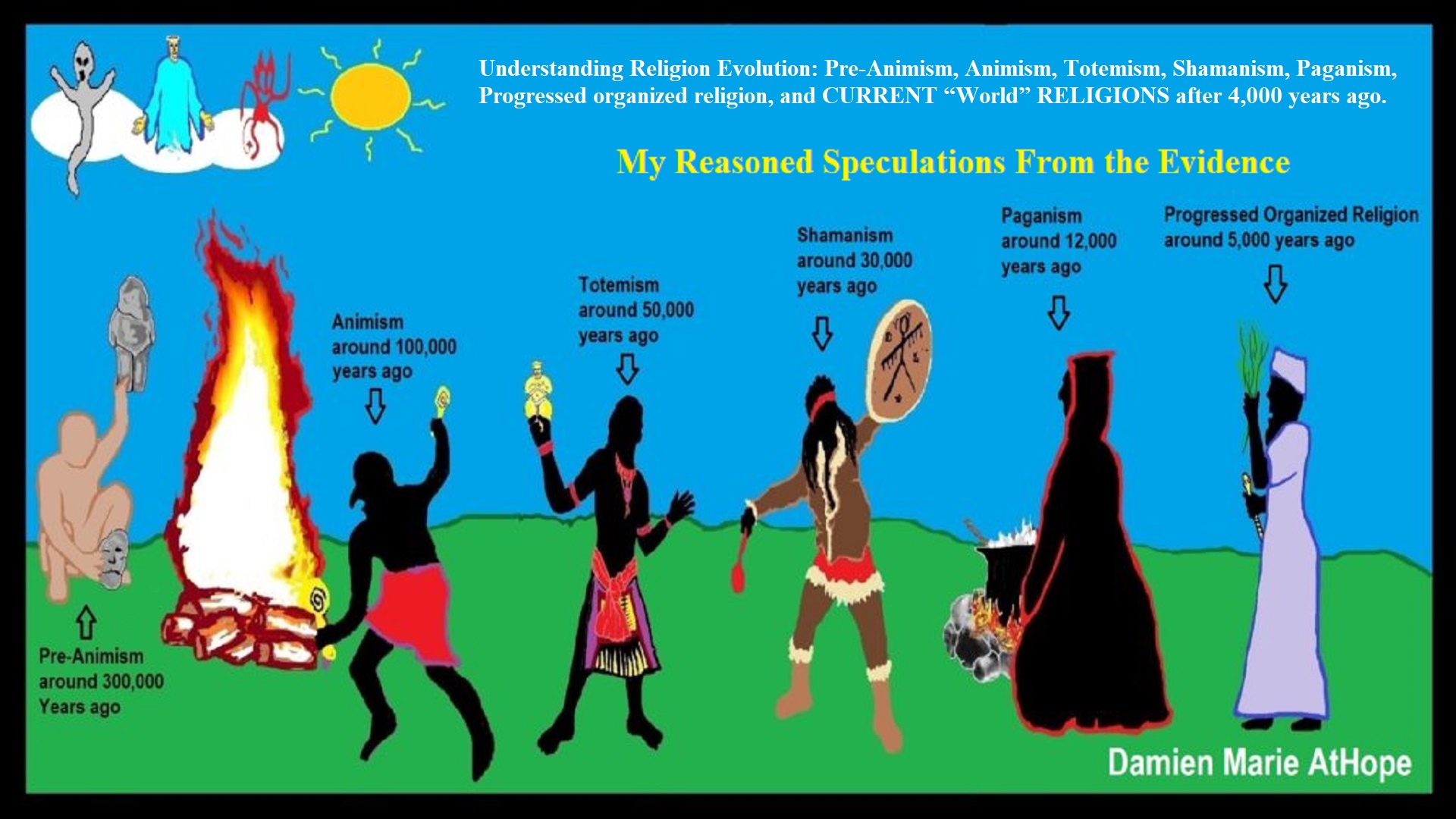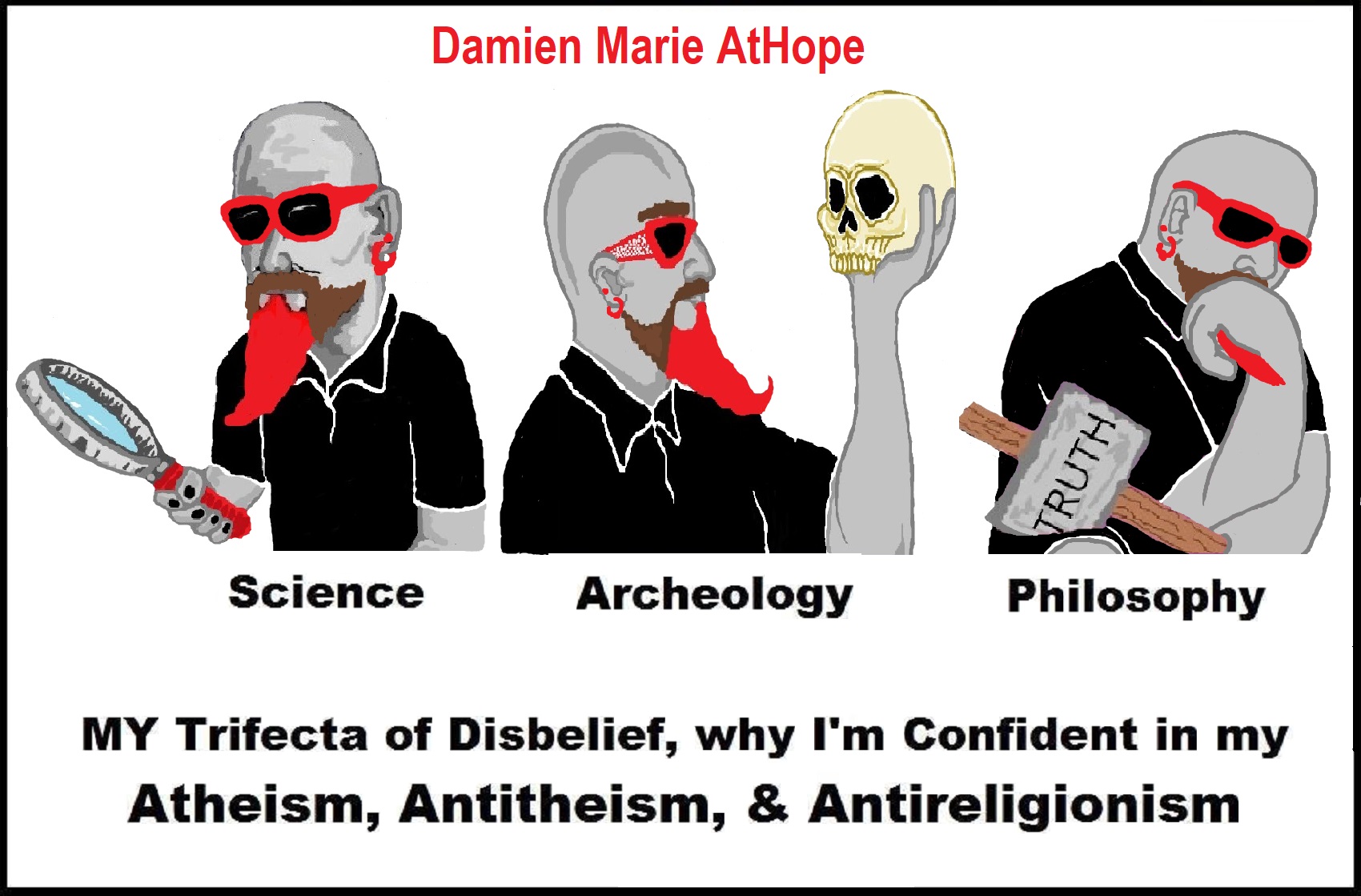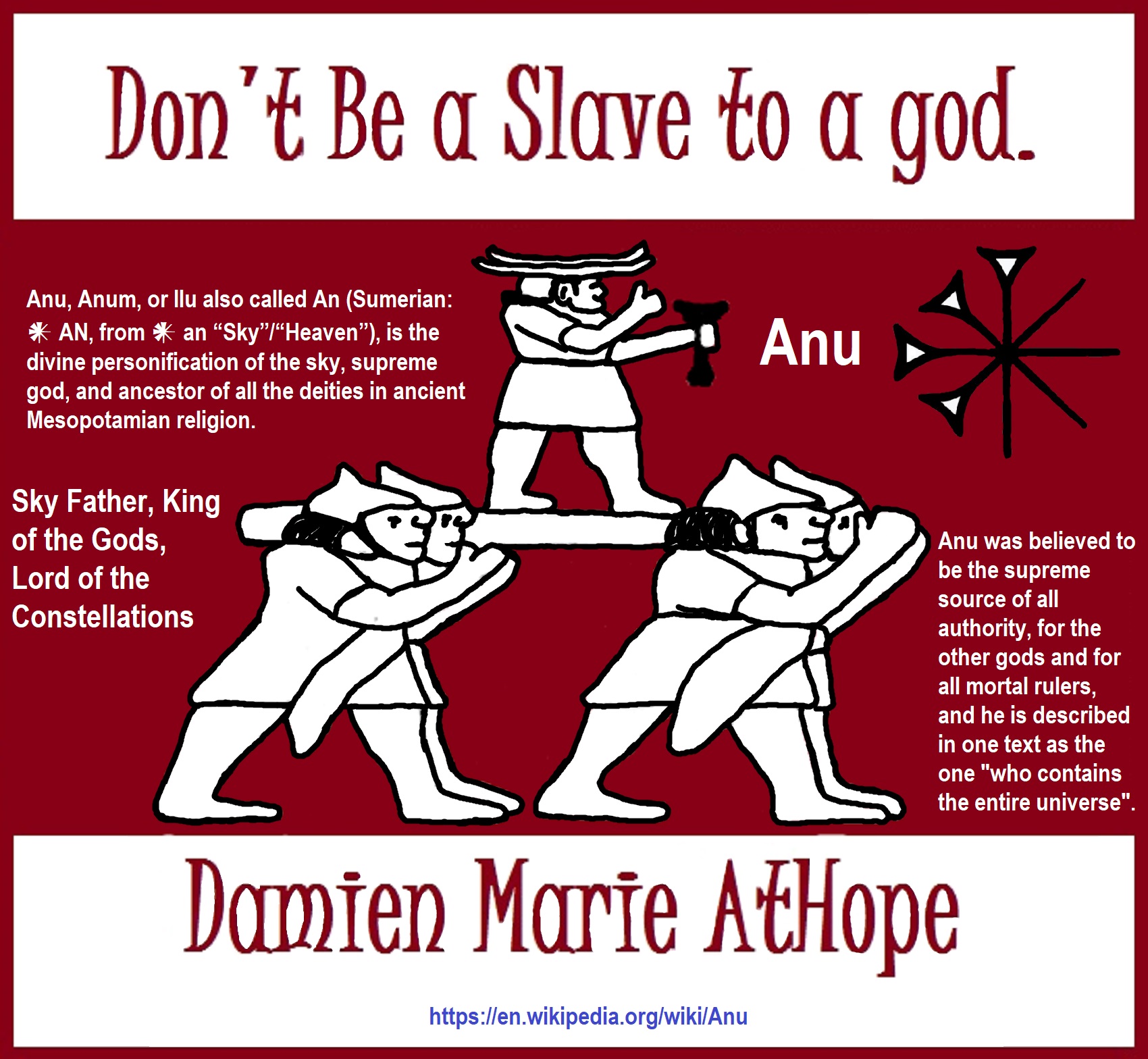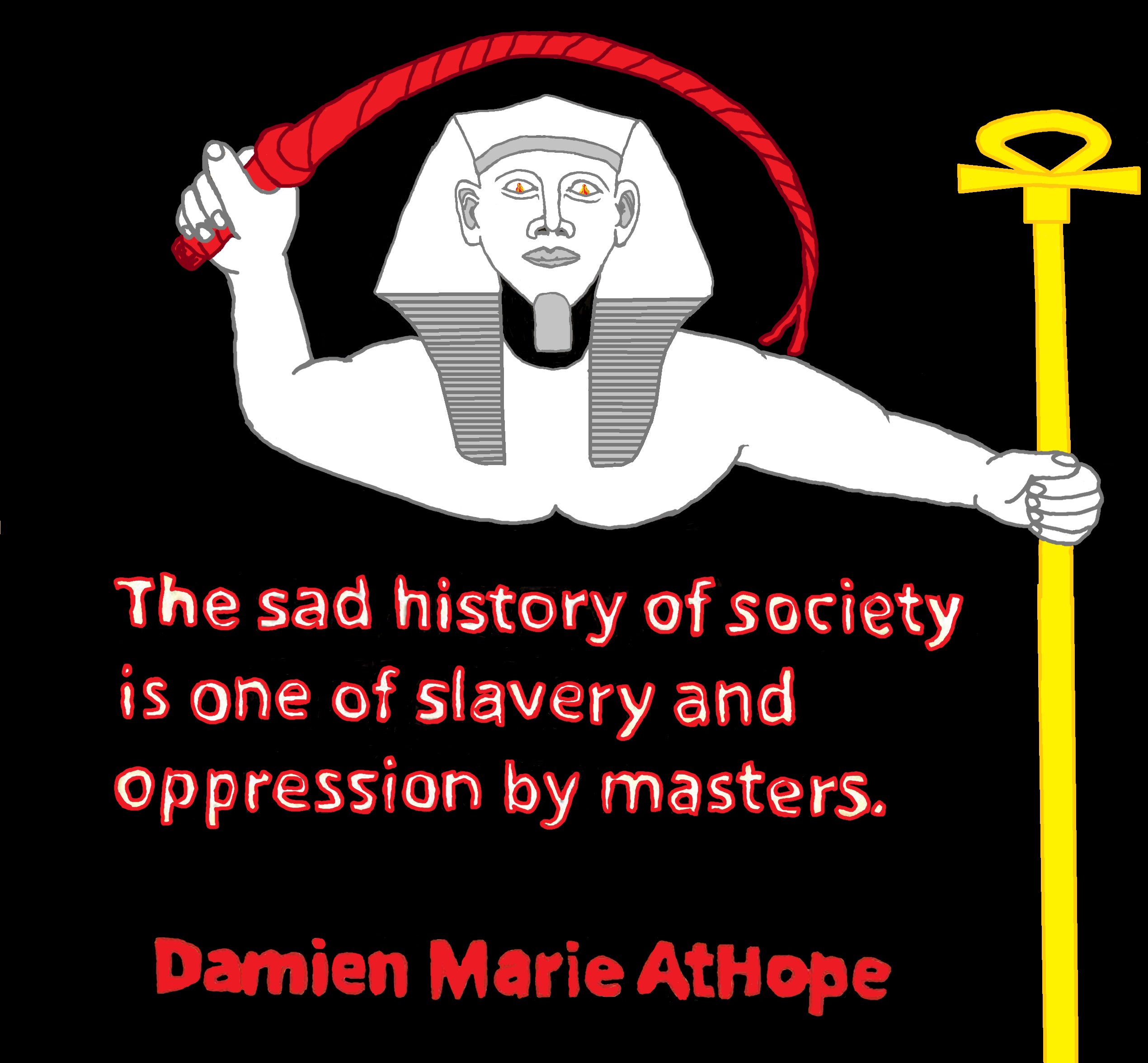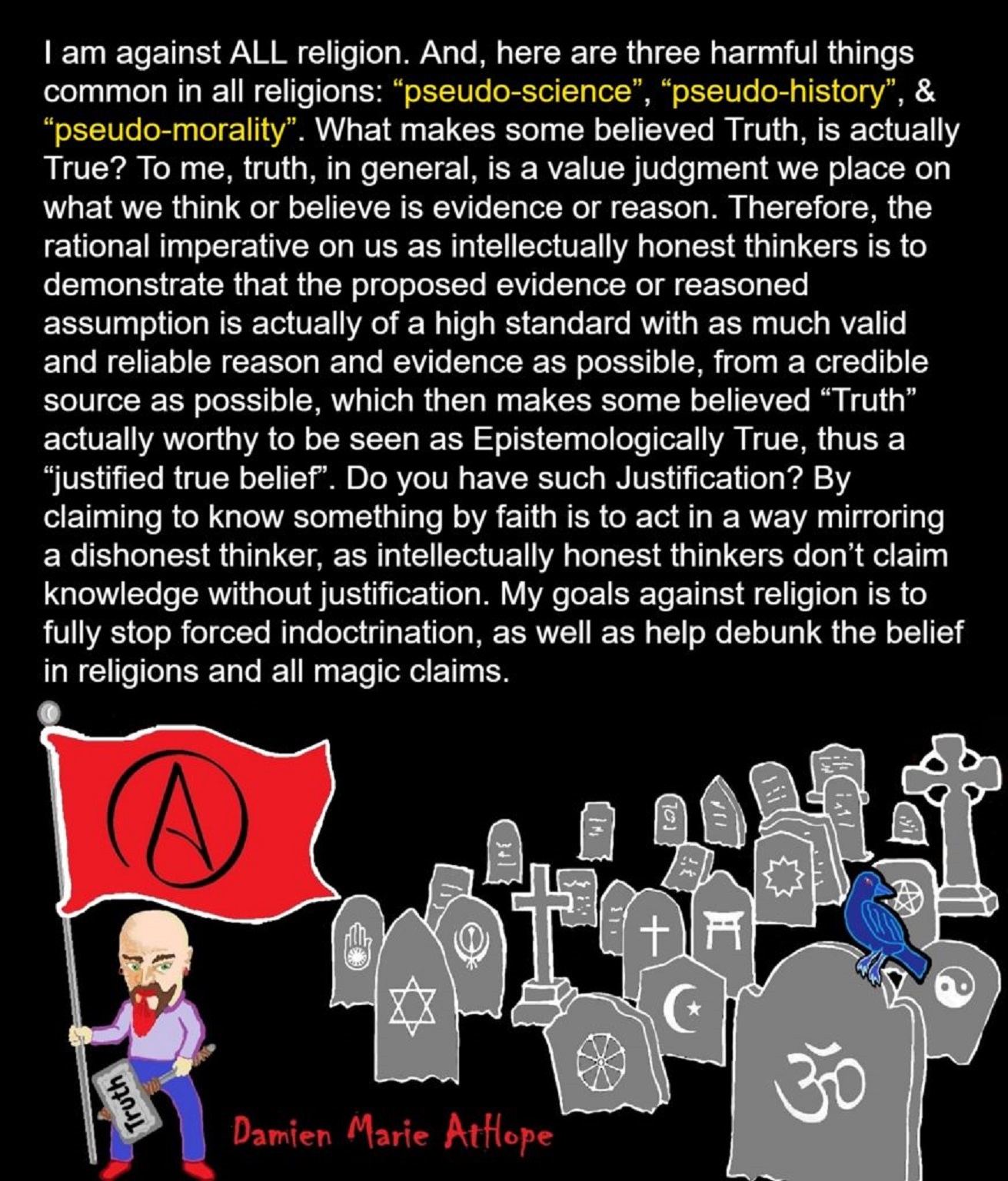
ref, ref, ref, ref, ref, ref, ref, ref, ref, ref, ref, ref, ref
Kostyonki (or Kostenki) (Archaeological Complex)
Tianyuan man (Tianyuan Cave 42,000 and 39,000 years old)
Gravettian Culture (known for Venus figurines)
Pavlovian culture (Art or religious finds are bone carvings and figurines of humans and animals)
Dolní Věstonice (archaeological site)
Ancient North Eurasian (ANE)
Mal’ta–Buret’ Culture (Mal’ta Venus figurines)
Afontova Gora (Siberian Complex of Archaeological sites)
Eastern Hunter-Gatherer (EHG)
Western Hunter-Gatherers (WHG)
Yamnaya Culture (Identified with the Late Proto-Indo-Europeans)
Who were the Groups migrating and merging with the previous Groups of Europe?
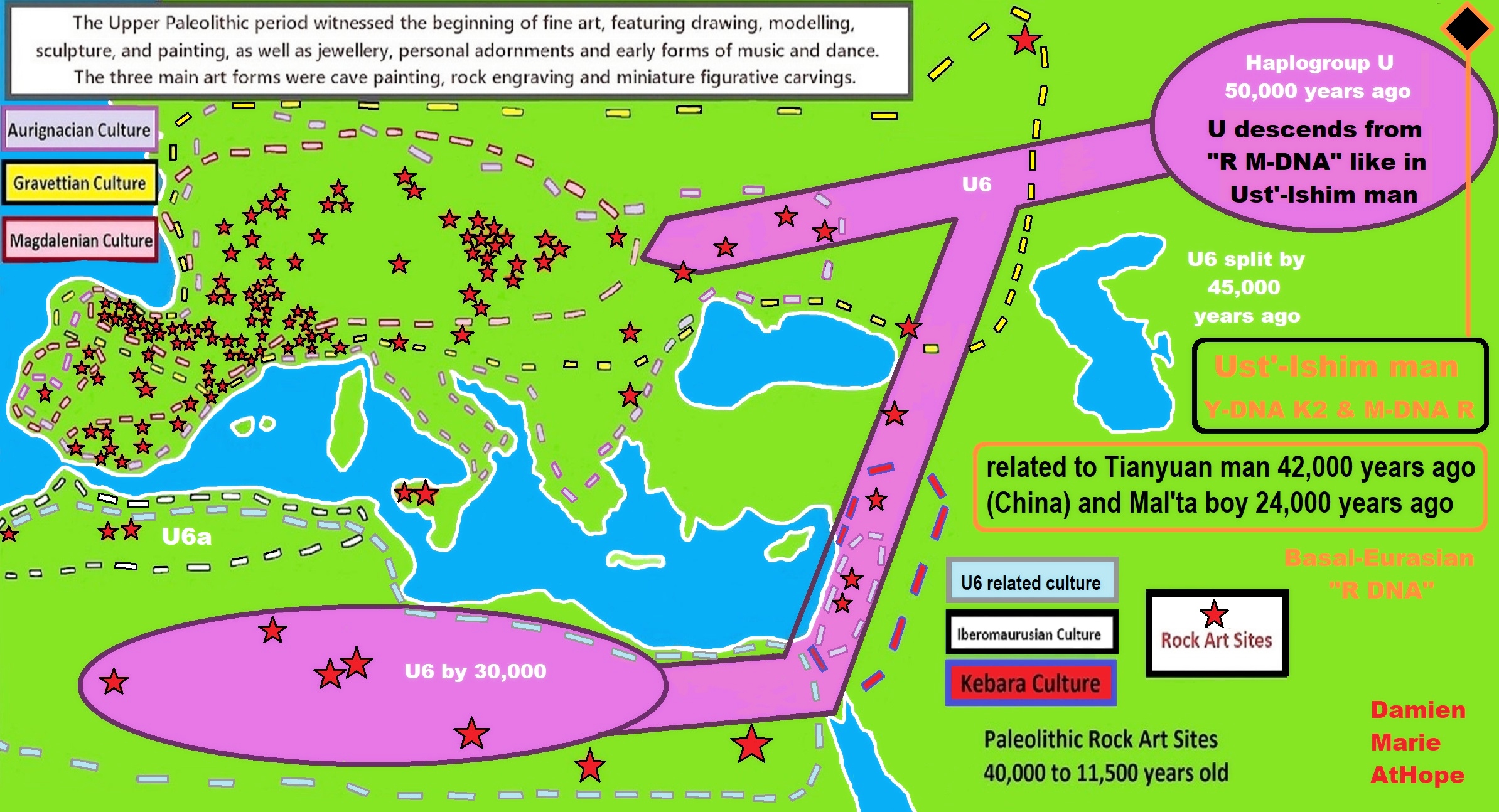

ref, ref, ref, ref, ref, ref, ref, ref, ref, ref, ref, ref, ref, ref, ref, ref, ref, ref, ref
Here are my thoughts/speculations on where I believe is the possible origin of shamanism, which may have begun sometime around 35,000 to 30,000 years ago seen in the emergence of the Gravettian culture, just to outline his thinking, on what thousands of years later led to evolved Asian shamanism, in general, and thus WU shamanism as well. In both Europe-related “shamanism-possible burials” and in Gravettian mitochondrial DNA is a seeming connection to Haplogroup U. And the first believed Shaman proposed burial belonged to Eastern Gravettians/Pavlovian culture at Dolní Věstonice in southern Moravia in the Czech Republic, which is the oldest permanent human settlement that has ever been found. It is at Dolní Věstonice where approximately 27,000-25,000 years ago a seeming female shaman was buried and also there was an ivory totem portrait figure, seemingly of her.
And my thoughts on how cultural/ritual aspects were influenced in the area of Göbekli Tepe. I think it relates to a few different cultures starting in the area before the Neolithic. Two different groups of Siberians first from northwest Siberia with U6 haplogroup 40,000 to 30,000 or so. Then R Haplogroup (mainly haplogroup R1b but also some possible R1a both related to the Ancient North Eurasians). This second group added its “R1b” DNA of around 50% to the two cultures Natufian and Trialetian. To me, it is likely both of these cultures helped create Göbekli Tepe. Then I think the female art or graffiti seen at Göbekli Tepe to me possibly relates to the Epigravettians that made it into Turkey and have similar art in North Italy. I speculate that possibly the Totem pole figurines seen first at Kostenki, next went to Mal’ta in Siberia as seen in their figurines that also seem “Totem-pole-like”, and then with the migrations of R1a it may have inspired the Shigir idol in Russia and the migrations of R1b may have inspired Göbekli Tepe.


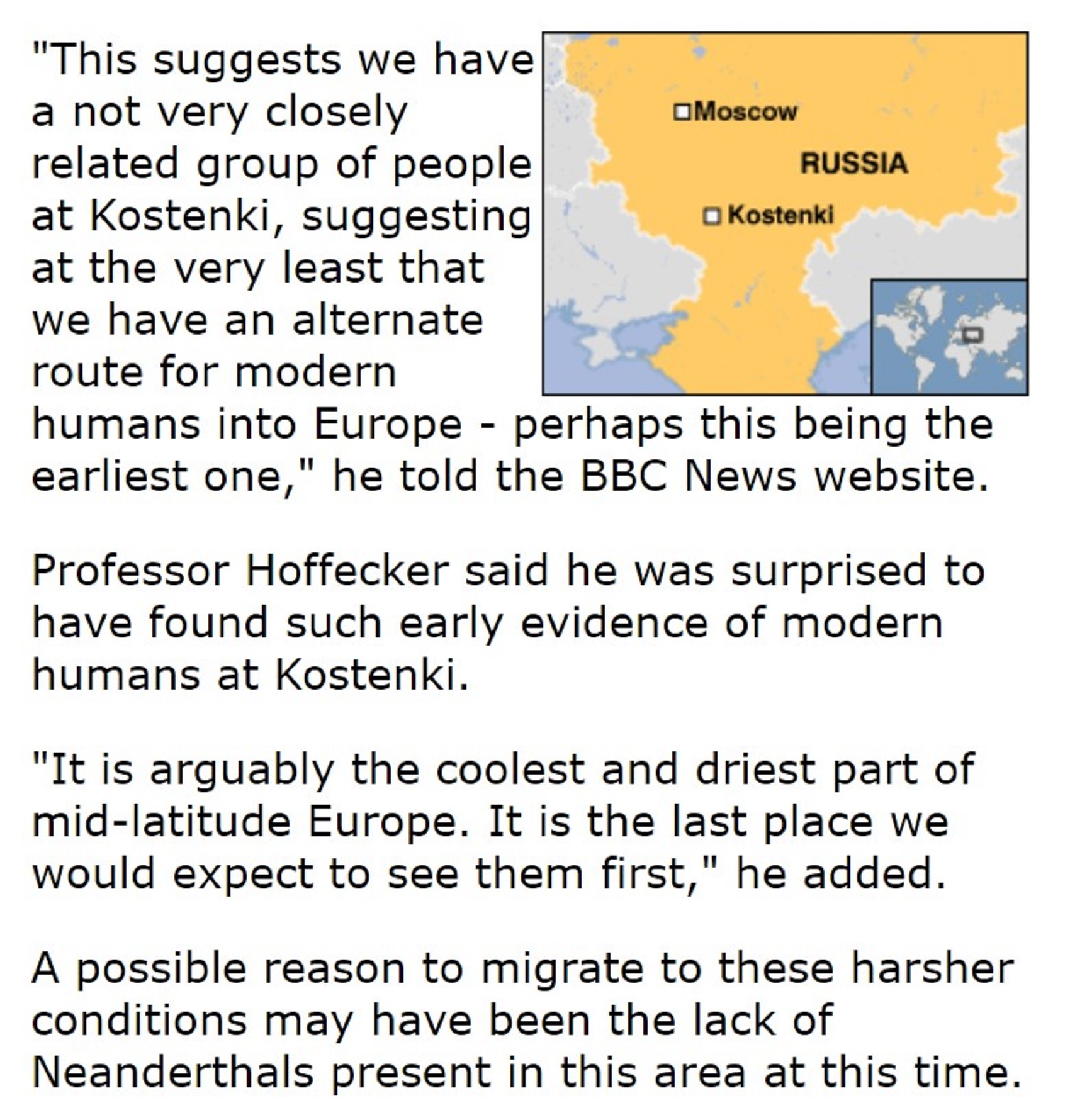
Pic ref
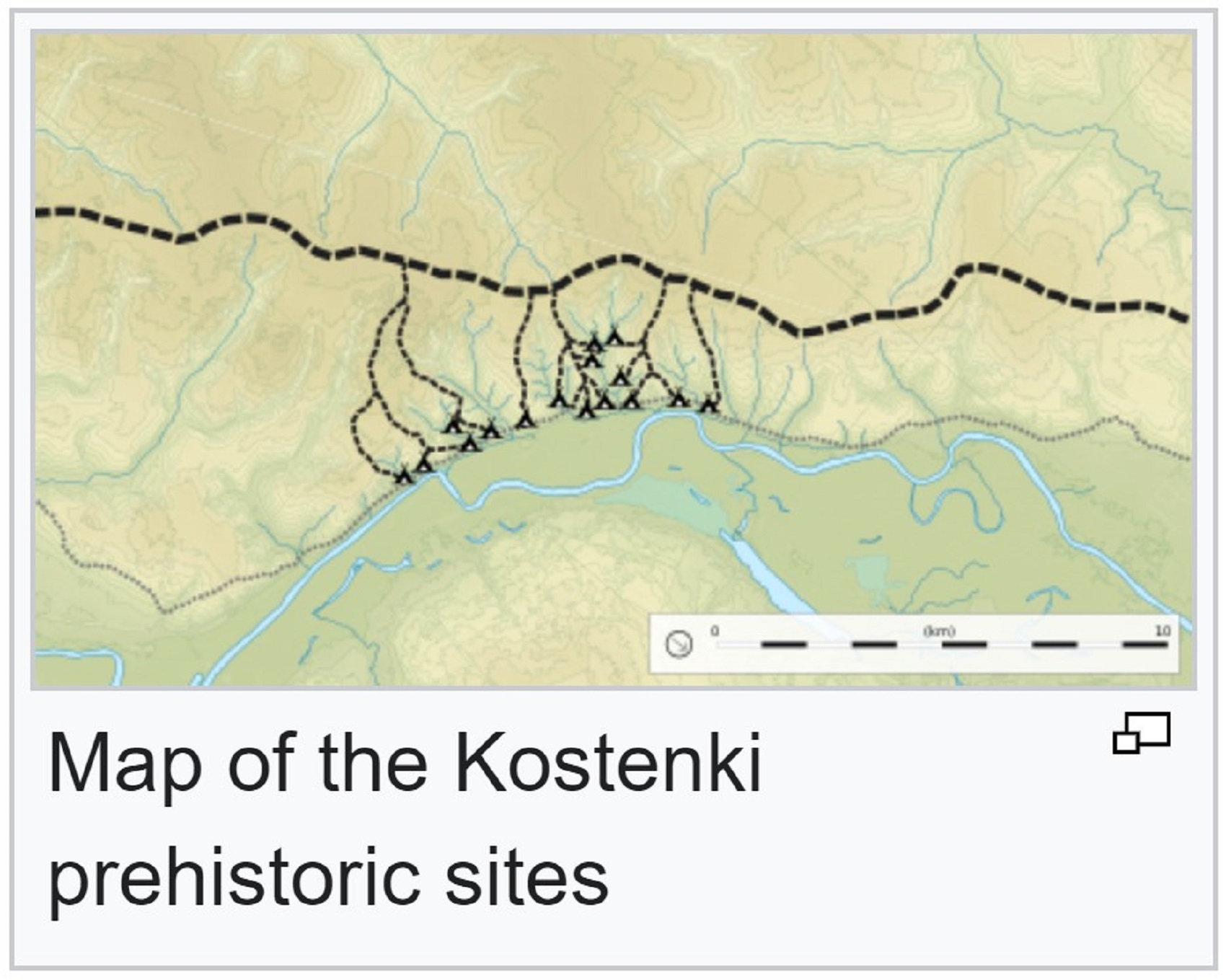
Pic ref
“The Kostyonki–Borshchyovo archaeological complex is an area where numerous Upper Paleolithic archaeological sites have been found, located around the villages of Kostyonki (also Kostenki) and Borshchyovo (also Borshchevo). The area is found on the western (right) bank of the Don River in Khokholsky District, Voronezh Oblast, Russia, some 25 km south of the city of Voronezh. The 26 Paleolithic sites of the area are numbered Kostenki 1–21 and Borshchevo 1–5. It is known for its high concentration of cultural remains of anatomically modern humans from the beginning of the Upper Paleolithic era, before 40,000 years ago. Finds are on exhibit in situ, at the State Archaeological Museum–Reserve Kostyonki built atop the mammoth bone circle Kostenki 11.” ref
“Kostenki-1 was excavated by I. S. Polyakov (1845–1887) in 1879. Further excavations from 1881 to 1915 were mostly searching for stone tools. Systematic excavations were performed from the 1920s, most notably those led by P.P. Efimenko from 1923 to 1938. In the second half of the 20th century, it was recognized that there were other sites in the neighborhood, now labeled Kostenki-1 to Kostenki-21 and Borshchevo-1 to Borshchevo-5. The most famous of these are Kostenki-12 (Volkovska) and Kostenki-14 (Markina Gora). A 25,000-year-old bone circle structure of at least 60 mammoths, measuring over 12.5 meters (41 ft) in diameter, was discovered at Kostenki in 2020.” ref
“Kostenki-1/2 (site Kostenki-1, layer 2), Kostenki-1/3, Kostenki-6 (Streletskaya), Kostenki-11, and Kostenki 12/3 below the volcanic CI tephra layer are associated to the nontransitional local “Strelets culture”, analogous to early Upper Paleolithic cultures from central and western Europe such as the Szeletian culture. This initial cultural development might be attributable to local Neanderthals. Ornaments predating the volcanic eruption, found at Kostenki 17/2 (“Spitsyn culture”, 38,022–32,022 years ago), were apparently perforated by a hand-operated rotary drill or drills; these may suggest that the population was technologically capable of preparing for a volcanic winter. Just above the ash layer sewing needles were found. Kostenki 1/1, Kostenki 4/2, Kostyonki 8/2 and Kostenki 21/3 belong to the eastern Gravettian (24,022 to 22,022 years ago). Kostenki 2, Kostenki 3, Kostenki 11-1a and Kostenki-19 belong to the Zamyatino culture (22,022 to 17,022 years ago). Kostenki 8/2 (Telmanskaya) is eponymous of “Telman culture.” ref


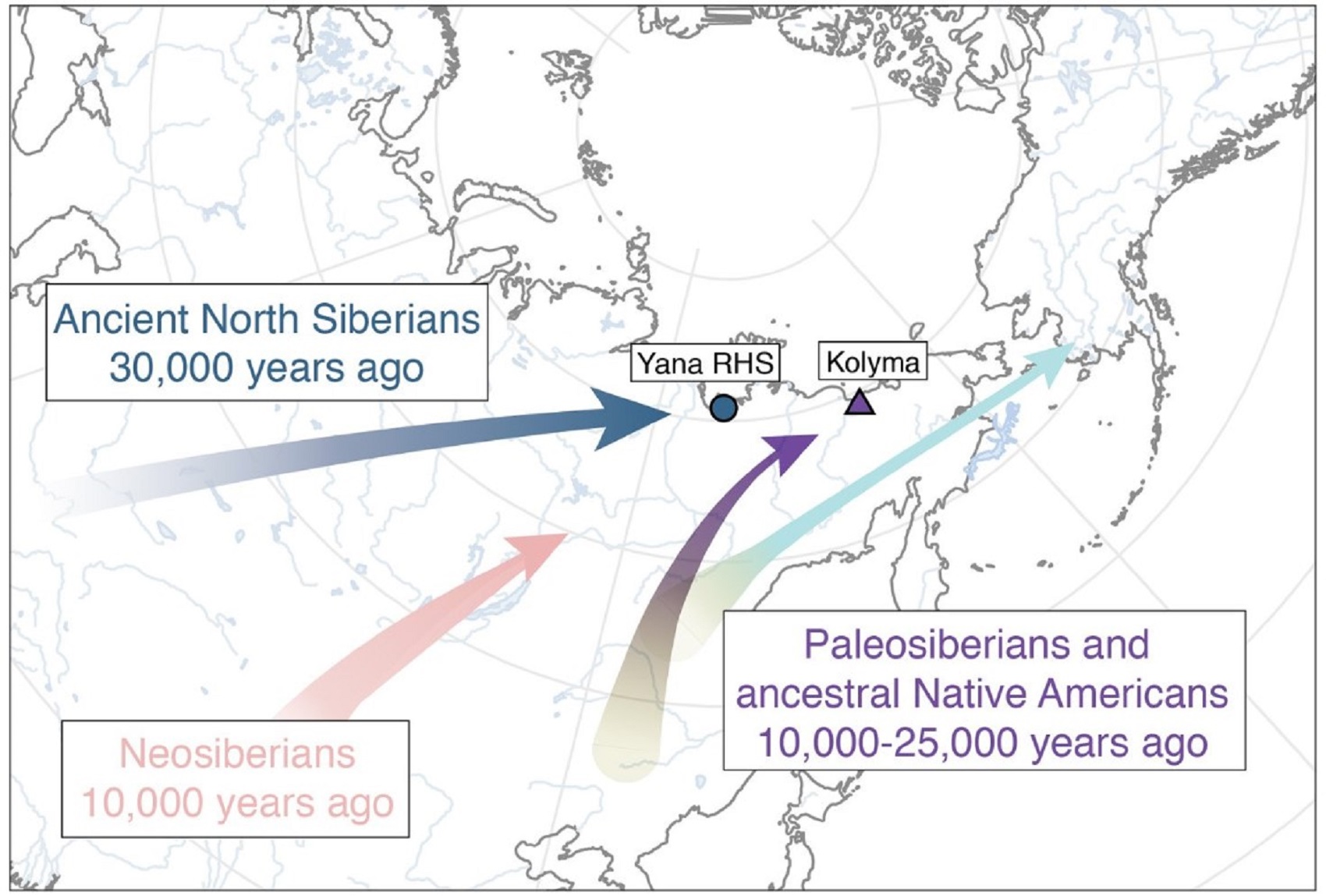
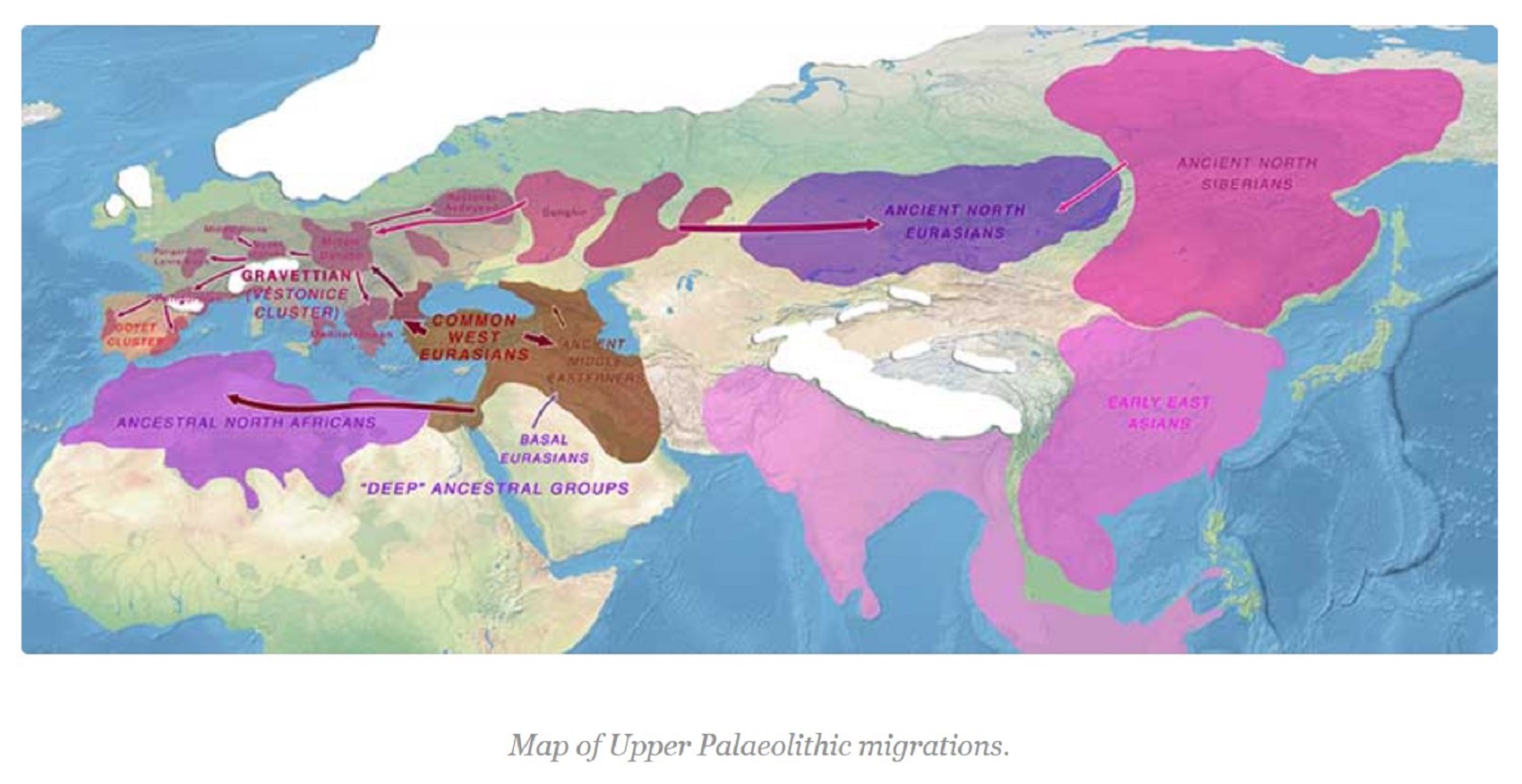
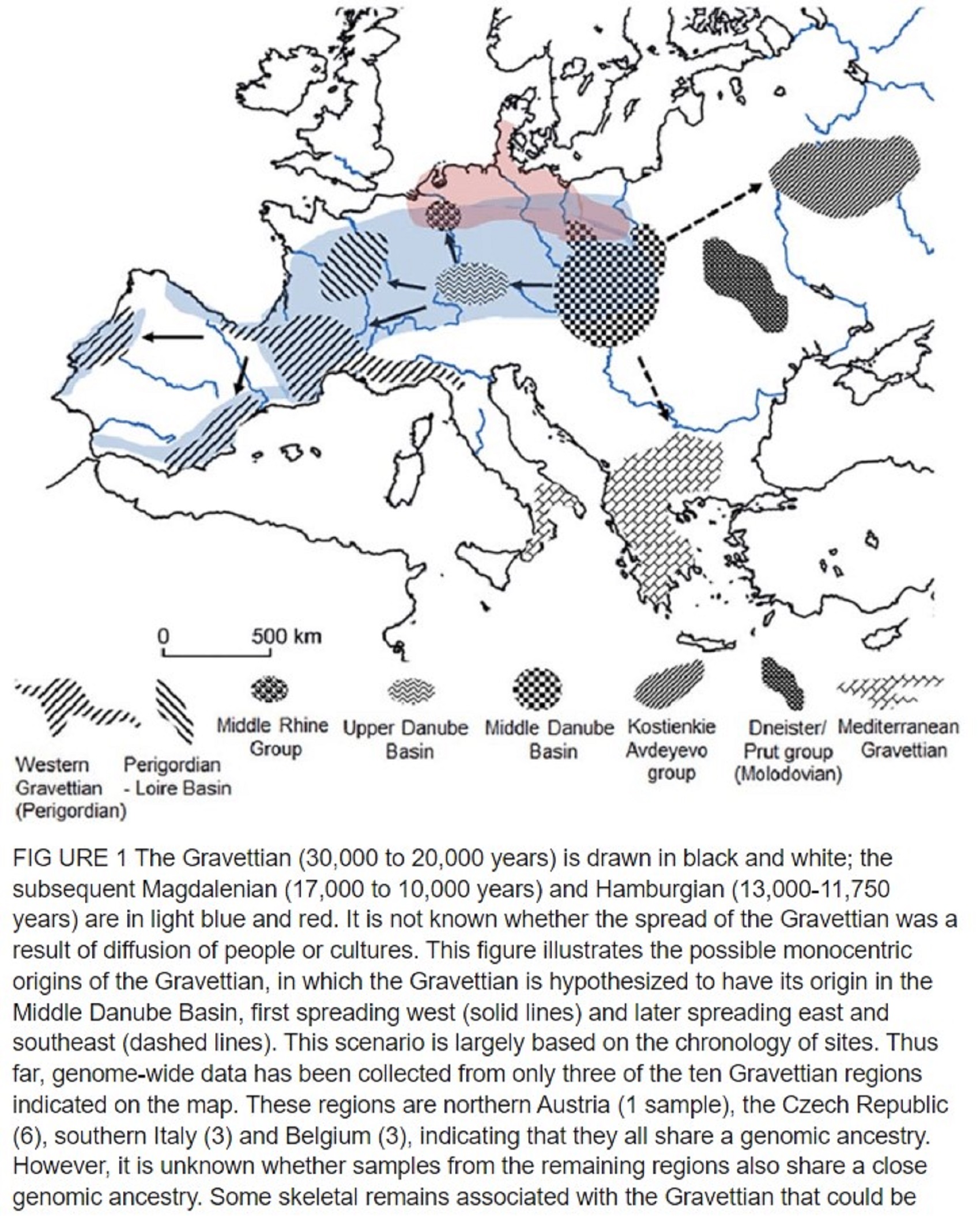
Pic ref
“The Gravettian (30,000 to 20,000 years) is drawn in black and white; the subsequent Magdalenian (17,000 to 10,000 years) and Hamburgian (13,000-11,750 years) are in light blue and red. It is not known whether the spread of the Gravettian was a result of the diffusion of people or cultures.” ref
Gravettian culture
“The Gravettian was an archaeological industry of the European Upper Paleolithic that succeeded the Aurignacian circa 33,022 years ago. It is archaeologically the last European culture many consider unified, and had mostly disappeared by c. 22,022 years ago, close to the Last Glacial Maximum, although some elements lasted until c. 17,022 years ago. In Spain and France, it was succeeded by the Solutrean, and developed into or continued as the Epigravettian in Italy, the Balkans, Ukraine, and Russia. The Gravettian culture is known for Venus figurines, which were typically carved from either ivory or limestone. The culture was first identified at the site of La Gravette in the southwestern French department of Dordogne.” ref
“The Gravettians were hunter-gatherers who lived in a bitterly cold period of European prehistory, and the Gravettian lifestyle was shaped by the climate. Pleniglacial environmental changes forced them to adapt. West and Central Europe were extremely cold during this period. Archaeologists usually describe two regional variants: the western Gravettian, known mainly from cave sites in France, Spain, and Britain, and the eastern Gravettian in Central Europe and Russia. The eastern Gravettians, which include the Pavlovian culture, were specialized mammoth hunters, whose remains are usually found not in caves but in open-air sites.” ref
“Gravettian culture thrived on their ability to hunt animals. They utilized a variety of tools and hunting strategies. Compared to theorized hunting techniques of Neanderthals and earlier human groups, Gravettian hunting culture appears much more mobile and complex. They lived in caves or semi-subterranean or rounded dwellings which were typically arranged in small “villages”. Gravettians are thought to have been innovative in the development of tools such as blunted-back knives, tanged arrowheads, and boomerangs. Other innovations include the use of woven nets and oil lamps made of stone. Blades and bladelets were used to make decorations and bone tools from animal remains.” ref
“Gravettian culture extends across a large geographic region, as far as Estremadura in Portugal. but is relatively homogeneous until about 27,022 years ago. They developed burial rites, which included the inclusion of simple, purpose-built offerings and/or personal ornaments owned by the deceased, placed within the grave or tomb. Surviving Gravettian art includes numerous cave paintings and small, portable Venus figurines made from clay or ivory, as well as jewelry objects. The fertility deities mostly date from the early period; there are over 100 known surviving examples. They conform to a very specific physical type, with large breasts, broad hips, and prominent posteriors. The statuettes tend to lack facial details, and their limbs are often broken off. During the post-glacial period, evidence of the culture begins to disappear from northern Europe but was continued in areas around the Mediterranean.” ref
“Physical remains of people of the Gravettian have revealed that they were tall and relatively slender people. The male height of the Gravettian culture ranged between 179 and 188 centimeters (5 ft 10 in and 6 ft 2 in) tall with an average of 183.5 centimeters (6 ft 0.2 in), which is exceptionally tall not only for that period of prehistory but for all periods of history. They were fairly slender and normally weighed between 67–73 kilograms (148–161 lb), although they would likely have had a higher ratio of lean muscle mass compared to body fat in comparison to modern humans as a result of a very physically active and demanding lifestyle. The females of the Gravettian were much shorter, standing 158 centimeters (5 ft 2 in) on average, with an average weight of 54 kilograms (119 lb). Examinations of Gravettian skulls reveal that high cheekbones were common among them.” ref
“Clubs, stones, and sticks were the primary hunting tools during the Upper Paleolithic period. Bone, antler, and ivory points have all been found at sites in France; but proper stone arrowheads and throwing spears did not appear until the Solutrean period (~20,000 years ago). Due to the primitive tools, many animals were hunted at close range. The typical artifact of the Gravettian tool industry, once considered diagnostic, is the small pointed blade with a straight blunt back. They are today known as the Gravette point, and were used to hunt big game. Gravettians used nets to hunt small game, and are credited with inventing the bow and arrow.” ref
“Gravettian settlers tended towards the valleys that pooled migrating prey. Examples found through discoveries in Gr. La Gala, a site in Southern Italy, shows a strategic settlement based in a small valley. As the settlers became more aware of the migration patterns of animals like red deer, they learned that prey herd in valleys, thereby allowing the hunters to avoid traveling long distances for food. Specifically in Gr. La Gala, the glacial topography forced the deer to pass through the areas in the valley occupied by humans. Additional evidence of strategically positioned settlements include sites like Klithi in Greece, also placed to intercept migrating prey.” ref
“Discoveries in the Czech Republic suggest that nets were used to capture large numbers of smaller prey, thus offering a quick and consistent food supply and thus an alternative to the feast/famine pattern of large game hunters. Evidence comes in the form of 4 mm (0.16 in) thick rope preserved on clay imprints. Research suggests that although no larger net imprints have been discovered, there would be little reason for them not to be made as no further knowledge would be required for their creation. The weaving of nets was likely a communal task, relying on the work of both women and children.” ref
“The Gravettian era landscape is most closely related to the landscape of present-day Moravia. Pavlov I in southern Moravia is the most complete and complex Gravettian site to date, and a perfect model for a general understanding of Gravettian culture. In many instances, animal remains indicate both decorative and utilitarian purposes. In the case of, for example, Arctic foxes, incisors, and canines were used for decoration, while their humeri and radii bones were used as tools. Similarly, the skeletons of some red foxes contain decorative incisors and canines as well as ulnas used for awls and barbs.” ref
“Some animal bones were only used to create tools. Due to their shape, the ribs, fibulas, and metapodia of horses were good for awl and barb creation. In addition, the ribs were also implemented to create different types of smoothers for pelt preparation. The shapes of hare bones are also unique, and as a result, the ulnas were commonly used as awls and barbs. Reindeer antlers, ulnas, ribs, tibias, and teeth were utilized in addition to a rare documented case of a phalanx. Mammoth remnants are among the most common bone remnants of the culture, while long bones and molars are also documented. Some mammoth bones were used for decorative purposes. Wolf remains were often used for tool production and decoration.” ref
“In a genetic study published in Nature in May 2016, the remains of fourteen Gravettians were examined. The eight samples of Y-DNA analyzed were determined to be three samples of haplogroup CT, one sample of I, one sample of IJK, one sample of BT, one sample of C1a2, and one sample of F. Of the fourteen samples of mtDNA, there were thirteen samples of U and one sample of M. The majority of the sample of U belonged to the U5 and U2. In a genetic study published in Nature in November 2020, the remains of one adult male and two twin boys from a Gravettian site were examined. The Y-DNA analysis revealed that all 3 individuals belonged to haplogroup I. The 3 individuals had the same mtDNA, U5.” ref
Mal’ta–Buret’ culture
“The Mal’ta–Buret’ culture is an archaeological culture of c. 24,072 to 15,072 years ago / 22’050 to 13’050 BCE in the Upper Paleolithic on the upper Angara River in the area west of Lake Baikal in the Irkutsk Oblast, Siberia, Russian Federation. The type sites are named for the villages of Mal’ta (Мальта́), Usolsky District and Buret’ (Буре́ть), Bokhansky District (both in Irkutsk Oblast).” ref
“A boy whose remains were found near Mal’ta is usually known by the abbreviation MA-1 (or MA1). Discovered in the 1920s, the remains have been dated to 24,022 years ago. According to research published since 2013, MA-1 belonged to a population related to the genetic ancestors of Siberians, American Indians, and Bronze Age Yamnaya and Botai people of the Eurasian steppe. In particular, modern-day Native Americans, Kets, Mansi, and Selkup have been found to harbor a significant amount of ancestry related to MA-1.” ref
“Mal’ta consists of semi-subterranean houses that were built using large animal bones to assemble the walls, and reindeer antlers covered with animal skins to construct a roof that would protect the inhabitants from the harsh elements of the Siberian weather. The evidence seems to indicate that Mal’ta is the most ancient known site in eastern Siberia; however, relative dating illustrates some irregularities. The use of flint flaking and the absence of pressure flaking used in the manufacture of tools, as well as the continued use of earlier forms of tools, seem to confirm the fact that the site belongs to the early Upper Paleolithic. Yet it lacks typical skreblos (large side scrapers) that are common in other Siberian Paleolithic sites.” ref
“Additionally, other common characteristics such as pebble cores, wedge-shaped cores, burins, and composite tools have never been found. The lack of these features, combined with an art style found in only one other nearby site, make Mal’ta culture unique in Siberia. There were two main types of art during the Upper Paleolithic: mural art, which was concentrated in Western Europe, and portable art. Portable art, typically some type of carving in ivory tusk or antler, spans the distance across Western Europe into Northern and Central Asia. Artistic remains of expertly carved bone, ivory, and antler objects depicting birds and human females are the most commonly found; these objects are, collectively, the primary source of Mal’ta’s acclaim. In addition to the female statuettes, there are bird sculptures depicting swans, geese, and ducks.” ref
“Through ethnographic analogy comparing the ivory objects and burials at Mal’ta with objects used by 19th and 20th-century Siberian shamans, it has been suggested that they are evidence of a fully developed shamanism. Also, there are engraved representations on slabs of mammoth tusk. One is the figure of a mammoth, easily recognizable by the trunk, tusks, and thick legs. Wool also seems to be etched, by the placement of straight lines along the body. Another drawing depicts three snakes with their heads puffed up and turned to the side. It is believed that they were similar to cobras.” ref
Venus figurines: Mal’ta Venus and Venus of Buret’
“Perhaps the best example of Paleolithic portable art is something referred to as “Venus figurines“. Until they were discovered in Mal’ta, “Venus figurines” were previously found only in Europe. Carved from the ivory tusk of a mammoth, these images were typically highly stylized, and often involved embellished and disproportionate characteristics (typically the breasts or buttocks). It is widely believed that these emphasized features were meant to be symbols of fertility. Around thirty female statuettes of varying shapes have been found in Mal’ta. The wide variety of forms, combined with the realism of the sculptures and the lack of repetitiveness in detail, are definite signs of developed, albeit early, art.” ref
“At first glance, what is obvious is that the Mal’ta Venus figurines are of two types: full-figured women with exaggerated forms, and women with a thin, delicate form. Some of the figures are nude, while others have etchings that seem to indicate fur or clothing. Conversely, unlike those found in Europe, some of the Venus figurines from Mal’ta were sculpted with faces. Most of the figurines were tapered at the bottom, and it is believed that this was done to enable them to be stuck into the ground or otherwise placed upright. Placed upright, they could have symbolized the spirits of the dead, akin to “spirit dolls” used nearly worldwide, including in Siberia, among contemporary people.” ref
Context of the Venus figurines
“The Mal’ta figurines garner interest in the western world because they seem to be of the same basic form as European female figurines of roughly the same time period. This similarity between Mal’ta and Upper Paleolithic Europe coincides with other suggested similarities between the two, such as in their tools and dwelling structures. On the other hand, one can argue that, as a group, the Mal’ta Venus figurines are rather different from the female figurines of Western and Central Europe. For example, none of the Siberian specimens depict abdominal enlargement as many European examples do. Also, as breasts are often lacking in the Mal’ta figurines, few offer clear enough evidence of sex to define them as female. More conclusively, nearly half of them show some facial details, something which is lacking in the Venus figurines of Europe. It may not be possible to reach a definitive answer as to the origins of these peoples and their culture. A 2016 genomic study shows that the Mal’ta people have no genetic connections to the Dolní Věstonice people from the Gravettian culture.” ref
“Discussing this easternmost outpost of paleolithic culture, Joseph Campbell finishes by commenting on the symbolic forms of the artifacts found there: “We are clearly in a paleolithic province where the serpent, labyrinth, and rebirth themes already constitute a symbolic constellation, joined with the imagery of the sunbird and shaman flight, with the goddess in her classic role of protectress of the hearth, mother of man’s second birth, and lady of wild things and of the food supply.” ref
Archaeogenetics
“MA-1 is the only known example of basal Y-DNA R* (R-M207*) – that is, the only member of haplogroup R* that did not belong to haplogroups R1, R2 or secondary subclades of these. The mitochondrial DNA of MA-1 belonged to an unresolved subclade of haplogroup U. The term Ancient North Eurasian (ANE) has been given in genetic literature to an ancestral component that represents descent from the people similar to the Mal’ta–Buret’ culture or a population closely related to them. The ANE population is considered to have been “basal to modern-day western Eurasians” but not especially related to east Asians, and suggested to have perhaps originally lived in Europe or Western Asia. According to Lazaridis et al. 2014, the common ancestor of ANEs and WHGs (western European hunter-gatherers) separated from eastern Eurasians around 40,000 BCE, and ANEs split from WHGs around 22,000 BCE (ANE is also described as a lineage “which is deeply related to Paleolithic/Mesolithic hunter-gatherers in Europe…”). Genomic studies by Raghavan et al. (2014) and Fu et al. (2016) found Mal’ta Buret boy had brown eyes, dark hair, and dark skin.” ref
“A people similar to MA1 and Afontova Gora were important genetic contributors to Native Americans, Siberians, Europeans, Caucasians, Central Asians, with smaller contributions to Middle Easterners and some East Asians. Lazaridis et al. (2016) notes “a cline of ANE ancestry across the east-west extent of Eurasia.” A 2016 study found that the global maximum of ANE ancestry occurs in modern-day Kets, Mansi, Native Americans, and Selkups. Additionally, it has been reported in ancient Bronze-age-steppe Yamnaya and Afanasevo cultures. Between 14 and 38 percent of Native American ancestry may originate from gene flow from the Mal’ta–Buret’ people, while the other geneflow in Native Americans appears to have an Eastern Eurasian origin. MA1 is also related to two older Upper Paleolithic Siberian individuals found at the Yana Rhinoceros Horn Site called Ancient North Siberians (ANS).” ref
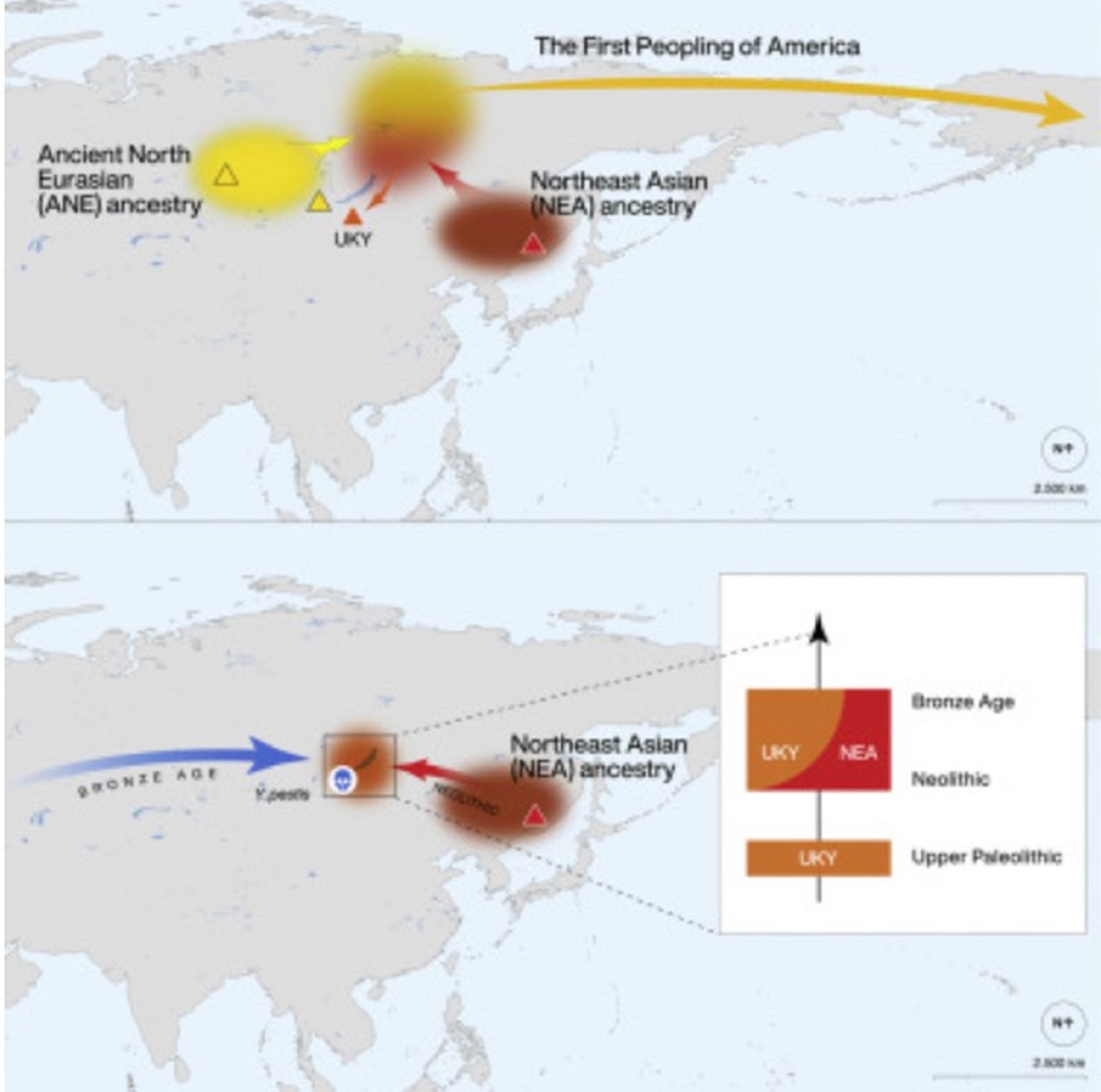
Pic ref
“Paleolithic to Bronze Age Siberians Reveal Connections with First Americans and across Eurasia.” ref
“Highlights: An Upper Paleolithic Siberian shows a deep link with the First Peoples of the Americas, A 10,000-year continuum of Ancient North Eurasian ancestry in the Lake Baikal region. The Neolithic to Bronze Age population formation occurred through prolonged local admixture. Long-range human and Y. pestis mobility across Eurasia during the Early Bronze Age.” ref
“Modern humans have inhabited the Lake Baikal region since the Upper Paleolithic, though the precise history of its peoples over this long time span is still largely unknown. Here, we report genome-wide data from 19 Upper Paleolithic to Early Bronze Age individuals from this Siberian region. An Upper Paleolithic genome shows a direct link with the First Americans by sharing the admixed ancestry that gave rise to all non-Arctic Native Americans. We also demonstrate the formation of Early Neolithic and Bronze Age Baikal populations as the result of prolonged admixture throughout the eighth to sixth millennium years ago. Moreover, we detect genetic interactions with western Eurasian steppe populations and reconstruct Yersinia pestis genomes from two Early Bronze Age individuals without western Eurasian ancestry. Overall, our study demonstrates the most deeply divergent connection between Upper Paleolithic Siberians and the First Americans and reveals human and pathogen mobility across Eurasia during the Bronze Age.” ref
“The Lake Baikal region in Siberia has been inhabited by modern humans since the Upper Paleolithic and has a rich archaeological record (Katzenberg and Weber, 1999, Weber, 1995). In the past 5 years, ancient genomic studies have revealed multiple genetic turnovers and admixture events in this region. The 24,000-year-old individual (MA1) from the Mal’ta site represents an ancestry referred to as “Ancient North Eurasian (ANE),” which was widespread across Siberia during the Paleolithic (Fu et al., 2016, Raghavan et al., 2014a, Sikora et al., 2019) and that contributed to the genetic profile of a vast number of present-day Eurasian populations as well as Native Americans (Haak et al., 2015, Lazaridis et al., 2014, Lazaridis et al., 2016, Raghavan et al., 2015). ANE ancestry was suggested to have been largely replaced in the Lake Baikal region during the Early Neolithic by a gene pool related to present-day northeast Asians, with a limited resurgence of ANE ancestry by the Early Bronze Age (Damgaard et al., 2018a).” ref
“Siberia has also been proposed as a source for multiple waves of dispersals into the Americas, the first of which was shown to be driven by a founding population estimated to have formed around 25,000–20,000 years before the present (BP) (Raghavan et al., 2015). The so-called Ancient Beringian ancestry represented by a 11,500-year-old Alaskan individual (USR1) was shown to be part of this founding population, estimated to have split from other Native Americans around 23,000 years ago (Moreno-Mayar et al., 2018). In addition, the recently published 9,800-year-old Kolyma genome from northeastern Siberia was suggested to represent the closest relative to Native American populations outside of the Americas (Sikora et al., 2019).” ref
“Moreover, the Paleo-Eskimo ancestry represented by a 4,000-year-old Saqqaq individual from Greenland was also estimated to have split from northeastern Siberian groups and migrated to Arctic America around 6,000–5,000 years ago (Flegontov et al., 2019, Raghavan et al., 2014b, Rasmussen et al., 2010). Although these waves of migration are generally linked to ancient Siberian populations, their origins in the context of the Siberian genetic history remain poorly understood. Further studies of the Siberian population history using ancient genomes are, therefore, critical for the better understanding of the formation of Native American populations.” ref
“Furthermore, the Neolithic to Bronze Age transition in Eurasia was marked by complex cultural and genetic changes facilitated by extensive population movements, though their impact in the Lake Baikal region is still unclear. Looking to the west, the Early Bronze Age groups from the Pontic-Caspian steppe associated with the Yamnaya complex spread both east and west along with their distinct genetic profile often referred to as “Steppe ancestry” (Allentoft et al., 2015, Haak et al., 2015). The eastward expansion of this group is considered to be associated with the Early Bronze Age Afanasievo culture. However, the later Middle Bronze Age Okunevo-related population from the central steppe as well as the Late Bronze Age Khövsgöl-related population from the eastern steppe harbor only a limited proportion of Steppe ancestry (Jeong et al., 2018, Jeong et al., 2019).” ref
“Therefore, the effect of steppe migrations in eastern Eurasia, particularly the interactions of Bronze Age Baikal hunter-gatherers with the contemporaneous and geographically proximal Afanasievo population, is still largely unexplored. In this study, we report 19 newly sequenced ancient hunter-gatherers from the Lake Baikal and its surrounding regions, spanning from the Upper Paleolithic to the Early Bronze Age.” ref
“Their analyses alongside published data reveal the most deeply divergent ancestry that link Upper Paleolithic Siberians and the First Peoples of the Americas, and more clearly delineate the complex transition between Early Neolithic and Early Bronze Age populations in the Lake Baikal region. We also provide both human and pathogen genomic evidence demonstrating the influence of western Eurasian steppe populations in this region during the Early Bronze Age and discuss the genetic contribution of Lake Baikal hunter-gatherers to Siberian populations through time.” ref
“Ancient DNA Sequencing: We generated genome-wide genotype data from 19 ancient humans, including one Upper Paleolithic individual (dated to around 14,050–13,770 years ago, see Orlova, 1995, Pavlenok et al., 2019), four Early Neolithic individuals (around 7,320–6,500 years ago), and 14 Late Neolithic to Early Bronze Age (LNBA) individuals (around 4,830–3,570 years ago) from a total of 10 archaeological sites (Figure 1; Table S1).” ref
“Upper Paleolithic Baikal Ancestry Links with Non-Arctic Native Americans: In the population structure analysis, we found the Upper Paleolithic UKY individual to be closely related with the northeastern Siberian Kolyma individual. This is further validated by outgroup f3 statistics (Figure 2A) where, similarly to Kolyma, UKY showed close genetic affinity with Native American and Beringian populations (Figure 2A). F4 statistics in the form of f4(Mbuti, X; Kolyma, UKY) revealed that Kolyma is more closely related to populations from northeastern Siberia and North America compared with UKY (Figure S2). We further applied f4 statistics to explore the relationship of UKY and Kolyma with Native Americans and USR1 that was described as an outgroup to all non-Arctic Native Americans (Moreno-Mayar et al., 2018). Both UKY and Kolyma were symmetrically related with non-Arctic Native Americans and USR1, while USR1 shared significantly more genetic affinity with Native American populations compared to UKY and Kolyma (Figure S2; Table S2).” ref
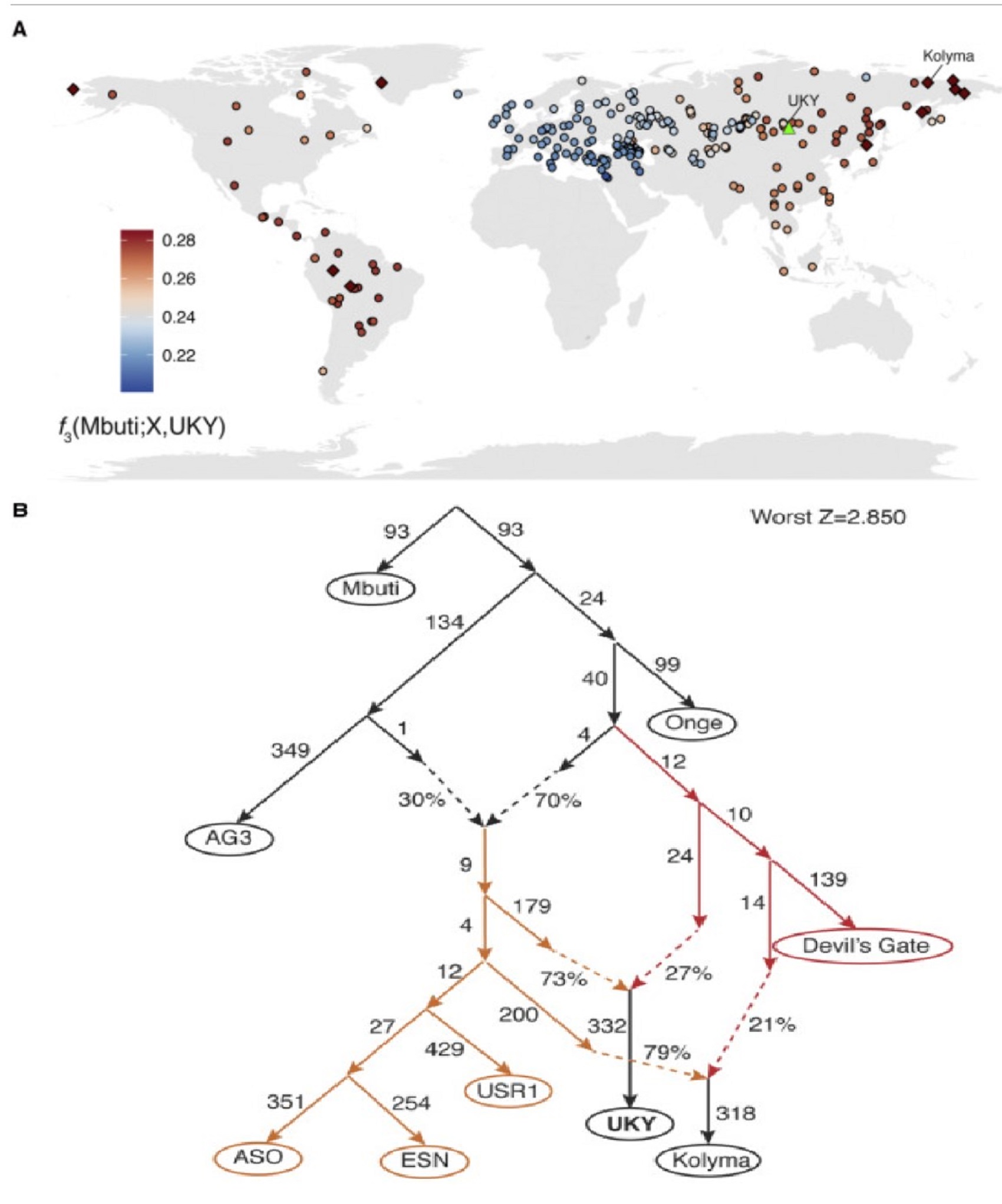
Pic ref
“We found that both UKY and Kolyma could be modeled as mixture between a northeast Asian lineage and a sister group of the Native American clade represented by USR1, Ancient Southwestern Ontario (ASO) individuals from Canada, and Early San Nicolas (ESN) individuals from the California Channel Islands in the USA (Scheib et al., 2018; Figure S2). When UKY and Kolyma were included in the same graph, they were consistently modeled as descendants from two independent admixture events, with ancestral lineages of both deriving from the Native American-related and the northeast Asian-related clades (Figure 2B). These findings confirm the close affinity of UKY and Kolyma to Native Americans but also highlight that both lineages contributing to UKY were ancestral to the groups contributing to Kolyma. In addition, aside from the first wave migrating into the Americas through Beringia, the admixture modeling suggests that the source of the Native American ancestry was more broadly spread across Siberia during the Upper Paleolithic, as UKY was found to be ∼4,000 years older and over 3,000 km further to the southwest from Kolyma. In fact, our admixture graph indicates that this basal Native American group experienced multiple genetic contacts with northeast Asian populations giving rise to distinct ancient Siberian populations.” ref
“Complex Transition between the Early Neolithic and Bronze Age in the Lake Baikal Region: A previous study described the transition between Early Neolithic and Bronze Age populations from the Lake Baikal region as the result of a discrete admixture event of ANE ancestry into the local gene pool (Damgaard et al., 2018a). In this study, we combined the newly sequenced Baikal_EN and Baikal_LNBA individuals with published data from the same time period (Figure 1C) and analyze these two combined datasets, Baikal_EN_all (n = 19) and Baikal_LNBA_all (n = 34), to better elucidate the genetic transition that occurred in this region. Prior to analyzing the combined groups, we confirmed the similarity between the new individuals and published groups using outgroup f3 statistics. Both Baikal_EN and Baikal_LNBA groups showed the highest genetic affinity with published Early Neolithic and LNBA Baikal populations, respectively (Table S4).” ref
“From outgroup f3 statistics of the combined groups, we found both of the Baikal Early Neolithic and LNBA groups to be sharing high genetic affinity with ancient and modern northeast Asian and Siberian populations (Figure S3). The LNBA Baikal population also showed a high genetic affinity with the Paleo-Eskimo Saqqaq individual. Compared to their NEA proxy, they both carried extra genetic affinity with ANE-related populations while the LNBA population more so than the Early Neolithic population, as shown by f4 statistics (Figure S3). These results revealed the existence of ANE-related ancestry in the Early Neolithic population and, at the same time, validated the previous finding that an extra ANE ancestry gene flow is responsible for the genetic shift between Early Neolithic and Bronze Age Baikal populations.” ref
“We further applied qpAdm modeling to quantify the proportion of ANE-related ancestry in Early Neolithic and LNBA Baikal populations, Saqqaq and Nganasan. Using Devil’s Gate as the NEA proxy, the Upper Paleolithic UKY was found to be a better fit than Kolyma as the ANE-related proxy for both Baikal populations, while AG3 provided a good fit for the Early Neolithic population (Table S5). Using Devil’s Gate and AG3 as the two proxies of NEA and ANE ancestries, respectively, we estimated the ANE-related ancestry increasing from 14.3% in the Early Neolithic Baikal population to 22.7% in the LNBA population (Figure 3A; Table S3). Of note, the northeastern Siberian Kolyma individual could work as a sufficient ANE proxy for Saqqaq, as described in the study where this genome was first reported (Sikora et al., 2019) but did not provide a good fit for the Baikal populations and Nganasan. This suggests that the Baikal hunter-gatherer and Nganasan populations are more likely to have formed in central or southern Siberia while Paleo-Eskimo ancestry could have emerged in either central or northeastern Siberia.” ref
“Furthermore, the program DATES was used to date the admixture events between ANE and NEA ancestries in the Baikal population based on the decay of ancestry covariance (Moorjani and Patterson, 2018). We detected a recent admixture signal in the Early Neolithic population, estimated to around 21 generations ago, while the admixture signal in LNBA population was dated to 71 generations ago, although this group harbored significantly more ANE-related ancestry (Table S5). When considering the average radiocarbon date of each population and the standard errors of their admixture dates, we identified contiguous intervals for the admixture events that spanned ∼8,500–6,000 BP, considering a generation time of 29 years (Figure 3B; Figure S4; Table S1; Table S5).” ref
“Assuming a dating offset of 400–500 years due to freshwater reservoir effect estimated for the newly reported individuals, the admixture timings ranged between ∼8,000 and 5,500 years ago. This suggests that both Baikal populations could have been formed through an extended admixture process between local groups and northeast Asian-related populations. The Early Neolithic groups were thus found to have experienced a prolonged admixture process, in contrast to the discrete and rather abrupt event suggested earlier (Damgaard et al., 2018a). This admixture, however, did not continue substantially in the Late Neolithic and Bronze Age, as suggested by the older admixture date for the LNBA population (Figure 3B) and the relatively larger genetic variation among Early Neolithic individuals compared to the homogeneous LNBA cluster, as shown in the PCA plot (Figure 1C).” ref
“High Mobility in Bronze Age Siberia Revealed by Genetic Outliers: Among the LNBA Baikal individuals, we identified three outlier individuals, which showed distinct genetic backgrounds from the major group. The genetic profile of the KPT005 individual suggested its affinity to western Eurasian populations inferred from PCA and ADMIXTURE results (Figure 1). Using qpAdm modeling, we found that this individual could indeed be modeled as the mixture between the LNBA Baikal and multiple Bronze Age western steppe populations, with the Steppe ancestry contribution ranging between 42% and 48% (Figure 4A; Table S5). Considering geography and radiocarbon dates, we suggest the most likely candidate in our dataset for the source of admixture to be the Yamnaya-related Afanasievo population from nearby Altai-Sayan region.” ref
“Identification of Y. pestis Infections among Genetic Outlier Individuals: Recent studies have reported evidence of Yersinia pestis infections in humans across multiple regions of Europe and central Asia between the Middle Neolithic and Bronze Age (∼4,900–3,500 years ago) (Andrades Valtueña et al., 2017, Rascovan et al., 2019, Rasmussen et al., 2015b, Spyrou et al., 2018). To date, the majority of identified strains group on an extinct phylogenetic lineage previously designated as the LNBA lineage (Andrades Valtueña et al., 2017). Such data have been interpreted alongside human population genetic frameworks, suggesting the spread of this lineage via Yamnaya-related human migrations across Eurasia during the Late Neolithic and Early Bronze Age (Andrades Valtueña et al., 2017).” ref
“To investigate the presence of pathogen DNA signatures among individuals from the Lake Baikal region, we screened all analyzed specimens (n = 19) using the pipeline HOPS (Hübler et al., 2019). Our metagenomic analysis of shotgun sequenced data revealed evidence of ancient Y. pestis DNA in two Early Bronze Age individuals (GLZ001 and GLZ002) (Figure S5), which were dated to around 4,556 and 4,430 years ago (median dates), respectively, after accounting for the freshwater reservoir effect present in this region (Table S1). Subsequent whole-Y. pestis-genome enrichment yielded a 7.2-and 12.8-fold genomic coverage for GLZ001 and GLZ002, respectively (Table S6). We built a maximum likelihood phylogeny in order to compare the newly reconstructed genomes with previously published ancient and modern Y. pestis isolates (Figure 4B).” ref
“GLZ001 and GLZ002 grouped on the previously described LNBA Y. pestis lineage (Andrades Valtueña et al., 2017, Rasmussen et al., 2015b), together with 4,800-to-3,500-year-old isolates from across Eurasia (Figure 4B). Specifically, they appeared most closely related (distance d = 17–19 SNPs) to a genome from the Baltic Sea region (Kunila2, around 4,520–4,290 years ago), retrieved from an individual culturally affiliated with the Corded Ware complex (Figure 4B; Andrades Valtueña et al., 2017). Such a result is intriguing since, based on human genetic analyses, individuals GLZ001 and GLZ002 appear as genetic outliers compared to other analyzed Bronze Age individuals from the same region. In addition, they lack Yamnaya-related Steppe ancestry (Figure 1; Figure 4A), common to all published plague victims with Y. pestis genomes grouping on the LNBA phylogenetic lineage (Andrades Valtueña et al., 2017, Rasmussen et al., 2015b).” ref
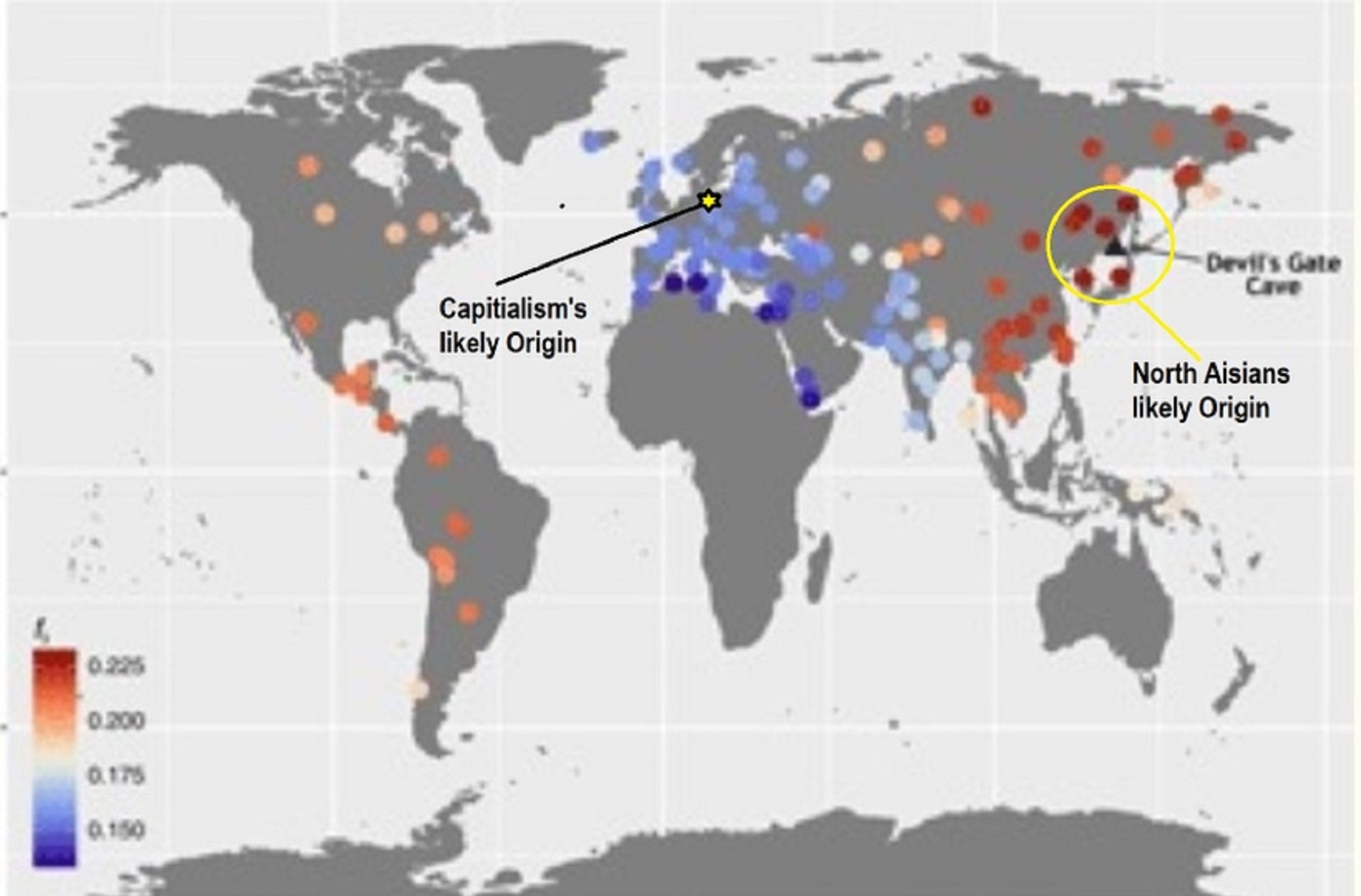
Pic ref
Abstract
“Ancient genomes have revolutionized our understanding of Holocene prehistory and, particularly, the Neolithic transition in western Eurasia. In contrast, East Asia has so far received little attention, despite representing a core region at which the Neolithic transition took place independently ~3 millennia after its onset in the Near East. We report genome-wide data from two hunter-gatherers from Devil’s Gate, an early Neolithic cave site (dated to ~7.7 thousand years ago) located in East Asia, on the border between Russia and Korea. Both of these individuals are genetically most similar to geographically close modern populations from the Amur Basin, all speaking Tungusic languages, and, in particular, to the Ulchi. The similarity to nearby modern populations and the low levels of additional genetic material in the Ulchi imply a high level of genetic continuity in this region during the Holocene, a pattern that markedly contrasts with that reported for Europe.” ref
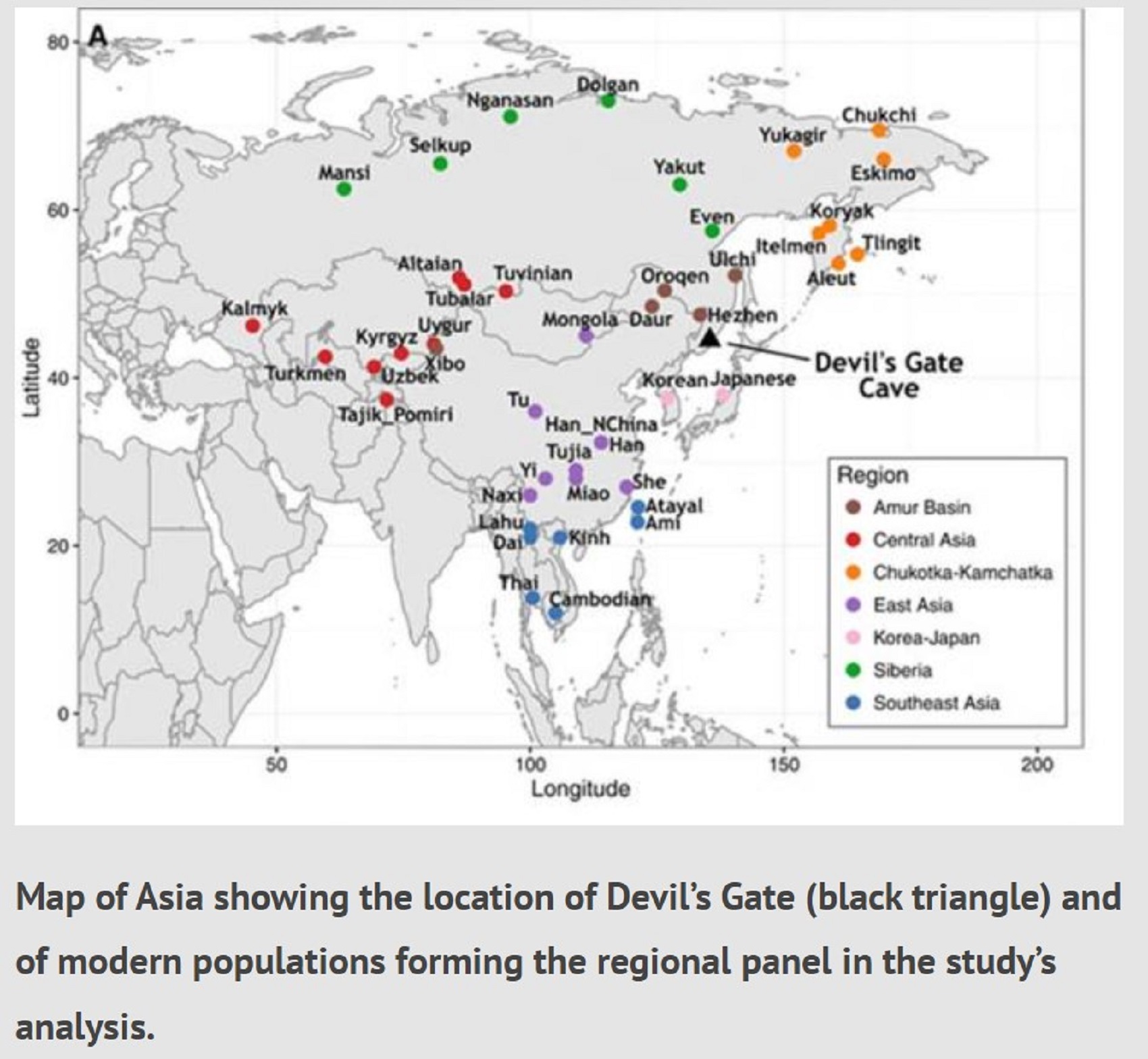
Pic ref
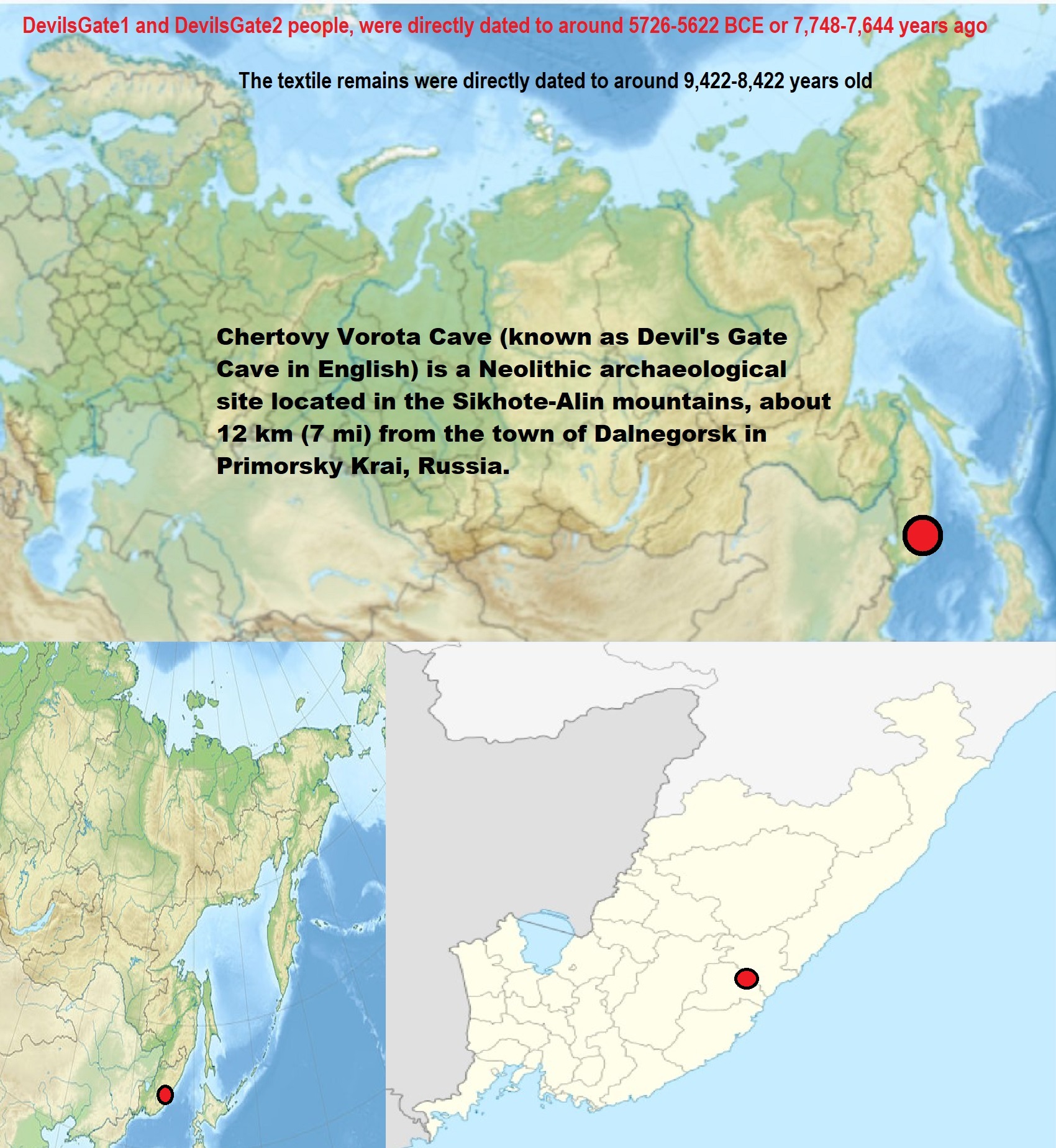
Pic ref
“Chertovy Vorota Cave (known as Devil’s Gate Cave in English) is a Neolithic archaeological site located in the Sikhote-Alin mountains, about 12 km (7 mi) from the town of Dalnegorsk in Primorsky Krai, Russia. Chertovy Vorota provides secure evidence for some of the oldest surviving textiles found in the archaeological record. The remains of carbonized textile fragments were found within the cave, under the remains of a wooden structure that had caught on fire and collapsed. The carbonized remains of rope, nets, and woven fabrics were recovered from the cave. The fibers likely came from Carex sordida, a sedge grass from the family Cyperaceae. The textile remains were directly dated to around 9,422-8,422 years ago, the earliest evidence in the archaeological record for textile remains from East Asia. As spindle whorls were not found in the cave, and also rarely found in contemporary East Asian sites, archaeologists postulate that the people at Chertovy Vorota either produced their textiles by hand or through the use of warp-weighted looms.” ref
Devil’s Gate Cave Human remains and Archaeogenetics
“The remains of 7 individuals were discovered within the cave. The skulls of two of the individuals, DevilsGate1 and DevilsGate2, were directly dated to around 5726-5622 BCE. Six of seven individuals whose remains have been recovered from the cave have been DNA tested. Originally, three of the specimens were thought to be adult males, two were thought to be adult females, one was thought to be a sub-adult of about 12-13 years of age, and one was thought to be a juvenile of about 6-7 years of age based on the skeletal morphology of the remains. Results of genetic analysis of the sub-adult individual have not yet been published.” ref
“However, two specimens, NEO236 (Skull B, DevilsGate2) and NEO235 (Skull G), who had been presumed to be adult males according to a forensic morphological assessment of their remains, were discovered through genetic analysis to actually be females. The juvenile specimen also has been determined to be female through genetic analysis. Three of the specimens (including the only adult male plus NEO235/Skull G and another adult female, labeled as Skull Е, DevilsGate1, or NEO240, who has been genetically determined to be a first-degree relative of NEO235/Skull G) have been assigned to mtDNA haplogroup D4m; a previous genetic analysis of one of these adult female specimens determined her mtDNA haplogroup to be D4.” ref
“Another three specimens (including the juvenile female, the DevilsGate2 specimen, and another adult female; both the juvenile female and the DevilsGate2 specimen have been determined to be first-degree relatives of the other adult female, and the juvenile female and the DevilsGate2 specimen also have been determined to be second-degree relatives of each other) have been assigned to haplogroup D4; a previous genetic analysis of the DevilsGate2 specimen determined her mtDNA haplogroup to be M. The only specimen from the cave who has been confirmed to be male through genetic analysis has been assigned to Y-DNA haplogroup C2b-F6273/Y6704/Y6708, equivalent to C2b-L1373, the northern (Central Asian, Siberian, and indigenous American) branch of haplogroup C2-M217.” ref
“When compared against all populations on record, ancient or modern, the ancient Chertovy Vorota individuals were found to be genetically closest to the contemporary Ulchi, speakers of a Tungusic language from the lower Amur Basin. The DevilsGate1 and DevilsGate2 specimens were also found to be close to the Hezhen and Oroqen, two other contemporary Tungusic-speaking populations from the basin of the Amur River, as well as contemporary Koreans, Japanese, and Nganasans. When compared against an outgroup from southern Africa (Khomani), outgroup f3 statistics indicate that DevilsGate1 and DevilsGate2 exhibit greatest shared drift with representatives of the same six populations, though in slightly different rank order: DevilsGate1 shares greatest drift with Ulchi followed in order by Oroqen, Hezhen, Korean, Japanese, and Nganasan, whereas DevilsGate2 shares greatest drift with Ulchi followed in order by Nganasan, Hezhen, Korean, Japanese, and Oroqen (cf. Fig. 2). The outgroup f3 statistics also reveal a tendency for the DevilsGate2 specimen to exhibit slightly greater shared drift with contemporary populations than the DevilsGate1 specimen shares with contemporary populations.” ref
“The ancient Chertovy Vorota individuals are genetically closest to the Ulchi, followed by the Oroqen and Hezhen. The genetic distance from the ancient Chertovy Vorota individuals to Mal’ta boy is the same as that from modern East Asian populations to Mal’ta boy. With the exception of DevilsGate1, most of the individuals tested did not yield enough DNA to allow for phenotypic testing of traits. DevilsGate1 did not carry the derived SLC45A2 or SLC24A5 alleles associated with lighter skin color, the derived HERC2 allele associated with blue eyes, the derived LT allele associated with lactase persistence, or the derived ALDH2 allele associated with the alcohol flush reaction. However, the individual likely did carry the derived EDAR allele commonly found in modern East Asian populations, the derived ABCC11 allele associated with dry earwax and reduced body odor commonly found in modern East Asian populations, and the derived ADD1 allele associated with increased risk for hypertension.” ref

Pic ref

Pic ref
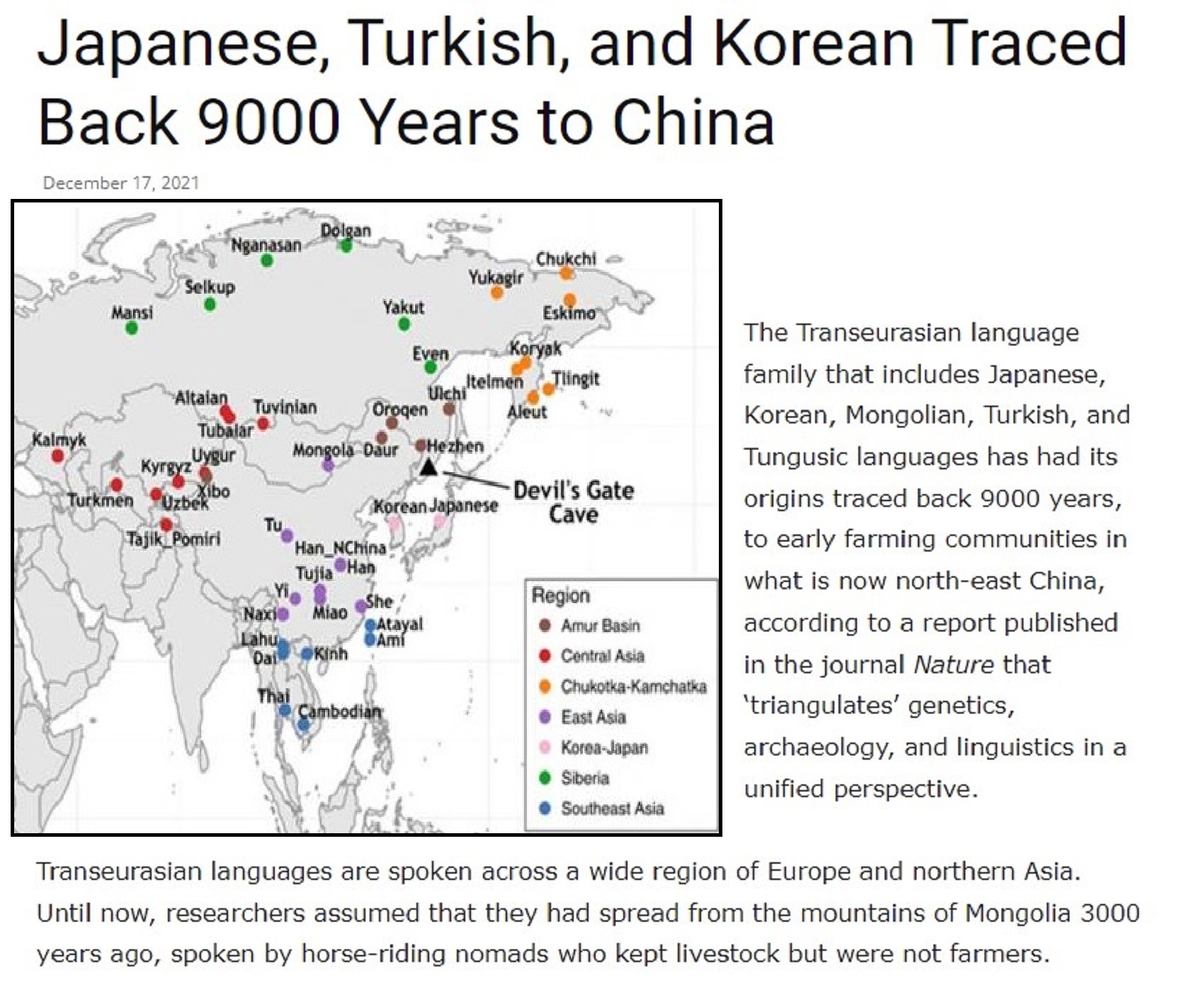
Pic ref
“The Transeurasian language family that includes Japanese, Korean, Mongolian, Turkish, and Tungusic languages has had its origins traced back 9000 years, to early farming communities in what is now north-east China, according to a report published in the journal Nature that ‘triangulates’ genetics, archaeology, and linguistics in a unified perspective. Transeurasian languages are spoken across a wide region of Europe and northern Asia. Until now, researchers assumed that they had spread from the mountains of Mongolia 3000 years ago, spoken by horse-riding nomads who kept livestock but were not farmers.” ref
“Martine Robbeets at the Max Planck Institute for the Science of Human History in Germany and her colleagues used linguistic, archaeological, and genetic evidence to arrive at the conclusion that it was the onset of millet cultivation by farmers in what is now China that led to the spread of the language family. By studying the linguistic features of the languages and using computational analysis, the team mapped their spread through space and time based on their similarities to each other. Doing so allowed Robbeets and her team to trace the proto-Transeurasian language back to the Liao River area of north-east China around 9000 years ago.” ref
“This is the exact time and place that millet is known to have been domesticated, according to archaeological evidence,” says Robbeets. By adding genetic information and carbon-dating millet grains, the team revealed that the proto-Transeurasian-speaking population split into separate communities that then started adopting early forms of Japanese, Korean, and the Tungusic languages to the east of the original site, as well as early forms of Mongolic languages to the north and of Turkic languages to the west.” ref

Pic ref
“Above picture: The distribution of the Transeurasian languages. Abbreviations for languages are explained as follows: Ama.: Amami; Az.: Azerbaijani; Bao.: Bao’an; Bash.: Bashkir; Bur.: Buriat; Chu.: Chuvash; Dag.: Dagur; Dlg.: Dolgan; Dong.: Dongxiang; EYugh.: Eastern Yughur; Even: Even; Evk.: Evenki; Gag.: Gagauz; J: Japanese; Kalm.: Kalmuk; KBalk.: Karachay-Balkar; Krm.: Karaim; Kkp.: Karakalpak; Kaz.: Kazakh; Khak.: Khakas; Khal.: Khalkha; Khalaj: Khalaj; Kir.: Kirgiz; K: Korean; Kum.: Kumyk; Ma.: Manchu; MK: Middle Korean; MMo.: Middle Mongolian; Miy.: Miyako; Mogh.: Moghol; Mgr.: Monguor; Na.: Nanai; Neg.: Negidal; Nog.: Nogai; Oki.: Okinawa; Olcha: Olcha; OJ: Old Japanese; OT: Old Turkic; Ord.: Ordos; Oroch: Oroch; Shor: Shor; Sibe: Sibe; Sol: Solon; Tat.: Tatar; Tofa.: Tofalar; Tk.: Turkish; Tkm.: Turkmen; Tuva: Tuva; Ud.: Udehe; Uigh.: Uighur; Uz.: Uzbek; Yae.: Yaeyama; Yak.: Yakut; Yon.: Yonaguni.” ref
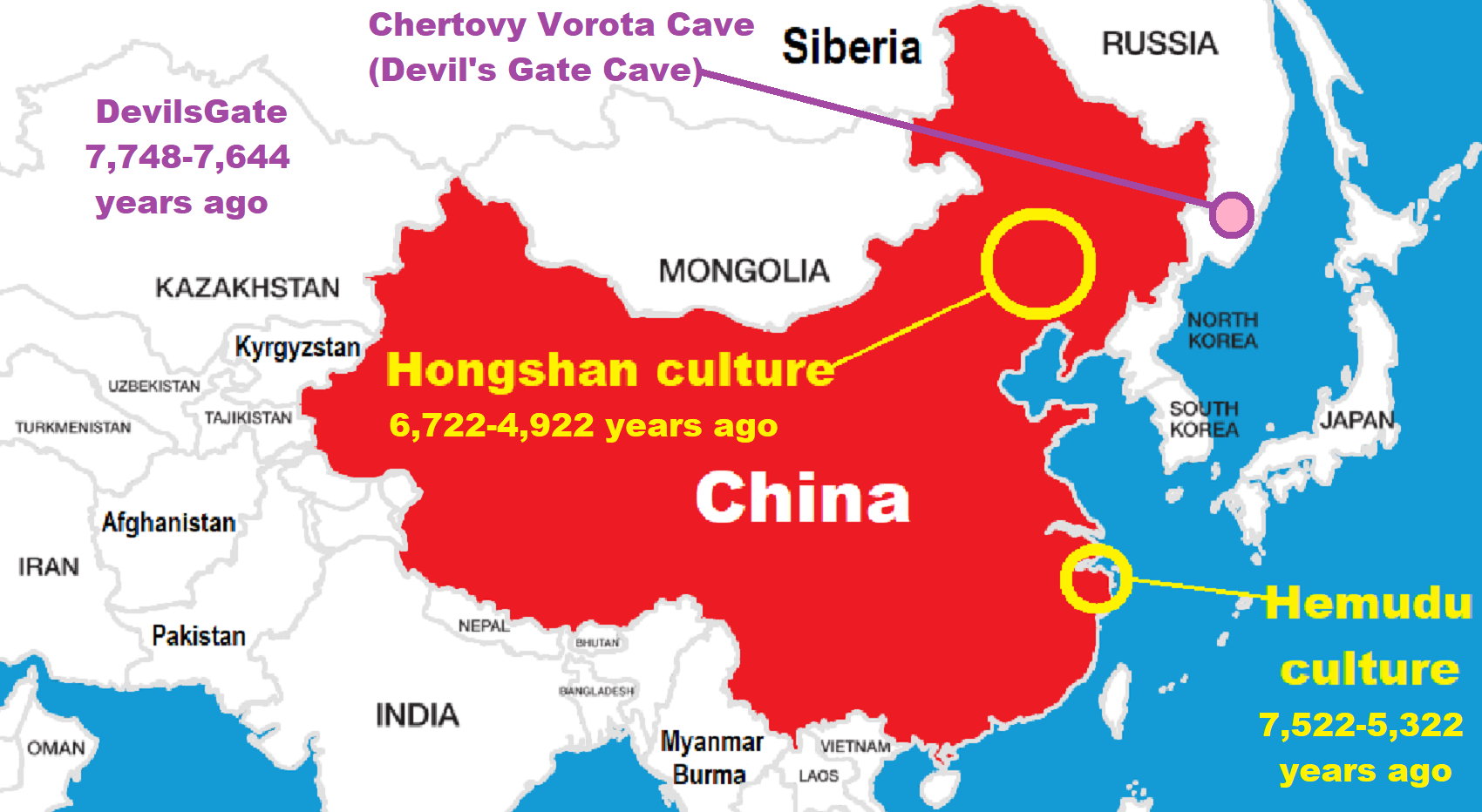
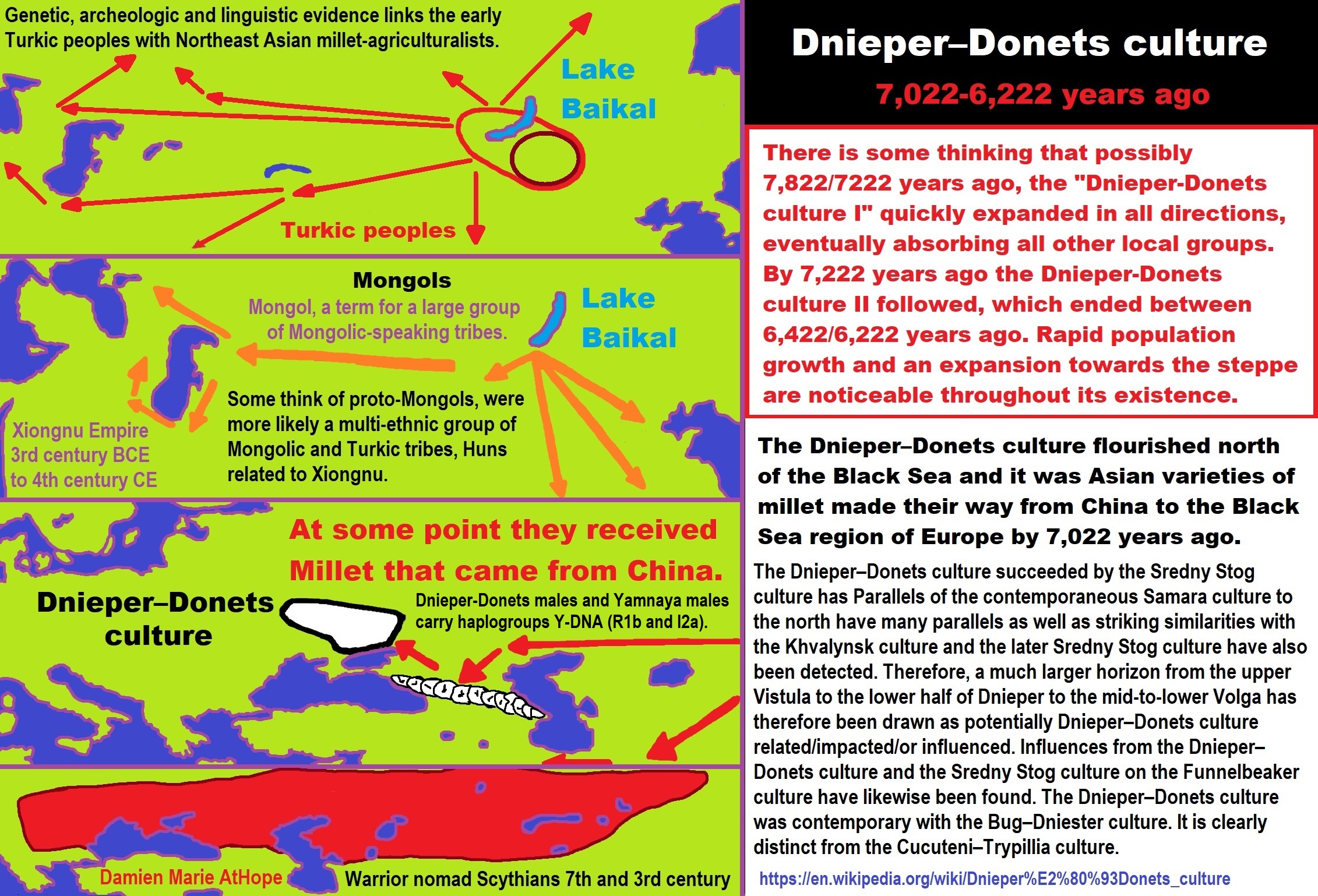
ref, ref, ref, ref, ref, ref, ref
Ancient North Eurasians
“In archaeogenetics, the term Ancient North Eurasian (often abbreviated as ANE) is the name given to an ancestral West Eurasian component that represents descent from the people similar to the Mal’ta–Buret’ culture and populations closely related to them, such as from Afontova Gora and the Yana Rhinoceros Horn Site. Significant ANE ancestry are found in some modern populations, including Europeans and Native Americans. The earliest known individual with a genetic mutation associated with blonde hair in modern Europeans is an Ancient North Eurasian female dating to around 16000 BCE from the Afontova Gora 3 site in Siberia. It has been suggested that their mythology may have included a narrative, found in both Indo-European and some Native American fables, in which a dog guards the path to the afterlife.” ref
“The ANE lineage is defined by association with the MA-1, or “Mal’ta boy“, the remains of an individual who lived during the Last Glacial Maximum, 24,000 years ago in central Siberia, discovered in the 1920s. Ancient North Eurasians are described as a lineage “which is deeply related to Paleolithic/Mesolithic hunter-gatherers in Europe,” meaning that they diverged from Paleolithic Europeans a long time ago. The proposed split between ANE and Paleolithic Europeans happened either in Europe or in the Middle East. All currently found samples, associated with Ancient North Eurasians, had minor admixture from an ancient East Asian-related population, such as the Tianyuan Man. Sikora et al. (2019) found that the oldest ANE-associated Yana RHS sample (around 31,600 years ago) in Northeastern Siberia “can be modeled as early West Eurasian with an approximately 22% contribution from early East Asians” suggesting early contact in Northeastern Siberia.” ref
“Populations genetically similar to MA-1 were an important genetic contributor to Native Americans, Europeans, Central Asians, South Asians, and some East Asian groups (such as the Ainu people), in order of significance. Lazaridis et al. (2016:10) note “a cline of ANE ancestry across the east-west extent of Eurasia.” The ancient Bronze-age-steppe Yamnaya and Afanasevo cultures were found to have a noteworthy ANE component at ~25% (some studies estimated a higher percentage at nearly ~50%). According to Moreno-Mayar et al. 2018 between 14% and 38% of Native American ancestry may originate from gene flow from the Mal’ta–Buret’ people (ANE).” ref
“This difference is caused by the penetration of posterior Siberian migrations into the Americas, with the lowest percentages of ANE ancestry found in Eskimos and Alaskan Natives, as these groups are the result of migrations into the Americas roughly 5,000 years ago. Estimates for ANE ancestry among first wave Native Americans show higher percentages, such as 42% for those belonging to the Andean region in South America. The other gene flow in Native Americans (the remainder of their ancestry) was of East Asian origin. Gene sequencing of another south-central Siberian people (Afontova Gora-2) dating to approximately 17,000 years ago, revealed similar autosomal genetic signatures to that of Mal’ta boy-1, suggesting that the region was continuously occupied by humans throughout the Last Glacial Maximum.” ref
Genomic studies also indicate that the ANE component was introduced to Western Europe by people related to the Yamnaya culture, long after the Paleolithic. It is reported in modern-day Europeans (10%–20%). Additional ANE ancestry is found in European populations through Paleolithic interactions with Eastern European Hunter-Gatherers, which resulted in populations such as Scandinavian Hunter-Gatherers. The Ancient North Eurasians (ANE) split from the ancestors of European peoples somewhere in the Middle East or South-central Asia, and used a northern dispersal route through Central Asia into Northern Asia and Siberia.” ref
“Genetic analyses show that the currently found ANE samples (Afontova Gora 3, Mal’ta 1, and Yana-RHS) show evidence for minor geneflow from an East Asian-related group (samplified by the Amis, Han, or Tianyuan), suggesting long-term contact with East Asian migrant groups. In contrast, no evidence for ANE-related geneflow into East Asians (Amis, Han, Tianyuan), except the Ainu, was found. Genetic data suggests that the ANE formed during the Terminal Upper-Paleolithic (36,000+-1,5 years ago) period from a deeply European-related population, which was once widespread in Northern Eurasia, and from an early East Asian-related group, which migrated northwards into Central Asia and Siberia, merging with this deeply European-related population.” ref
These population dynamics and constant northwards geneflow of East Asian-related ancestry would later give rise to the “Ancestral Native Americans” and Paleosiberians, which replaced the ANE as the dominant population of Siberia. The amount of East Asian-related ancestry among analyzed ANE samples varies between 14% to up to 32% suggesting a slow increase of East Asian-related ancestry since the late Paleolithic. The East Asian-like ancestry is best represented by a population ancestral to modern East Asians and Southeast Asians.” ref
Groups partially derived from the Ancient North Eurasians
“Eastern Hunter-Gatherer (EHG) is a lineage which derived significant ancestry from ANE, ranging between 9% to up to 75%, with the remaining ancestry from a group more closely related to, but distinct from, Western Hunter-Gatherers (WHGs). It is represented by two individuals from Karelia, one of Y-haplogroup R1a-M417, dated c. 8,422 years ago, and the other of Y-haplogroup J, dated c. 7,222 years ago; and one individual from Samara, of Y-haplogroup R1b-P297, dated c. 7,622 years ago. After the end of the Last Glacial Maximum, the Western Hunter-Gatherers (WHG) and EHG lineages merged in Eastern Europe, accounting for early presence of ANE-derived ancestry in Mesolithic Europe. Evidence suggests that as Ancient North Eurasians migrated West from Eastern Siberia, they absorbed Western Hunter-Gatherers and other West Eurasian populations as well.” ref
“Scandinavian Hunter-Gatherer (SHG) is represented by several individuals buried at Motala, Sweden ca. 6000 BCE or 8,022 years ago. They were descended from Western Hunter-Gatherers who initially settled Scandinavia from the south, and later populations of EHG who entered Scandinavia from the north through the coast of Norway.” ref
“Ancient Beringian/Ancestral Native American are specific archaeogenetic lineages, based on the genome of an infant found at the Upward Sun River site (dubbed USR1), dated to 11,522 years ago. The AB lineage diverged from the Ancestral Native American (ANA) lineage about 20,022 years ago.” ref
“West Siberian Hunter-Gatherer (WSHG) are a specific archaeogenetic lineage, first reported in a genetic study published in Science in September 2019. WSGs were found to be of about 30% EHG ancestry, 50% ANE ancestry, and 20% to 38% East Asian ancestry.” ref
“Western Steppe Herders (WSH) is the name given to a distinct ancestral component that represents descent closely related to the Yamnaya culture of the Pontic–Caspian steppe. This ancestry is often referred to as Yamnaya ancestry or Steppe ancestry.” ref
“Late Upper Paleolithic Lake Baikal – Ust’Kyakhta-3 (UKY) 14,072-13,792 years ago were mixture of 30% ANE ancestry and 70% East Asian ancestry.” ref
“Lake Baikal Holocene – Baikal Eneolithic (Baikal_EN) and Baikal Early Bronze Age (Baikal_EBA) derived 6.4% to 20.1% ancestry from ANE, while rest of their ancestry was derived from East Asians. Fofonovo_EN near by Lake Baikal were a mixture of 12-17% ANE ancestry and 83-87% East Asian ancestry.” ref
“Hokkaido Jōmon people specifically refers to the Jōmon period population of Hokkaido in northernmost Japan. Though the Jōmon people themselves descended mainly from East Asian lineages, one study found an affinity between Hokkaido Jōmon with the Northern Eurasian Yana sample (an ANE-related group, related to Mal’ta), and suggest as an explanation for the possibility of minor Yana gene flow into the Hokkaido Jōmon population (as well as other possibilities). A more recent study by Cooke et al. 2021, confirmed ANE-related geneflow among the Jōmon people, partially ancestral to the Ainu people. ANE ancestry among Jōmon people is estimated at 21%, however, there is a North to South cline within the Japanese archipelago, with the highest amount of ANE ancestry in Hokkaido and Tohoku.” ref
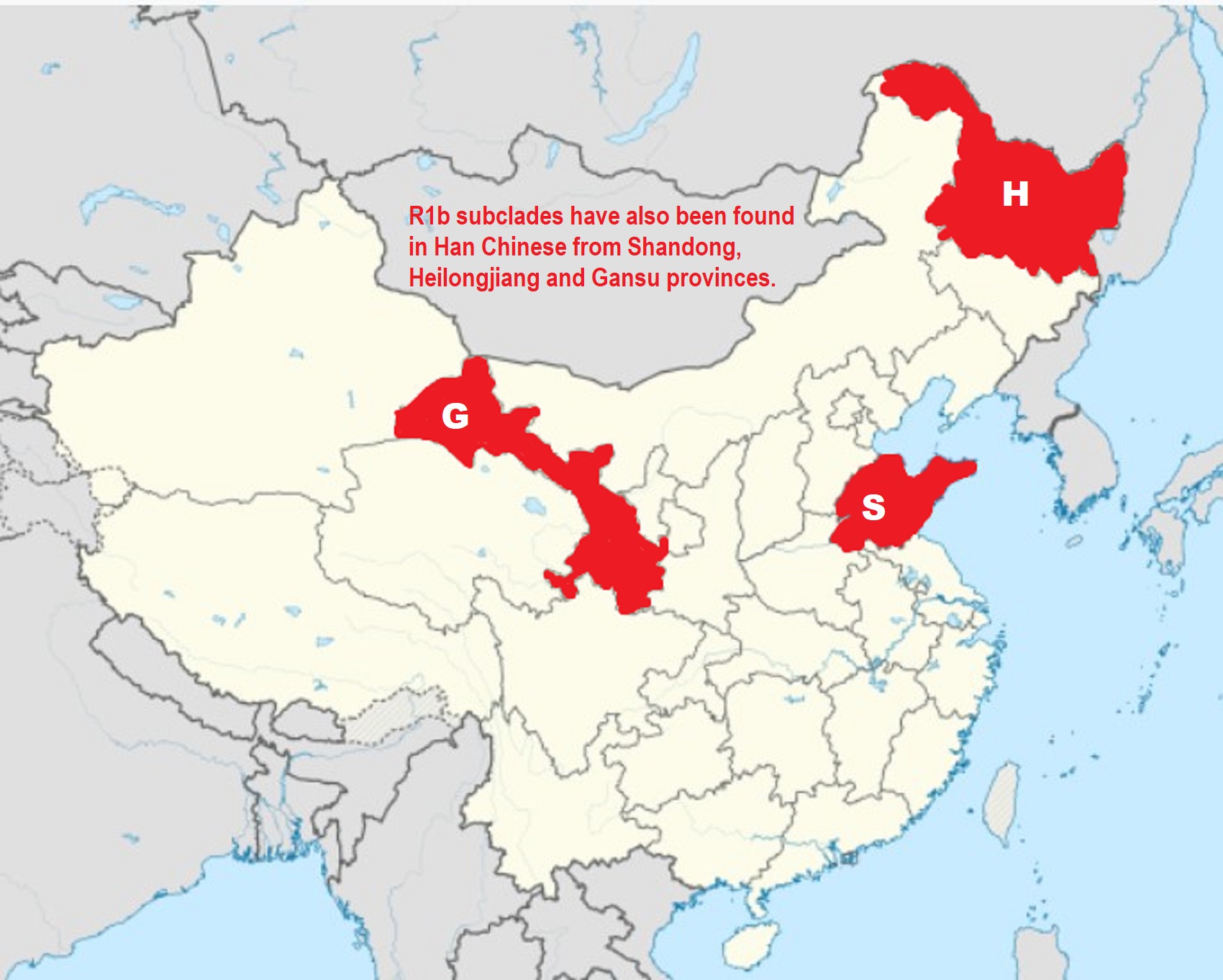
Yamnaya culture
“The Yamnaya culture is also known as the Yamnaya Horizon, Yamna culture, Pit Grave culture, or Ochre Grave culture, was a late Copper Age to early Bronze Age archaeological culture of the region between the Southern Bug, Dniester, and Ural rivers (the Pontic steppe), dating to 3300–2600 BCE or 5,322-4,622 years ago. Its name derives from its characteristic burial tradition: Я́мная (romanization: yamnaya) is a Russian adjective that means ‘related to pits (yama)’, and these people used to bury their dead in tumuli (kurgans) containing simple pit chambers. The Yamnaya culture is identified with the late Proto-Indo-Europeans, and the Pontic-Caspian steppe is the strongest candidate for the Urheimat (original homeland) of the Proto-Indo-European language.” ref
“The people of the Yamnaya culture were likely the result of a genetic admixture between the descendants of Eastern European Hunter-Gatherers (EHG) and people related to hunter-gatherers from the Caucasus (CHG), an ancestral component which is often named “Steppe ancestry”, with an additional admixture of up to 18% from Early European Farmers. Their material culture was very similar to the Afanasevo culture, and the populations of both cultures are genetically indistinguishable. They lived primarily as nomads, with a chiefdom system and wheeled carts and wagons that allowed them to manage large herds.” ref
“The people of the Yamnaya culture are also closely connected to Final Neolithic cultures, which later spread throughout Europe and Central Asia, especially the Corded Ware people and the Bell Beaker culture, as well as the peoples of the Sintashta, Andronovo, and Srubnaya cultures. Back migration from Corded Ware also contributed to Sintashta and Andronovo. In these groups, several aspects of the Yamnaya culture are present. Genetic studies have also indicated that these populations derived large parts of their ancestry from the steppes.” ref

ref, ref, ref, ref, ref, ref, ref, ref, ref, ref, ref, ref
“There were at least several “out-of-Africa” dispersals of modern humans, possibly beginning as early as 270,000 years ago, including 215,000 years ago to at least Greece, and certainly via northern Africa and the Arabian Peninsula about 130,000 to 115,000 years ago. These early waves appear to have mostly died out or retreated by 80,000 years ago.” ref
“The most significant “recent” wave out of Africa took place about 70,000–50,000 years ago, via the so-called “Southern Route“, spreading rapidly along the coast of Asia and reaching Australia by around 65,000–50,000 years ago, (though some researchers question the earlier Australian dates and place the arrival of humans there at 50,000 years ago at earliest, while others have suggested that these first settlers of Australia may represent an older wave before the more significant out of Africa migration and thus not necessarily be ancestral to the region’s later inhabitants) while Europe was populated by an early offshoot which settled the Near East and Europe less than 55,000 years ago.” ref
- “An Eastward Dispersal from Northeast Africa to Arabia 150,000–130,000 years ago based on the finds at Jebel Faya dated to 127,000 years ago (discovered in 2011). Possibly related to this wave are the finds from Zhirendong cave, Southern China, dated to more than 100,000 years ago. Other evidence of modern human presence in China has been dated to 80,000 years ago.” ref
- “The most significant out of Africa dispersal took place around 50–70,000 years ago via the so-called Southern Route, either before or after the Toba event, which happened between 69,000 and 77,000 years ago. This dispersal followed the southern coastline of Asia, and reached Australia around 65,000-50,000 years ago, or according to some research, by 50,000 years ago at earliest. Western Asia was “re-occupied” by a different derivation from this wave around 50,000 years ago, and Europe was populated from Western Asia beginning around 43,000 years ago.” ref
- “Wells (2003) describes an additional wave of migration after the southern coastal route, namely a northern migration into Europe at circa 45,000 years ago. However, this possibility is ruled out by Macaulay et al. (2005) and Posth et al. (2016), who argue for a single coastal dispersal, with an early offshoot into Europe.” ref
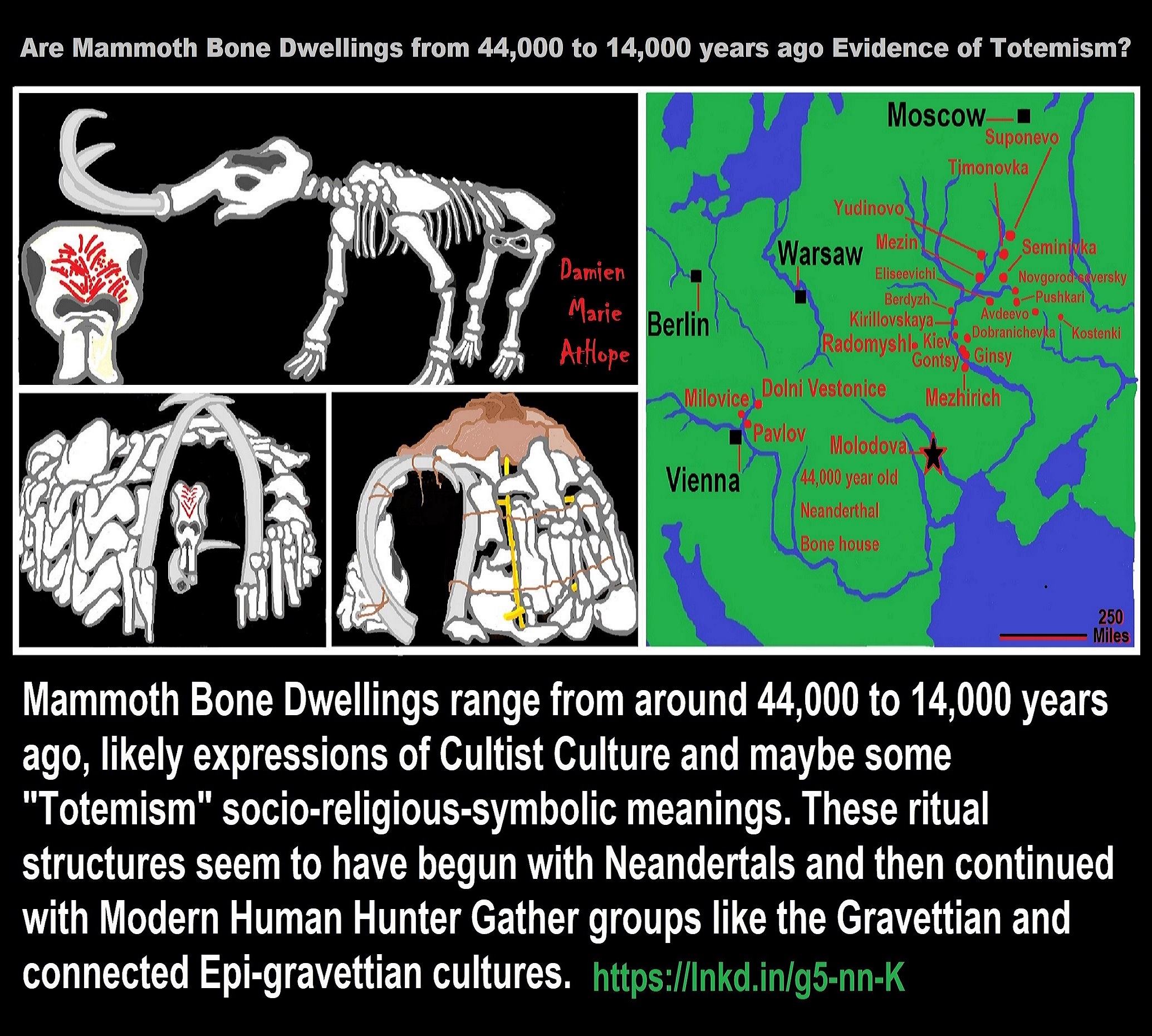
Mammoth bone dwellings are a very an early type of housing constructed by Upper Paleolithic hunter-gatherers mainly in central Europe. ref
Mammoth Bone Dwellings range from around 44,000 to 14,000 years ago, likely expressions of Cultist Culture and maybe some “Totemism” socio-religious-symbolic meanings. These ritual structures seem to have begun with Neandertals and then continued with Modern Human Hunter Gather groups like the Gravettian and connected Epi-gravettian cultures. ref
Gravettian and Epigravettian mammoth bone dwellings range from: Pavlovian (Early Gravettian of Moravia), Gagarino and Pouchkari (Gravettian of Eastern Europe), Kostienki 11/1a (Zamiatnine culture), and Mezinian. ref
The 44,000-year-old site from Molodova in eastern Ukraine was a Neanderthal “Mousterian Culture” Mammoth Bone Dwelling with possible “Totemism” connections due to how some of the bones used to build the ritual structure home had decorative carvings and added pigments. It was an incredible 26 foot wide circular building believed to be earliest bone built cultural structure and where they lived for extended periods of time. ref, ref
The 44,000-year-old Neanderthal bone structure near Molodova was constructed with 116 large deliberately selected mammoth bones including skulls, jaws, tusks and leg. Inside there was at least 25 fire pits and from the artifacts found Neanderthals made many decorated carvings in addition to the symbolic adding of ochre pigments to the bones. ref, ref
The painting in red on the front of mammoth skull may represent the flames and sparks of a fire and as bones where found burned in fire pits so there could be a ritualistic representation connection, which I think it is. It could be a prehistoric “drum” consisted of a mammoth skull, which may relate to a change from totemism to shamanism and was set at the entrance as well as contained a painted pattern of red ocher dots and lines. The top of this skull bears depressions where it seems to have been beaten by “drumsticks,” the animal long bones that were found to bear corresponding damage on their ends. It is possible that the building may have served some ritual or communal function at which the mammoth bone rhythms were beaten out, although many Ukrainian huts of a similar size seem to have been ordinary living places. ref, ref, ref
Even more telling to its ritualistic relevance is that is was found at the entrance to one of the mammoth hunter’s huts, which could also hold a vaginal/womb reference and as there was also an oddly placed signal tusk pointing in and hugging the head sticking upright out of the ground almost as if it represents a phallus entering the vaginal/womb thus fertility hunting cult suggestions as well as maybe fire worship. ref, ref
Inside the Mezherich building, there were some remarkable finds: amber ornaments and fossil shells, transported an estimated 218 to 310 miles from their source, and the remains of one of the earliest percussion instruments ever found. The middle Dnepr basin is the origin of amber is well known near Kiev where it was collected throughout the Upper Palaeolithic. Amber objects have been used as pieces of small adornment in the Upper Palaeolithic sites of the Dnepr basin: Gontsy, Dobra-nichivka, Mejiriche, Semenivka 2, Ioudinovo, Chulatovo 2, Mezine, Osokorivka (level 2), and Kaistrova balka 2 ref, ref
A spectacular prehistoric art is visible in the dwellings of the Mezinian, in the grouping in the outer wall of jaws and long bones showing a geometric pattern of lines, chevrons and zigzags, which are also figured in the painted bones of the dwellings and in the mobile art of the statuettes, tools and various artifacts, confirming they are the manifestation of a socio-symbolic system of the Mezinian culture. ref
A mammoth bone dwelling hold a common form of a circular or oval structure with walls made of stacked large mammoth bones often modified to allow them to be lashed together or implanted into the soil. Within the interior is typically found a central fire pits or several scattered fire pits. External fire pits, butchering areas, and flint workshops are often found in association with the hut: scholars call these combinations Mammoth Bone Settlements (MBS). ref
The mammoth bone dwellings are not random. And they seem to express a pattern, thus this may demonstrate cultural/religious transfer inclinations and consistency in tradition over thousands of years. Similarly they are composed of several hundred bones and tusks arranged in a rough circles with a diameter of 20 to 33 feet. Even more interesting is that the first Neanderthal mammoth bone dwelling at 44,000-year-old was also in the range at 26 feet, thus it too is consistent with all the rest seeming to hit that they share some deep possible connection. ref
Such bone houses have been found in considerable numbers, often clustered together in little “villages” of four or five houses in the fertile valleys of the Ukraine and the same method of construction has appeared as far west as Kracow, in Poland, with three rings of mammoth bones exactly similar to those in Russia and dating to about 20 000 years ago. ref
Relatively all of the mammoth bone dwelling sites date to the Upper Paleolithic period (Gravettian or Epi-Gravettian), with the sole exception of Molodova 1, which dates to the Middle Stone Age and is associated with Neanderthals. ref

In Kostënki 17, Russia, there were numerous pendants recovered and at least one, seen above, was dated to 43,000 years ago, which was made from fossil belemite rostrum. The artifacts include a group of more than 40 pendants made from fox canines teeth. In addition, there were pendants made from stone and fossils as well. Along with shell beads from the lower layers of Kostënki 14 and the Kostënki 17 pendants are the earliest good evidence for personal adornment anywhere in Eastern Europe. The occupations at Kostenki include several Late Early Upper Paleolithic levels, dated between 42,000 to 30,000 calibrated years ago (cal BP). Kostenki, the Aurignacian sequence was considered the oldest component associated with modern humans at archaeological sites in Europe, underlain by Mousterian-like deposits representing Neanderthals. Kostenki 14, also known as Markina Gora, is the main site at Kostenki, and it has been found to contain genetic evidence concerning the migration of early modern humans from Africa into Eurasia. ref, ref

ref, ref, ref, ref, ref, ref, ref, ref, ref, ref, ref, ref, ref, ref
1. Kebaran culture 23,022-16,522 Years Ago, 2. Kortik Tepe 12,422-11,722 Years Ago, 3. Jerf el-Ahmar 11,222 -10,722 Years Ago, 4. Gobekli Tepe 11,152-9,392 Years Ago, 5. Tell Al-‘abrUbaid and Uruk Periods, 6. Nevali Cori 10,422 -10,122 Years Ago, 7. Catal Hoyuk 9,522-7,722 Years Ago
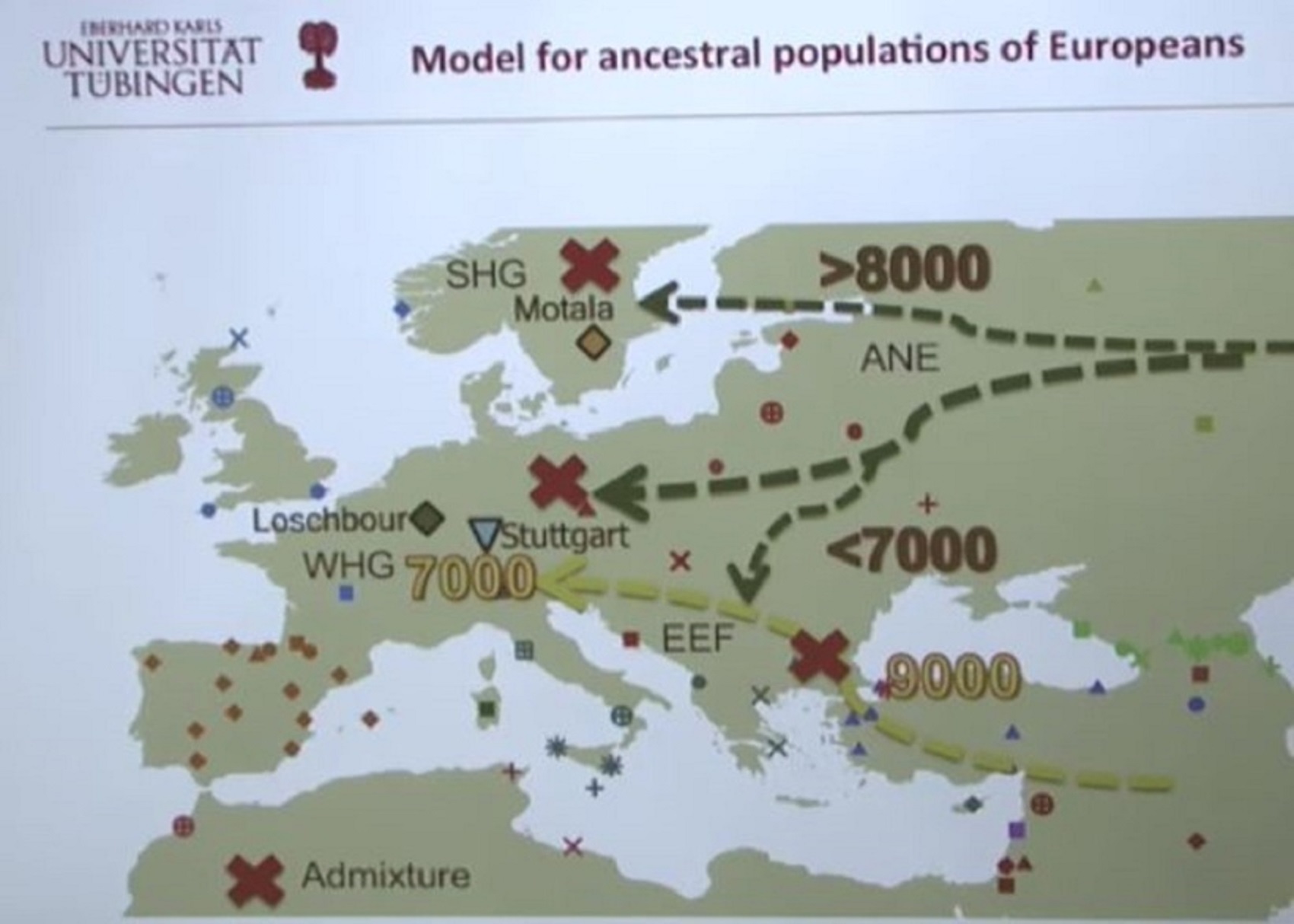
Pic ref
Ancient Human Genomes…Present-Day Europeans – Johannes Krause (Video)
Ancient North Eurasian (ANE)
Eastern Hunter-Gatherer (EHG)
Western Hunter-Gatherers (WHG)
Scandinavian Hunter-Gatherer (SHG)
Early European Farmers (EEF)
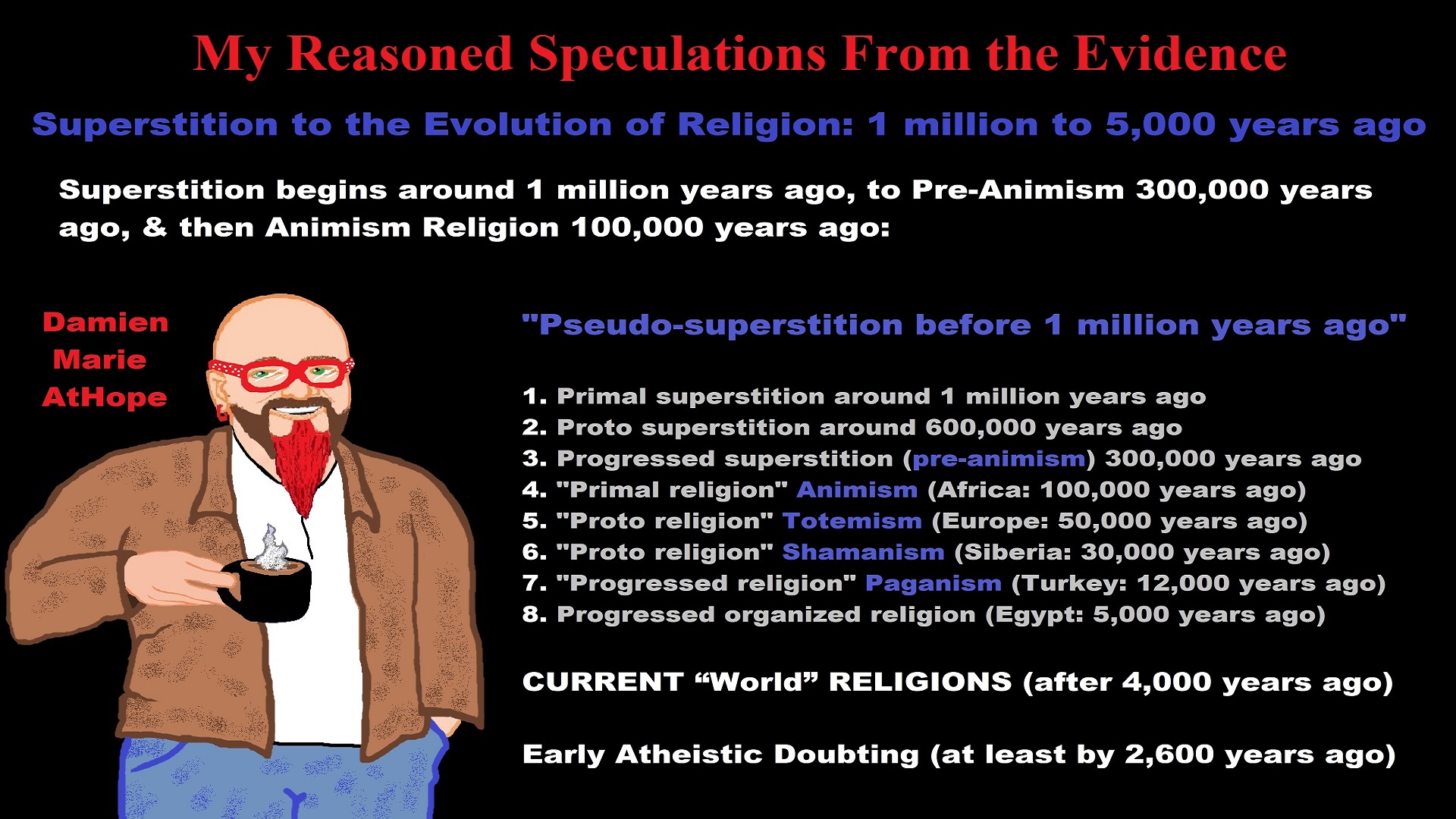
My thoughts on Religion Evolution with external links for more info:
- (Pre-Animism Africa mainly, but also Europe, and Asia at least 300,000 years ago), (Pre-Animism – Oxford Dictionaries)
- (Animism Africa around 100,000 years ago), (Animism – Britannica.com)
- (Totemism Europe around 50,000 years ago), (Totemism – Anthropology)
- (Shamanism Siberia around 30,000 years ago), (Shamanism – Britannica.com)
- (Paganism Turkey around 12,000 years ago), (Paganism – BBC Religion)
- (Progressed Organized Religion “Institutional Religion” Egypt around 5,000 years ago), (Ancient Egyptian Religion – Britannica.com)
- (CURRENT “World” RELIGIONS after 4,000 years ago) (Origin of Major Religions – Sacred Texts)
- (Early Atheistic Doubting at least by 2,600 years ago) (History of Atheism – Wikipedia)
“Religion is an Evolved Product” and Yes, Religion is Like Fear Given Wings…
Atheists talk about gods and religions for the same reason doctors talk about cancer, they are looking for a cure, or a firefighter talks about fires because they burn people and they care to stop them. We atheists too often feel a need to help the victims of mental slavery, held in the bondage that is the false beliefs of gods and the conspiracy theories of reality found in religions.
Understanding Religion Evolution:
- Pre-Animism (at least 300,000 years ago)
- Animism (Africa: 100,000 years ago)
- Totemism (Europe: 50,000 years ago)
- Shamanism (Siberia: 30,000 years ago)
- Paganism (Turkey: 12,000 years ago)
- Progressed organized religion (Egypt: 5,000 years ago), (Egypt, the First Dynasty 5,150 years ago)
- CURRENT “World” RELIGIONS (after 4,000 years ago)
- Early Atheistic Doubting (at least by 2,600 years ago)
“An Archaeological/Anthropological Understanding of Religion Evolution”
It seems ancient peoples had to survived amazing threats in a “dangerous universe (by superstition perceived as good and evil),” and human “immorality or imperfection of the soul” which was thought to affect the still living, leading to ancestor worship. This ancestor worship presumably led to the belief in supernatural beings, and then some of these were turned into the belief in gods. This feeble myth called gods were just a human conceived “made from nothing into something over and over, changing, again and again, taking on more as they evolve, all the while they are thought to be special,” but it is just supernatural animistic spirit-belief perceived as sacred.
Quick Evolution of Religion?
Pre-Animism (at least 300,000 years ago) pre-religion is a beginning that evolves into later Animism. So, Religion as we think of it, to me, all starts in a general way with Animism (Africa: 100,000 years ago) (theoretical belief in supernatural powers/spirits), then this is physically expressed in or with Totemism (Europe: 50,000 years ago) (theoretical belief in mythical relationship with powers/spirits through a totem item), which then enlists a full-time specific person to do this worship and believed interacting Shamanism (Siberia/Russia: 30,000 years ago) (theoretical belief in access and influence with spirits through ritual), and then there is the further employment of myths and gods added to all the above giving you Paganism (Turkey: 12,000 years ago) (often a lot more nature-based than most current top world religions, thus hinting to their close link to more ancient religious thinking it stems from). My hypothesis is expressed with an explanation of the building of a theatrical house (modern religions development). Progressed organized religion (Egypt: 5,000 years ago) with CURRENT “World” RELIGIONS (after 4,000 years ago).
Historically, in large city-state societies (such as Egypt or Iraq) starting around 5,000 years ago culminated to make religion something kind of new, a sociocultural-governmental-religious monarchy, where all or at least many of the people of such large city-state societies seem familiar with and committed to the existence of “religion” as the integrated life identity package of control dynamics with a fixed closed magical doctrine, but this juggernaut integrated religion identity package of Dogmatic-Propaganda certainly did not exist or if developed to an extent it was highly limited in most smaller prehistoric societies as they seem to lack most of the strong control dynamics with a fixed closed magical doctrine (magical beliefs could be at times be added or removed). Many people just want to see developed religious dynamics everywhere even if it is not. Instead, all that is found is largely fragments until the domestication of religion.
Religions, as we think of them today, are a new fad, even if they go back to around 6,000 years in the timeline of human existence, this amounts to almost nothing when seen in the long slow evolution of religion at least around 70,000 years ago with one of the oldest ritual worship. Stone Snake of South Africa: “first human worship” 70,000 years ago. This message of how religion and gods among them are clearly a man-made thing that was developed slowly as it was invented and then implemented peace by peace discrediting them all. Which seems to be a simple point some are just not grasping how devastating to any claims of truth when we can see the lie clearly in the archeological sites.
I wish people fought as hard for the actual values as they fight for the group/clan names political or otherwise they think support values. Every amount spent on war is theft to children in need of food or the homeless kept from shelter.
Here are several of my blog posts on history:
- To Find Truth You Must First Look
- (Magdalenian/Iberomaurusian) Connections to the First Paganists of the early Neolithic Near East Dating from around 17,000 to 12,000 Years Ago
- Natufians: an Ancient People at the Origins of Agriculture and Sedentary Life
- Possible Clan Leader/Special “MALE” Ancestor Totem Poles At Least 13,500 years ago?
- Jewish People with DNA at least 13,200 years old, Judaism, and the Origins of Some of its Ideas
- Baltic Reindeer Hunters: Swiderian, Lyngby, Ahrensburgian, and Krasnosillya cultures 12,020 to 11,020 years ago are evidence of powerful migratory waves during the last 13,000 years and a genetic link to Saami and the Finno-Ugric peoples.
- The Rise of Inequality: patriarchy and state hierarchy inequality
- Fertile Crescent 12,500 – 9,500 Years Ago: fertility and death cult belief system?
- 12,400 – 11,700 Years Ago – Kortik Tepe (Turkey) Pre/early-Agriculture Cultic Ritualism
- Ritualistic Bird Symbolism at Gobekli Tepe and its “Ancestor Cult”
- Male-Homosexual (female-like) / Trans-woman (female) Seated Figurine from Gobekli Tepe
- Could a 12,000-year-old Bull Geoglyph at Göbekli Tepe relate to older Bull and Female Art 25,000 years ago and Later Goddess and the Bull cults like Catal Huyuk?
- Sedentism and the Creation of goddesses around 12,000 years ago as well as male gods after 7,000 years ago.
- Alcohol, where Agriculture and Religion Become one? Such as Gobekli Tepe’s Ritualistic use of Grain as Food and Ritual Drink
- Neolithic Ritual Sites with T-Pillars and other Cultic Pillars
- Paganism: Goddesses around 12,000 years ago then Male Gods after 7,000 years ago
- First Patriarchy: Split of Women’s Status around 12,000 years ago & First Hierarchy: fall of Women’s Status around 5,000 years ago.
- Natufians: an Ancient People at the Origins of Agriculture and Sedentary Life
- J DNA and the Spread of Agricultural Religion (paganism)
- Paganism: an approximately 12,000-year-old belief system
- Paganism 12,000 years old: related to “Anarchism and Socialism” (Pre-Capitalism)
- Shaman burial in Israel 12,000 years ago and the Shamanism Phenomena
- Need to Mythicized: gods and goddesses
- 12,000 – 7,000 Years Ago – Paleo-Indian Culture (The Americas)
- 12,000 – 2,000 Years Ago – Indigenous-Scandinavians (Nordic)
- Norse did not wear helmets with horns?
- Pre-Pottery Neolithic Skull Cult around 11,500 to 8,400 Years Ago?
- 10,400 – 10,100 Years Ago, in Turkey the Nevail Cori Religious Settlement
- 9,000-6,500 Years Old Submerged Pre-Pottery/Pottery Neolithic Ritual Settlements off Israel’s Coast
- Catal Huyuk “first religious designed city” around 9,500 to 7,700 years ago (Turkey)
- Cultic Hunting at Catal Huyuk “first religious designed city”
- Special Items and Art as well as Special Elite Burials at Catal Huyuk
- New Rituals and Violence with the appearance of Pottery and People?
- Haplogroup N and its related Uralic Languages and Cultures
- Ainu people, Sámi people, Native Americans, the Ancient North Eurasians, and Paganistic-Shamanism with Totemism
- Ideas, Technology and People from Turkey, Europe, to China and Back again 9,000 to 5,000 years ago?
- First Pottery of Europe and the Related Cultures
- 9,000 years old Neolithic Artifacts Judean Desert and Hills Israel
- 9,000-7,000 years-old Sex and Death Rituals: Cult Sites in Israel, Jordan, and the Sinai
- 9,000-8500 year old Horned Female shaman Bad Dürrenberg Germany
- Neolithic Jewelry and the Spread of Farming in Europe Emerging out of West Turkey
- 8,600-year-old Tortoise Shells in Neolithic graves in central China have Early Writing and Shamanism
- Swing of the Mace: the rise of Elite, Forced Authority, and Inequality begin to Emerge 8,500 years ago?
- Migrations and Changing Europeans Beginning around 8,000 Years Ago
- My “Steppe-Anatolian-Kurgan hypothesis” 8,000/7,000 years ago
- Around 8,000-year-old Shared Idea of the Mistress of Animals, “Ritual” Motif
- Pre-Columbian Red-Paint (red ochre) Maritime Archaic Culture 8,000-3,000 years ago
- 7,522-6,522 years ago Linear Pottery culture which I think relates to Arcane Capitalism’s origins
- Arcane Capitalism: Primitive socialism, Primitive capital, Private ownership, Means of production, Market capitalism, Class discrimination, and Petite bourgeoisie (smaller capitalists)
- 7,500-4,750 years old Ritualistic Cucuteni-Trypillian culture of Moldova, Romania, and Ukraine
- Roots of a changing early society 7,200-6,700 years ago Jordan and Israel
- Agriculture religion (Paganism) with farming reached Britain between about 7,000 to 6,500 or so years ago and seemingly expressed in things like Western Europe’s Long Barrows
- My Thoughts on Possible Migrations of “R” DNA and Proto-Indo-European?
- “Millet” Spreading from China 7,022 years ago to Europe and related Language may have Spread with it leading to Proto-Indo-European
- Proto-Indo-European (PIE), ancestor of Indo-European languages: DNA, Society, Language, and Mythology
- The Dnieper–Donets culture and Asian varieties of Millet from China to the Black Sea region of Europe by 7,022 years ago
- Kurgan 6,000 years ago/dolmens 7,000 years ago: funeral, ritual, and other?
- 7,020 to 6,020-year-old Proto-Indo-European Homeland of Urheimat or proposed home of their Language and Religion
- Ancient Megaliths: Kurgan, Ziggurat, Pyramid, Menhir, Trilithon, Dolman, Kromlech, and Kromlech of Trilithons
- The Mytheme of Ancient North Eurasian Sacred-Dog belief and similar motifs are found in Indo-European, Native American, and Siberian comparative mythology
- Elite Power Accumulation: Ancient Trade, Tokens, Writing, Wealth, Merchants, and Priest-Kings
- Sacred Mounds, Mountains, Kurgans, and Pyramids may hold deep connections?
- Between 7,000-5,000 Years ago, rise of unequal hierarchy elite, leading to a “birth of the State” or worship of power, strong new sexism, oppression of non-elites, and the fall of Women’s equal status
- Paganism 7,000-5,000 years old: related to “Anarchism and Socialism” (Capitalism) (World War 0) Elite & their slaves
- Hell and Underworld mythologies starting maybe as far back as 7,000 to 5,000 years ago with the Proto-Indo-Europeans?
- The First Expression of the Male God around 7,000 years ago?
- White (light complexion skin) Bigotry and Sexism started 7,000 years ago?
- Around 7,000-year-old Shared Idea of the Divine Bird (Tutelary and/or Trickster spirit/deity), “Ritual” Motif
- Nekhbet an Ancient Egyptian Vulture Goddess and Tutelary Deity
- 6,720 to 4,920 years old Ritualistic Hongshan Culture of Inner Mongolia with 5,000-year-old Pyramid Mounds and Temples
- First proto-king in the Balkans, Varna culture around 6,500 years ago?
- 6,500–5,800 years ago in Israel Late Chalcolithic (Copper Age) Period in the Southern Levant Seems to Express Northern Levant Migrations, Cultural and Religious Transfer
- KING OF BEASTS: Master of Animals “Ritual” Motif, around 6,000 years old or older…
- Around 6000-year-old Shared Idea of the Solid Wheel & the Spoked Wheel-Shaped Ritual Motif
- “The Ghassulian Star,” a mysterious 6,000-year-old mural from Jordan; a Proto-Star of Ishtar, Star of Inanna or Star of Venus?
- Religious/Ritual Ideas, including goddesses and gods as well as ritual mounds or pyramids from Northeastern Asia at least 6,000 years old, seemingly filtering to Iran, Iraq, the Mediterranean, Europe, Egypt, and the Americas?
- Maykop (5,720–5,020 years ago) Caucasus region Bronze Age culture-related to Copper Age farmers from the south, influenced by the Ubaid period and Leyla-Tepe culture, as well as influencing the Kura-Araxes culture
- 5-600-year-old Tomb, Mummy, and First Bearded Male Figurine in a Grave
- Kura-Araxes Cultural 5,520 to 4,470 years old DNA traces to the Canaanites, Arabs, and Jews
- Minoan/Cretan (Keftiu) Civilization and Religion around 5,520 to 3,120 years ago
- Evolution Of Science at least by 5,500 years ago
- 5,500 Years old birth of the State, the rise of Hierarchy, and the fall of Women’s status
- “Jiroft culture” 5,100 – 4,200 years ago and the History of Iran
- Stonehenge: Paganistic Burial and Astrological Ritual Complex, England (5,100-3,600 years ago)
- Around 5,000-year-old Shared Idea of the “Tree of Life” Ritual Motif
- Complex rituals for elite, seen from China to Egypt, at least by 5,000 years ago
- Around 5,000 years ago: “Birth of the State” where Religion gets Military Power and Influence
- The Center of the World “Axis Mundi” and/or “Sacred Mountains” Mythology Could Relate to the Altai Mountains, Heart of the Steppe
- Progressed organized religion starts, an approximately 5,000-year-old belief system
- China’s Civilization between 5,000-3,000 years ago, was a time of war and class struggle, violent transition from free clans to a Slave or Elite society
- Origin of Logics is Naturalistic Observation at least by around 5,000 years ago.
- Paganism 5,000 years old: progressed organized religion and the state: related to “Anarchism and Socialism” (Kings and the Rise of the State)
- Ziggurats (multi-platform temples: 4,900 years old) to Pyramids (multi-platform tombs: 4,700 years old)
- Did a 4,520–4,420-year-old Volcano In Turkey Inspire the Bible God?
- Finland’s Horned Shaman and Pre-Horned-God at least 4,500 years ago?
- 4,000-year-Old Dolmens in Israel: A Connected Dolmen Religious Phenomenon?
- Creation myths: From chaos, Ex nihilo, Earth-diver, Emergence, World egg, and World parent
- Bronze Age “Ritual” connections of the Bell Beaker culture with the Corded Ware/Single Grave culture, which were related to the Yamnaya culture and Proto-Indo-European Languages/Religions
- Low Gods (Earth/ Tutelary deity), High Gods (Sky/Supreme deity), and Moralistic Gods (Deity enforcement/divine order)
- The exchange of people, ideas, and material-culture including, to me, the new god (Sky Father) and goddess (Earth Mother) religion between the Cucuteni-Trypillians and others which is then spread far and wide
- Koryaks: Indigenous People of the Russian Far East and Big Raven myths also found in Tlingit, Haida, Tsimshian, and other Indigenous People of North America
- 42 Principles Of Maat (Egyptian Goddess of the justice) around 4,400 years ago, 2000 Years Before Ten Commandments
- “Happy Easter” Well Happy Eostre/Ishter
- 4,320-3,820 years old “Shimao” (North China) site with Totemistic-Shamanistic Paganism and a Stepped Pyramid
- 4,250 to 3,400 Year old Stonehenge from Russia: Arkaim?
- 4,100-year-old beaker with medicinal & flowering plants in a grave of a woman in Scotland
- Early European Farmer ancestry, Kelif el Boroud people with the Cardial Ware culture, and the Bell Beaker culture Paganists too, spread into North Africa, then to the Canary Islands off West Africa
- Flood Accounts: Gilgamesh epic (4,100 years ago) Noah in Genesis (2,600 years ago)
- Paganism 4,000 years old: related to “Anarchism and Socialism” (First Moralistic gods, then the Origin time of Monotheism)
- When was the beginning: TIMELINE OF CURRENT RELIGIONS, which start around 4,000 years ago.
- Early Religions Thought to Express Proto-Monotheistic Systems around 4,000 years ago
- Kultepe? An archaeological site with a 4,000 years old women’s rights document.
- Single God Religions (Monotheism) = “Man-o-theism” started around 4,000 years ago with the Great Sky Spirit/God Tiān (天)?
- Confucianism’s Tiān (Shangdi god 4,000 years old): Supernaturalism, Pantheism or Theism?
- Yes, Your Male God is Ridiculous
- Mythology, a Lunar Deity is a Goddess or God of the Moon
- Sacred Land, Hills, and Mountains: Sami Mythology (Paganistic Shamanism)
- Horse Worship/Sacrifice: mythical union of Ruling Elite/Kingship and the Horse
- The Amorite/Amurru people’s God Amurru “Lord of the Steppe”, relates to the Origins of the Bible God?
- Bronze Age Exotic Trade Routes Spread Quite Far as well as Spread Religious Ideas with Them
- Sami and the Northern Indigenous Peoples Landscape, Language, and its Connection to Religion
- Prototype of Ancient Analemmatic Sundials around 3,900-3,150 years ago and a Possible Solar Connection to gods?
- Judaism is around 3,450 or 3,250 years old. (“Paleo-Hebrew” 3,000 years ago and Torah 2,500 years ago)
- The Weakening of Ancient Trade and the Strengthening of Religions around 3000 years ago?
- Are you aware that there are religions that worship women gods, explain now religion tears women down?
- Animistic, Totemistic, and Paganistic Superstition Origins of bible god and the bible’s Religion.
- Myths and Folklore: “Trickster gods and goddesses”
- Jews, Judaism, and the Origins of Some of its Ideas
- An Old Branch of Religion Still Giving Fruit: Sacred Trees
- Dating the BIBLE: naming names and telling times (written less than 3,000 years ago, provable to 2,200 years ago)
- Did a Volcano Inspire the bible god?
- The Amorite/Amurru people’s God Amurru “Lord of the Steppe”, relates to the Origins of the Bible God?
- Dené–Yeniseian language, Old Copper Complex, and Pre-Columbian Mound Builders?
- No “dinosaurs and humans didn’t exist together just because some think they are in the bible itself”
- Sacred Shit and Sacred Animals?
- Everyone Killed in the Bible Flood? “Nephilim” (giants)?
- Hey, Damien dude, I have a question for you regarding “the bible” Exodus.
- Archaeology Disproves the Bible
- Bible Battle, Just More, Bible Babble
- The Jericho Conquest lie?
- Canaanites and Israelites?
- Accurate Account on how did Christianity Began?
- Let’s talk about Christianity.
- So the 10 commandments isn’t anything to go by either right?
- Misinformed christian
- Debunking Jesus?
- Paulism vs Jesus
- Ok, you seem confused so let’s talk about Buddhism.
- Unacknowledged Buddhism: Gods, Savior, Demons, Rebirth, Heavens, Hells, and Terrorism
- His Foolishness The Dalai Lama
- Yin and Yang is sexist with an ORIGIN around 2,300 years ago?
- I Believe Archaeology, not Myths & Why Not, as the Religious Myths Already Violate Reason!
- Archaeological, Scientific, & Philosophic evidence shows the god myth is man-made nonsense.
- Aquatic Ape Theory/Hypothesis? As Always, Just Pseudoscience.
- Ancient Aliens Conspiracy Theorists are Pseudohistorians
- The Pseudohistoric and Pseudoscientific claims about “Bakoni Ruins” of South Africa
- Why do people think Religion is much more than supernaturalism and superstitionism?
- Religion is an Evolved Product
- Was the Value of Ancient Women Different?
- 1000 to 1100 CE, human sacrifice Cahokia Mounds a pre-Columbian Native American site
- Feminist atheists as far back as the 1800s?
- Promoting Religion as Real is Mentally Harmful to a Flourishing Humanity
- Screw All Religions and Their Toxic lies, they are all fraud
- Forget Religions’ Unfounded Myths, I Have Substantiated “Archaeology Facts.”
- Religion Dispersal throughout the World
- I Hate Religion Just as I Hate all Pseudoscience
- Exposing Scientology, Eckankar, Wicca and Other Nonsense?
- Main deity or religious belief systems
- Quit Trying to Invent Your God From the Scraps of Science.
- Archaeological, Scientific, & Philosophic evidence shows the god myth is man-made nonsense.
- Ancient Alien Conspiracy Theorists: Misunderstanding, Rhetoric, Misinformation, Fabrications, and Lies
- Misinformation, Distortion, and Pseudoscience in Talking with a Christian Creationist
- Judging the Lack of Goodness in Gods, Even the Norse God Odin
- Challenging the Belief in God-like Aliens and Gods in General
- A Challenge to Christian use of Torture Devices?
- Yes, Hinduism is a Religion
- Trump is One of the Most Reactionary Forces of Far-right Christian Extremism
- Was the Bull Head a Symbol of God? Yes!
- Primate Death Rituals
- Christian – “God and Christianity are objectively true”
- Australopithecus afarensis Death Ritual?
- You Claim Global Warming is a Hoax?
- Doubter of Science and Defamer of Atheists?
- I think that sounds like the Bible?
- History of the Antifa (“anti-fascist”) Movements
- Indianapolis Anti-Blasphemy Laws #Free Soheil Rally
- Damien, you repeat the golden rule in so many forms then you say religion is dogmatic?
- Science is a Trustable Methodology whereas Faith is not Trustable at all!
- Was I ever a believer, before I was an atheist?
- Atheists rise in reason
- Mistrust of science?
- Open to Talking About the Definition of ‘God’? But first, we address Faith.
- ‘United Monarchy’ full of splendor and power – Saul, David, and Solomon? Most likely not.
- Is there EXODUS ARCHAEOLOGY? The short answer is “no.”
- Lacking Proof of Bigfoots, Unicorns, and Gods is Just a Lack of Research?
- Religion and Politics: Faith Beliefs vs. Rational Thinking
- Hammer of Truth that lying pig RELIGION: challenged by an archaeologist
- “The Hammer of Truth” -ontology question- What do You Mean by That?
- Navigation of a bad argument: Ad Hominem vs. Attack
- Why is it Often Claimed that Gods have a Gender?
- Why are basically all monotheistic religions ones that have a male god?
- Shifting through the Claims in support of Faith
- Dear Mr. AtHope, The 20th Century is an Indictment of Secularism and a Failed Atheist Century
- An Understanding of the Worldwide Statistics and Dynamics of Terrorist Incidents and Suicide Attacks
- Intoxication and Evolution? Addressing and Assessing the “Stoned Ape” or “Drunken Monkey” Theories as Catalysts in Human Evolution
- Sacred Menstrual cloth? Inanna’s knot, Isis knot, and maybe Ma’at’s feather?
- Damien, why don’t the Hebrews accept the bible stories?
- Dealing with a Troll and Arguing Over Word Meaning
- Knowledge without Belief? Justified beliefs or disbeliefs worthy of Knowledge?
- Afrocentrism and African Religions
- Crecganford @crecganford offers history & stories of the people, places, gods, & culture
- Empiricism-Denier?
I am not an academic. I am a revolutionary that teaches in public, in places like social media, and in the streets. I am not a leader by some title given but from my commanding leadership style of simply to start teaching everywhere to everyone, all manner of positive education.

ref, ref, ref, ref, ref, ref, ref, ref, ref, ref, ref, ref, ref, ref, ref, ref, ref, ref, ref, ref, ref
Low Gods “Earth” or Tutelary deity and High Gods “Sky” or Supreme deity
“An Earth goddess is a deification of the Earth. Earth goddesses are often associated with the “chthonic” deities of the underworld. Ki and Ninhursag are Mesopotamian earth goddesses. In Greek mythology, the Earth is personified as Gaia, corresponding to Roman Terra, Indic Prithvi/Bhūmi, etc. traced to an “Earth Mother” complementary to the “Sky Father” in Proto-Indo-European religion. Egyptian mythology exceptionally has a sky goddess and an Earth god.” ref
“A mother goddess is a goddess who represents or is a personification of nature, motherhood, fertility, creation, destruction or who embodies the bounty of the Earth. When equated with the Earth or the natural world, such goddesses are sometimes referred to as Mother Earth or as the Earth Mother. In some religious traditions or movements, Heavenly Mother (also referred to as Mother in Heaven or Sky Mother) is the wife or feminine counterpart of the Sky father or God the Father.” ref
“Any masculine sky god is often also king of the gods, taking the position of patriarch within a pantheon. Such king gods are collectively categorized as “sky father” deities, with a polarity between sky and earth often being expressed by pairing a “sky father” god with an “earth mother” goddess (pairings of a sky mother with an earth father are less frequent). A main sky goddess is often the queen of the gods and may be an air/sky goddess in her own right, though she usually has other functions as well with “sky” not being her main. In antiquity, several sky goddesses in ancient Egypt, Mesopotamia, and the Near East were called Queen of Heaven. Neopagans often apply it with impunity to sky goddesses from other regions who were never associated with the term historically. The sky often has important religious significance. Many religions, both polytheistic and monotheistic, have deities associated with the sky.” ref
“In comparative mythology, sky father is a term for a recurring concept in polytheistic religions of a sky god who is addressed as a “father”, often the father of a pantheon and is often either a reigning or former King of the Gods. The concept of “sky father” may also be taken to include Sun gods with similar characteristics, such as Ra. The concept is complementary to an “earth mother“. “Sky Father” is a direct translation of the Vedic Dyaus Pita, etymologically descended from the same Proto-Indo-European deity name as the Greek Zeûs Pater and Roman Jupiter and Germanic Týr, Tir or Tiwaz, all of which are reflexes of the same Proto-Indo-European deity’s name, *Dyēus Ph₂tḗr. While there are numerous parallels adduced from outside of Indo-European mythology, there are exceptions (e.g. In Egyptian mythology, Nut is the sky mother and Geb is the earth father).” ref
Tutelary deity
“A tutelary (also tutelar) is a deity or spirit who is a guardian, patron, or protector of a particular place, geographic feature, person, lineage, nation, culture, or occupation. The etymology of “tutelary” expresses the concept of safety and thus of guardianship. In late Greek and Roman religion, one type of tutelary deity, the genius, functions as the personal deity or daimon of an individual from birth to death. Another form of personal tutelary spirit is the familiar spirit of European folklore.” ref
“A tutelary (also tutelar) in Korean shamanism, jangseung and sotdae were placed at the edge of villages to frighten off demons. They were also worshiped as deities. Seonangshin is the patron deity of the village in Korean tradition and was believed to embody the Seonangdang. In Philippine animism, Diwata or Lambana are deities or spirits that inhabit sacred places like mountains and mounds and serve as guardians. Such as: Maria Makiling is the deity who guards Mt. Makiling and Maria Cacao and Maria Sinukuan. In Shinto, the spirits, or kami, which give life to human bodies come from nature and return to it after death. Ancestors are therefore themselves tutelaries to be worshiped. And similarly, Native American beliefs such as Tonás, tutelary animal spirit among the Zapotec and Totems, familial or clan spirits among the Ojibwe, can be animals.” ref
“A tutelary (also tutelar) in Austronesian beliefs such as: Atua (gods and spirits of the Polynesian peoples such as the Māori or the Hawaiians), Hanitu (Bunun of Taiwan‘s term for spirit), Hyang (Kawi, Sundanese, Javanese, and Balinese Supreme Being, in ancient Java and Bali mythology and this spiritual entity, can be either divine or ancestral), Kaitiaki (New Zealand Māori term used for the concept of guardianship, for the sky, the sea, and the land), Kawas (mythology) (divided into 6 groups: gods, ancestors, souls of the living, spirits of living things, spirits of lifeless objects, and ghosts), Tiki (Māori mythology, Tiki is the first man created by either Tūmatauenga or Tāne and represents deified ancestors found in most Polynesian cultures). ” ref, ref, ref, ref, ref, ref, ref
Mesopotamian Tutelary Deities can be seen as ones related to City-States
“Historical city-states included Sumerian cities such as Uruk and Ur; Ancient Egyptian city-states, such as Thebes and Memphis; the Phoenician cities (such as Tyre and Sidon); the five Philistine city-states; the Berber city-states of the Garamantes; the city-states of ancient Greece (the poleis such as Athens, Sparta, Thebes, and Corinth); the Roman Republic (which grew from a city-state into a vast empire); the Italian city-states from the Middle Ages to the early modern period, such as Florence, Siena, Ferrara, Milan (which as they grew in power began to dominate neighboring cities) and Genoa and Venice, which became powerful thalassocracies; the Mayan and other cultures of pre-Columbian Mesoamerica (including cities such as Chichen Itza, Tikal, Copán and Monte Albán); the central Asian cities along the Silk Road; the city-states of the Swahili coast; Ragusa; states of the medieval Russian lands such as Novgorod and Pskov; and many others.” ref
“The Uruk period (ca. 4000 to 3100 BCE; also known as Protoliterate period) of Mesopotamia, named after the Sumerian city of Uruk, this period saw the emergence of urban life in Mesopotamia and the Sumerian civilization. City-States like Uruk and others had a patron tutelary City Deity along with a Priest-King.” ref
“Chinese folk religion, both past, and present, includes myriad tutelary deities. Exceptional individuals, highly cultivated sages, and prominent ancestors can be deified and honored after death. Lord Guan is the patron of military personnel and police, while Mazu is the patron of fishermen and sailors. Such as Tu Di Gong (Earth Deity) is the tutelary deity of a locality, and each individual locality has its own Earth Deity and Cheng Huang Gong (City God) is the guardian deity of an individual city, worshipped by local officials and locals since imperial times.” ref
“A tutelary (also tutelar) in Hinduism, personal tutelary deities are known as ishta-devata, while family tutelary deities are known as Kuladevata. Gramadevata are guardian deities of villages. Devas can also be seen as tutelary. Shiva is the patron of yogis and renunciants. City goddesses include: Mumbadevi (Mumbai), Sachchika (Osian); Kuladevis include: Ambika (Porwad), and Mahalakshmi. In NorthEast India Meitei mythology and religion (Sanamahism) of Manipur, there are various types of tutelary deities, among which Lam Lais are the most predominant ones. Tibetan Buddhism has Yidam as a tutelary deity. Dakini is the patron of those who seek knowledge.” ref
“A tutelary (also tutelar) The Greeks also thought deities guarded specific places: for instance, Athena was the patron goddess of the city of Athens. Socrates spoke of hearing the voice of his personal spirit or daimonion:
You have often heard me speak of an oracle or sign which comes to me … . This sign I have had ever since I was a child. The sign is a voice which comes to me and always forbids me to do something which I am going to do, but never commands me to do anything, and this is what stands in the way of my being a politician.” ref
“Tutelary deities who guard and preserve a place or a person are fundamental to ancient Roman religion. The tutelary deity of a man was his Genius, that of a woman her Juno. In the Imperial era, the Genius of the Emperor was a focus of Imperial cult. An emperor might also adopt a major deity as his personal patron or tutelary, as Augustus did Apollo. Precedents for claiming the personal protection of a deity were established in the Republican era, when for instance the Roman dictator Sulla advertised the goddess Victory as his tutelary by holding public games (ludi) in her honor.” ref
“Each town or city had one or more tutelary deities, whose protection was considered particularly vital in time of war and siege. Rome itself was protected by a goddess whose name was to be kept ritually secret on pain of death (for a supposed case, see Quintus Valerius Soranus). The Capitoline Triad of Juno, Jupiter, and Minerva were also tutelaries of Rome. The Italic towns had their own tutelary deities. Juno often had this function, as at the Latin town of Lanuvium and the Etruscan city of Veii, and was often housed in an especially grand temple on the arx (citadel) or other prominent or central location. The tutelary deity of Praeneste was Fortuna, whose oracle was renowned.” ref
“The Roman ritual of evocatio was premised on the belief that a town could be made vulnerable to military defeat if the power of its tutelary deity were diverted outside the city, perhaps by the offer of superior cult at Rome. The depiction of some goddesses such as the Magna Mater (Great Mother, or Cybele) as “tower-crowned” represents their capacity to preserve the city. A town in the provinces might adopt a deity from within the Roman religious sphere to serve as its guardian, or syncretize its own tutelary with such; for instance, a community within the civitas of the Remi in Gaul adopted Apollo as its tutelary, and at the capital of the Remi (present-day Rheims), the tutelary was Mars Camulus.” ref
Household deity (a kind of or related to a Tutelary deity)
“A household deity is a deity or spirit that protects the home, looking after the entire household or certain key members. It has been a common belief in paganism as well as in folklore across many parts of the world. Household deities fit into two types; firstly, a specific deity – typically a goddess – often referred to as a hearth goddess or domestic goddess who is associated with the home and hearth, such as the ancient Greek Hestia.” ref
“The second type of household deities are those that are not one singular deity, but a type, or species of animistic deity, who usually have lesser powers than major deities. This type was common in the religions of antiquity, such as the Lares of ancient Roman religion, the Gashin of Korean shamanism, and Cofgodas of Anglo-Saxon paganism. These survived Christianisation as fairy-like creatures existing in folklore, such as the Anglo-Scottish Brownie and Slavic Domovoy.” ref
“Household deities were usually worshipped not in temples but in the home, where they would be represented by small idols (such as the teraphim of the Bible, often translated as “household gods” in Genesis 31:19 for example), amulets, paintings, or reliefs. They could also be found on domestic objects, such as cosmetic articles in the case of Tawaret. The more prosperous houses might have a small shrine to the household god(s); the lararium served this purpose in the case of the Romans. The gods would be treated as members of the family and invited to join in meals, or be given offerings of food and drink.” ref
“In many religions, both ancient and modern, a god would preside over the home. Certain species, or types, of household deities, existed. An example of this was the Roman Lares. Many European cultures retained house spirits into the modern period. Some examples of these include:
- Brownie (Scotland and England) or Hob (England) / Kobold (Germany) / Goblin / Hobgoblin
- Domovoy (Slavic)
- Nisse (Norwegian or Danish) / Tomte (Swedish) / Tonttu (Finnish)
- Húsvættir (Norse)” ref
“Although the cosmic status of household deities was not as lofty as that of the Twelve Olympians or the Aesir, they were also jealous of their dignity and also had to be appeased with shrines and offerings, however humble. Because of their immediacy they had arguably more influence on the day-to-day affairs of men than the remote gods did. Vestiges of their worship persisted long after Christianity and other major religions extirpated nearly every trace of the major pagan pantheons. Elements of the practice can be seen even today, with Christian accretions, where statues to various saints (such as St. Francis) protect gardens and grottos. Even the gargoyles found on older churches, could be viewed as guardians partitioning a sacred space.” ref
“For centuries, Christianity fought a mop-up war against these lingering minor pagan deities, but they proved tenacious. For example, Martin Luther‘s Tischreden have numerous – quite serious – references to dealing with kobolds. Eventually, rationalism and the Industrial Revolution threatened to erase most of these minor deities, until the advent of romantic nationalism rehabilitated them and embellished them into objects of literary curiosity in the 19th century. Since the 20th century this literature has been mined for characters for role-playing games, video games, and other fantasy personae, not infrequently invested with invented traits and hierarchies somewhat different from their mythological and folkloric roots.” ref
“In contradistinction to both Herbert Spencer and Edward Burnett Tylor, who defended theories of animistic origins of ancestor worship, Émile Durkheim saw its origin in totemism. In reality, this distinction is somewhat academic, since totemism may be regarded as a particularized manifestation of animism, and something of a synthesis of the two positions was attempted by Sigmund Freud. In Freud’s Totem and Taboo, both totem and taboo are outward expressions or manifestations of the same psychological tendency, a concept which is complementary to, or which rather reconciles, the apparent conflict. Freud preferred to emphasize the psychoanalytic implications of the reification of metaphysical forces, but with particular emphasis on its familial nature. This emphasis underscores, rather than weakens, the ancestral component.” ref
“William Edward Hearn, a noted classicist, and jurist, traced the origin of domestic deities from the earliest stages as an expression of animism, a belief system thought to have existed also in the neolithic, and the forerunner of Indo-European religion. In his analysis of the Indo-European household, in Chapter II “The House Spirit”, Section 1, he states:
The belief which guided the conduct of our forefathers was … the spirit rule of dead ancestors.” ref
“In Section 2 he proceeds to elaborate:
It is thus certain that the worship of deceased ancestors is a vera causa, and not a mere hypothesis. …
In the other European nations, the Slavs, the Teutons, and the Kelts, the House Spirit appears with no less distinctness. … [T]he existence of that worship does not admit of doubt. … The House Spirits had a multitude of other names which it is needless here to enumerate, but all of which are more or less expressive of their friendly relations with man. … In [England] … [h]e is the Brownie. … In Scotland this same Brownie is well known. He is usually described as attached to particular families, with whom he has been known to reside for centuries, threshing the corn, cleaning the house, and performing similar household tasks. His favorite gratification was milk and honey.” ref

Hinduism around 3,700 to 3,500 years old. ref
Judaism around 3,450 or 3,250 years old. (The first writing in the bible was “Paleo-Hebrew” dated to around 3,000 years ago Khirbet Qeiyafa is the site of an ancient fortress city overlooking the Elah Valley. And many believe the religious Jewish texts were completed around 2,500) ref, ref
Judaism is around 3,450 or 3,250 years old. (“Paleo-Hebrew” 3,000 years ago and Torah 2,500 years ago)
“Judaism is an Abrahamic, its roots as an organized religion in the Middle East during the Bronze Age. Some scholars argue that modern Judaism evolved from Yahwism, the religion of ancient Israel and Judah, by the late 6th century BCE, and is thus considered to be one of the oldest monotheistic religions.” ref
“Yahwism is the name given by modern scholars to the religion of ancient Israel, essentially polytheistic, with a plethora of gods and goddesses. Heading the pantheon was Yahweh, the national god of the Israelite kingdoms of Israel and Judah, with his consort, the goddess Asherah; below them were second-tier gods and goddesses such as Baal, Shamash, Yarikh, Mot, and Astarte, all of whom had their own priests and prophets and numbered royalty among their devotees, and a third and fourth tier of minor divine beings, including the mal’ak, the messengers of the higher gods, who in later times became the angels of Judaism, Christianity and Islam. Yahweh, however, was not the ‘original’ god of Israel “Isra-El”; it is El, the head of the Canaanite pantheon, whose name forms the basis of the name “Israel”, and none of the Old Testament patriarchs, the tribes of Israel, the Judges, or the earliest monarchs, have a Yahwistic theophoric name (i.e., one incorporating the name of Yahweh).” ref
“El is a Northwest Semitic word meaning “god” or “deity“, or referring (as a proper name) to any one of multiple major ancient Near Eastern deities. A rarer form, ‘ila, represents the predicate form in Old Akkadian and in Amorite. The word is derived from the Proto-Semitic *ʔil-, meaning “god”. Specific deities known as ‘El or ‘Il include the supreme god of the ancient Canaanite religion and the supreme god of East Semitic speakers in Mesopotamia’s Early Dynastic Period. ʼĒl is listed at the head of many pantheons. In some Canaanite and Ugaritic sources, ʼĒl played a role as father of the gods, of creation, or both. For example, in the Ugaritic texts, ʾil mlk is understood to mean “ʼĒl the King” but ʾil hd as “the god Hadad“. The Semitic root ʾlh (Arabic ʾilāh, Aramaic ʾAlāh, ʾElāh, Hebrew ʾelōah) may be ʾl with a parasitic h, and ʾl may be an abbreviated form of ʾlh. In Ugaritic the plural form meaning “gods” is ʾilhm, equivalent to Hebrew ʾelōhîm “powers”. In the Hebrew texts this word is interpreted as being semantically singular for “god” by biblical commentators. However the documentary hypothesis for the Old Testament (corresponds to the Jewish Torah) developed originally in the 1870s, identifies these that different authors – the Jahwist, Elohist, Deuteronomist, and the Priestly source – were responsible for editing stories from a polytheistic religion into those of a monotheistic religion. Inconsistencies that arise between monotheism and polytheism in the texts are reflective of this hypothesis.” ref
Jainism around 2,599 – 2,527 years old. ref
Confucianism around 2,600 – 2,551 years old. ref
Buddhism around 2,563/2,480 – 2,483/2,400 years old. ref
Christianity around 2,o00 years old. ref
Shinto around 1,305 years old. ref
Islam around 1407–1385 years old. ref

Animism: Respecting the Living World by Graham Harvey
“How have human cultures engaged with and thought about animals, plants, rocks, clouds, and other elements in their natural surroundings? Do animals and other natural objects have a spirit or soul? What is their relationship to humans? In this new study, Graham Harvey explores current and past animistic beliefs and practices of Native Americans, Maori, Aboriginal Australians, and eco-pagans. He considers the varieties of animism found in these cultures as well as their shared desire to live respectfully within larger natural communities. Drawing on his extensive casework, Harvey also considers the linguistic, performative, ecological, and activist implications of these different animisms.” ref

Knowledge to Ponder:
Stars/Astrology:
- Possibly, around 30,000 years ago (in simpler form) to 6,000 years ago, Stars/Astrology are connected to Ancestors, Spirit Animals, and Deities.
- The star also seems to be a possible proto-star for Star of Ishtar, Star of Inanna, or Star of Venus.
- Around 7,000 to 6,000 years ago, Star Constellations/Astrology have connections to the “Kurgan phenomenon” of below-ground “mound” stone/wood burial structures and “Dolmen phenomenon” of above-ground stone burial structures.
- Around 6,500–5,800 years ago, The Northern Levant migrations into Jordon and Israel in the Southern Levant brought new cultural and religious transfer from Turkey and Iran.
- “The Ghassulian Star,” a mysterious 6,000-year-old mural from Jordan may have connections to the European paganstic kurgan/dolmens phenomenon.
“Astrology is a range of divinatory practices, recognized as pseudoscientific since the 18th century, that claim to discern information about human affairs and terrestrial events by studying the apparent positions of celestial objects. Different cultures have employed forms of astrology since at least the 2nd millennium BCE, these practices having originated in calendrical systems used to predict seasonal shifts and to interpret celestial cycles as signs of divine communications. Most, if not all, cultures have attached importance to what they observed in the sky, and some—such as the Hindus, Chinese, and the Maya—developed elaborate systems for predicting terrestrial events from celestial observations. Western astrology, one of the oldest astrological systems still in use, can trace its roots to 19th–17th century BCE Mesopotamia, from where it spread to Ancient Greece, Rome, the Islamicate world and eventually Central and Western Europe. Contemporary Western astrology is often associated with systems of horoscopes that purport to explain aspects of a person’s personality and predict significant events in their lives based on the positions of celestial objects; the majority of professional astrologers rely on such systems.” ref
Around 5,500 years ago, Science evolves, The first evidence of science was 5,500 years ago and was demonstrated by a body of empirical, theoretical, and practical knowledge about the natural world. ref
Around 5,000 years ago, Origin of Logics is a Naturalistic Observation (principles of valid reasoning, inference, & demonstration) ref
Around 4,150 to 4,000 years ago: The earliest surviving versions of the Sumerian Epic of Gilgamesh, which was originally titled “He who Saw the Deep” (Sha naqba īmuru) or “Surpassing All Other Kings” (Shūtur eli sharrī) were written. ref
Hinduism:
- 3,700 years ago or so, the oldest of the Hindu Vedas (scriptures), the Rig Veda was composed.
- 3,500 years ago or so, the Vedic Age began in India after the collapse of the Indus Valley Civilization.
Judaism:
- around 3,000 years ago, the first writing in the bible was “Paleo-Hebrew”
- around 2,500 years ago, many believe the religious Jewish texts were completed
Myths: The bible inspired religion is not just one religion or one myth but a grouping of several religions and myths
- Around 3,450 or 3,250 years ago, according to legend, is the traditionally accepted period in which the Israelite lawgiver, Moses, provided the Ten Commandments.
- Around 2,500 to 2,400 years ago, a collection of ancient religious writings by the Israelites based primarily upon the Hebrew Bible, Tanakh, or Old Testament is the first part of Christianity’s bible.
- Around 2,400 years ago, the most accepted hypothesis is that the canon was formed in stages, first the Pentateuch (Torah).
- Around 2,140 to 2,116 years ago, the Prophets was written during the Hasmonean dynasty, and finally the remaining books.
- Christians traditionally divide the Old Testament into four sections:
- The first five books or Pentateuch (Torah).
- The proposed history books telling the history of the Israelites from their conquest of Canaan to their defeat and exile in Babylon.
- The poetic and proposed “Wisdom books” dealing, in various forms, with questions of good and evil in the world.
- The books of the biblical prophets, warning of the consequences of turning away from God:
- Henotheism:
- Exodus 20:23 “You shall not make other gods besides Me (not saying there are no other gods just not to worship them); gods of silver or gods of gold, you shall not make for yourselves.”
- Polytheism:
- Judges 10:6 “Then the sons of Israel again did evil in the sight of the LORD, served the Baals and the Ashtaroth, the gods of Aram, the gods of Sidon, the gods of Moab, the gods of the sons of Ammon, and the gods of the Philistines; thus they forsook the LORD and did not serve Him.”
- 1 Corinthians 8:5 “For even if there are so-called gods whether in heaven or on earth, as indeed there are many gods and many lords.”
- Monotheism:
- Isaiah 43:10 “You are my witnesses,” declares the LORD, “and my servant whom I have chosen, so that you may know and believe me and understand that I am he. Before me no god was formed, nor will there be one after me.
Around 2,570 to 2,270 Years Ago, there is a confirmation of atheistic doubting as well as atheistic thinking, mainly by Greek philosophers. However, doubting gods is likely as old as the invention of gods and should destroy the thinking that belief in god(s) is the “default belief”. The Greek word is apistos (a “not” and pistos “faithful,”), thus not faithful or faithless because one is unpersuaded and unconvinced by a god(s) claim. Short Definition: unbelieving, unbeliever, or unbelief.

Expressions of Atheistic Thinking:
- Around 2,600 years ago, Ajita Kesakambali, ancient Indian philosopher, who is the first known proponent of Indian materialism. ref
- Around 2,535 to 2,475 years ago, Heraclitus, Greek pre-Socratic philosopher, a native of the Greek city Ephesus, Ionia, on the coast of Anatolia, also known as Asia Minor or modern Turkey. ref
- Around 2,500 to 2,400 years ago, according to The Story of Civilization book series certain African pygmy tribes have no identifiable gods, spirits, or religious beliefs or rituals, and even what burials accrue are without ceremony. ref
- Around 2,490 to 2,430 years ago, Empedocles, Greek pre-Socratic philosopher and a citizen of Agrigentum, a Greek city in Sicily. ref
- Around 2,460 to 2,370 years ago, Democritus, Greek pre-Socratic philosopher considered to be the “father of modern science” possibly had some disbelief amounting to atheism. ref
- Around 2,399 years ago or so, Socrates, a famous Greek philosopher was tried for sinfulness by teaching doubt of state gods. ref
- Around 2,341 to 2,270 years ago, Epicurus, a Greek philosopher known for composing atheistic critics and famously stated, “Is God willing to prevent evil, but not able? Then he is not omnipotent. Is he able, but not willing? Then he is malevolent. Is he both able and willing? Then whence cometh evil? Is he neither able nor willing? Then why call him god?” ref
This last expression by Epicurus, seems to be an expression of Axiological Atheism. To understand and utilize value or actually possess “Value Conscious/Consciousness” to both give a strong moral “axiological” argument (the problem of evil) as well as use it to fortify humanism and positive ethical persuasion of human helping and care responsibilities. Because value-blindness gives rise to sociopathic/psychopathic evil.
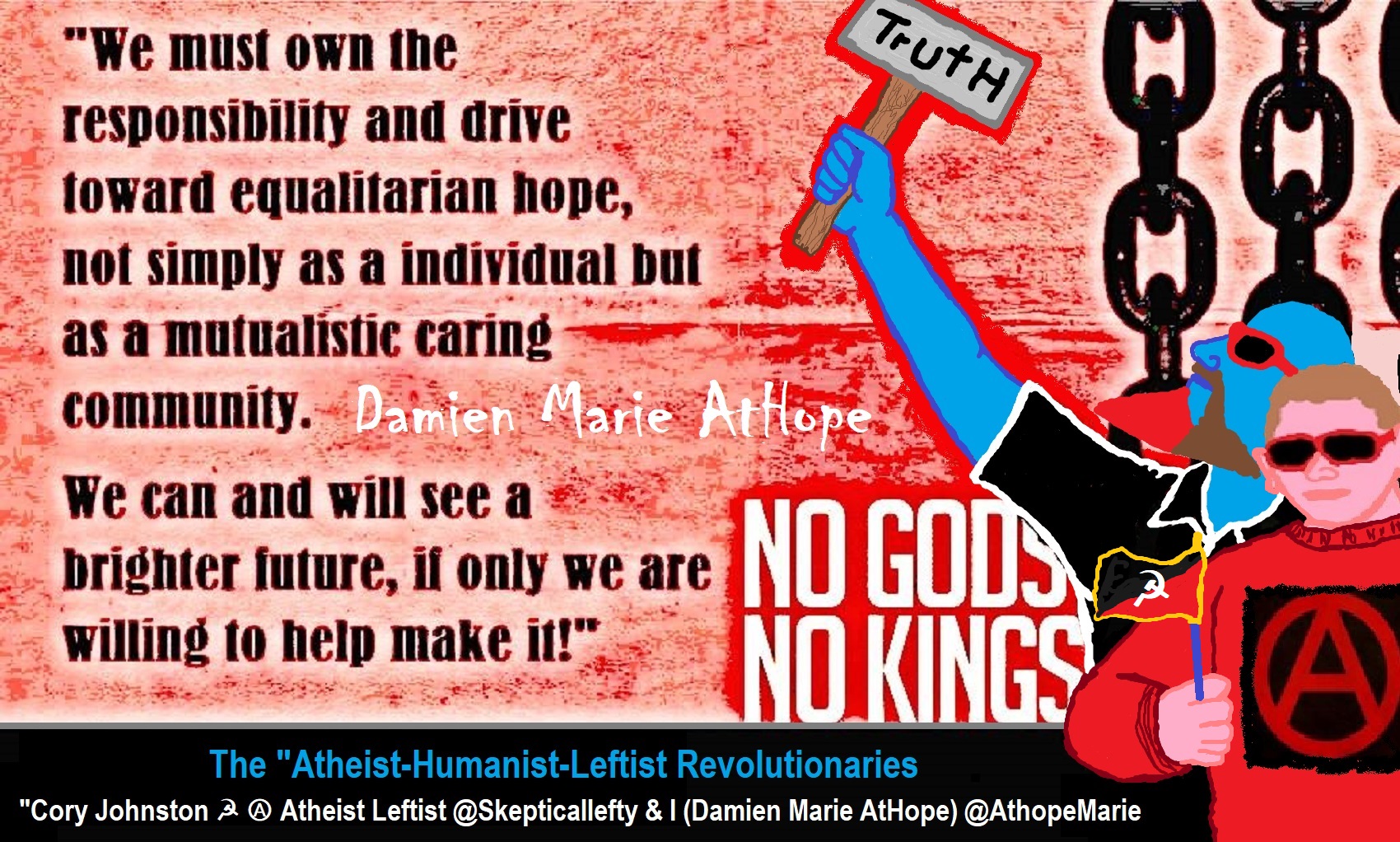
While hallucinogens are associated with shamanism, it is alcohol that is associated with paganism.
The Atheist-Humanist-Leftist Revolutionaries Shows in the prehistory series:
Show two: Pre-animism 300,000 years old and animism 100,000 years old: related to “Anarchism and Socialism”
Show tree: Totemism 50,000 years old: related to “Anarchism and Socialism”
Show four: Shamanism 30,000 years old: related to “Anarchism and Socialism”
Show five: Paganism 12,000 years old: related to “Anarchism and Socialism”
Show six: Emergence of hierarchy, sexism, slavery, and the new male god dominance: Paganism 7,000-5,000 years old: related to “Anarchism and Socialism” (Capitalism) (World War 0) Elite and their slaves!
Prehistory: related to “Anarchism and Socialism” the division of labor, power, rights, and recourses: VIDEO
Pre-animism 300,000 years old and animism 100,000 years old: related to “Anarchism and Socialism”: VIDEO
Totemism 50,000 years old: related to “Anarchism and Socialism”: VIDEO
Shamanism 30,000 years old: related to “Anarchism and Socialism”: VIDEO
Paganism 12,000 years old: related to “Anarchism and Socialism” (Pre-Capitalism): VIDEO
Paganism 7,000-5,000 years old: related to “Anarchism and Socialism” (Capitalism) (World War 0) Elite and their slaves: VIEDO
Paganism 5,000 years old: progressed organized religion and the state: related to “Anarchism and Socialism” (Kings and the Rise of the State): VIEDO
Paganism 4,000 years old: related to “Anarchism and Socialism” (First Moralistic gods, then the Origin time of Monotheism): VIEDO
I do not hate simply because I challenge and expose myths or lies any more than others being thought of as loving simply because of the protection and hiding from challenge their favored myths or lies.
The truth is best championed in the sunlight of challenge.
An archaeologist once said to me “Damien religion and culture are very different”
My response, So are you saying that was always that way, such as would you say Native Americans’ cultures are separate from their religions? And do you think it always was the way you believe?
I had said that religion was a cultural product. That is still how I see it and there are other archaeologists that think close to me as well. Gods too are the myths of cultures that did not understand science or the world around them, seeing magic/supernatural everywhere.
I personally think there is a goddess and not enough evidence to support a male god at Çatalhöyük but if there was both a male and female god and goddess then I know the kind of gods they were like Proto-Indo-European mythology.
This series idea was addressed in, Anarchist Teaching as Free Public Education or Free Education in the Public: VIDEO
Our 12 video series: Organized Oppression: Mesopotamian State Force and the Politics of power (9,000-4,000 years ago), is adapted from: The Complete and Concise History of the Sumerians and Early Bronze Age Mesopotamia (7000-2000 BC): https://www.youtube.com/watch?v=szFjxmY7jQA by “History with Cy“
Show #1: Mesopotamian State Force and the Politics of Power (Samarra, Halaf, Ubaid)
Show #2: Mesopotamian State Force and the Politics of Power (Eridu “Tell Abu Shahrain”)
Show #3: Mesopotamian State Force and the Politics of Power (Uruk and the First Cities)
Show #4: Mesopotamian State Force and the Politics of Power (First Kings)
Show #5: Mesopotamian State Force and the Politics of Power (Early Dynastic Period)
Show #6: Mesopotamian State Force and the Politics of Power (King/Ruler Lugalzagesi)
Show #7: Mesopotamian State Force and the Politics of Power (Sargon and Akkadian Rule)
Show #9: Mesopotamian State Force and the Politics of Power (Gudea of Lagash and Utu-hegal)
Show #12: Mesopotamian State Force and the Politics of Power (Aftermath and Legacy of Sumer)
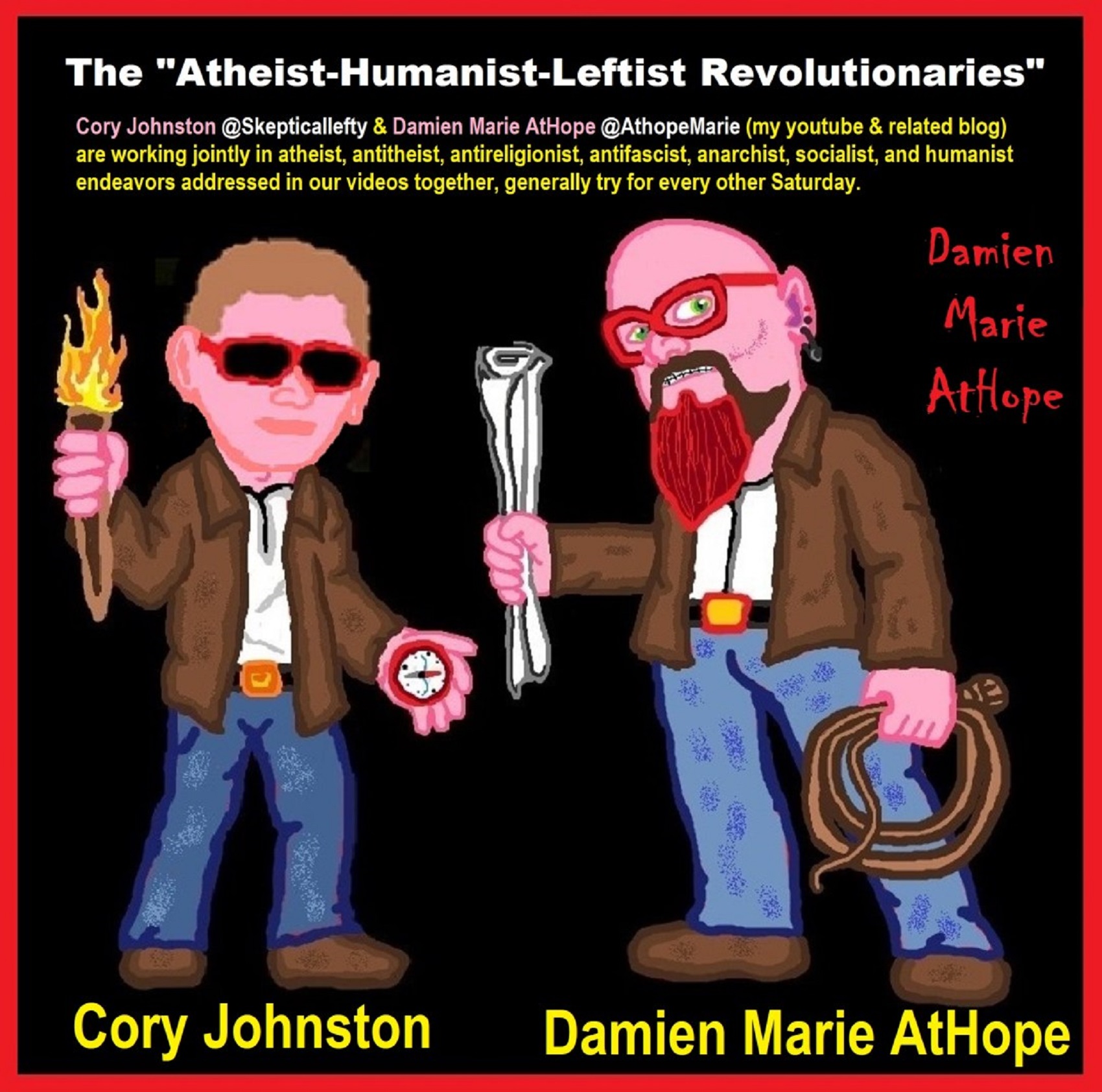
The “Atheist-Humanist-Leftist Revolutionaries”
Cory Johnston ☭ Ⓐ Atheist Leftist @Skepticallefty & I (Damien Marie AtHope) @AthopeMarie (my YouTube & related blog) are working jointly in atheist, antitheist, antireligionist, antifascist, anarchist, socialist, and humanist endeavors in our videos together, generally, every other Saturday.
Why Does Power Bring Responsibility?
Think, how often is it the powerless that start wars, oppress others, or commit genocide? So, I guess the question is to us all, to ask, how can power not carry responsibility in a humanity concept? I know I see the deep ethical responsibility that if there is power their must be a humanistic responsibility of ethical and empathic stewardship of that power. Will I be brave enough to be kind? Will I possess enough courage to be compassionate? Will my valor reach its height of empathy? I as everyone, earns our justified respect by our actions, that are good, ethical, just, protecting, and kind. Do I have enough self-respect to put my love for humanity’s flushing, over being brought down by some of its bad actors? May we all be the ones doing good actions in the world, to help human flourishing.
I create the world I want to live in, striving for flourishing. Which is not a place but a positive potential involvement and promotion; a life of humanist goal precision. To master oneself, also means mastering positive prosocial behaviors needed for human flourishing. I may have lost a god myth as an atheist, but I am happy to tell you, my friend, it is exactly because of that, leaving the mental terrorizer, god belief, that I truly regained my connected ethical as well as kind humanity.
Cory and I will talk about prehistory and theism, addressing the relevance to atheism, anarchism, and socialism.
At the same time as the rise of the male god, 7,000 years ago, there was also the very time there was the rise of violence, war, and clans to kingdoms, then empires, then states. It is all connected back to 7,000 years ago, and it moved across the world.
Cory Johnston: https://damienmarieathope.com/2021/04/cory-johnston-mind-of-a-skeptical-leftist/?v=32aec8db952d
The Mind of a Skeptical Leftist (YouTube)
Cory Johnston: Mind of a Skeptical Leftist @Skepticallefty
The Mind of a Skeptical Leftist By Cory Johnston: “Promoting critical thinking, social justice, and left-wing politics by covering current events and talking to a variety of people. Cory Johnston has been thoughtfully talking to people and attempting to promote critical thinking, social justice, and left-wing politics.” http://anchor.fm/skepticalleft
Cory needs our support. We rise by helping each other.
Cory Johnston ☭ Ⓐ @Skepticallefty Evidence-based atheist leftist (he/him) Producer, host, and co-host of 4 podcasts @skeptarchy @skpoliticspod and @AthopeMarie
Damien Marie AtHope (“At Hope”) Axiological Atheist, Anti-theist, Anti-religionist, Secular Humanist. Rationalist, Writer, Artist, Poet, Philosopher, Advocate, Activist, Psychology, and Armchair Archaeology/Anthropology/Historian.
Damien is interested in: Freedom, Liberty, Justice, Equality, Ethics, Humanism, Science, Atheism, Antiteism, Antireligionism, Ignosticism, Left-Libertarianism, Anarchism, Socialism, Mutualism, Axiology, Metaphysics, LGBTQI, Philosophy, Advocacy, Activism, Mental Health, Psychology, Archaeology, Social Work, Sexual Rights, Marriage Rights, Woman’s Rights, Gender Rights, Child Rights, Secular Rights, Race Equality, Ageism/Disability Equality, Etc. And a far-leftist, “Anarcho-Humanist.”
I am not a good fit in the atheist movement that is mostly pro-capitalist, I am anti-capitalist. Mostly pro-skeptic, I am a rationalist not valuing skepticism. Mostly pro-agnostic, I am anti-agnostic. Mostly limited to anti-Abrahamic religions, I am an anti-religionist.
To me, the “male god” seems to have either emerged or become prominent around 7,000 years ago, whereas the now favored monotheism “male god” is more like 4,000 years ago or so. To me, the “female goddess” seems to have either emerged or become prominent around 11,000-10,000 years ago or so, losing the majority of its once prominence around 2,000 years ago due largely to the now favored monotheism “male god” that grow in prominence after 4,000 years ago or so.
My Thought on the Evolution of Gods?
Animal protector deities from old totems/spirit animal beliefs come first to me, 13,000/12,000 years ago, then women as deities 11,000/10,000 years ago, then male gods around 7,000/8,000 years ago. Moralistic gods around 5,000/4,000 years ago, and monotheistic gods around 4,000/3,000 years ago.

Damien Marie AtHope (Said as “At” “Hope”)/(Autodidact Polymath but not good at math):
Axiological Atheist, Anti-theist, Anti-religionist, Secular Humanist, Rationalist, Writer, Artist, Jeweler, Poet, “autodidact” Philosopher, schooled in Psychology, and “autodidact” Armchair Archaeology/Anthropology/Pre-Historian (Knowledgeable in the range of: 1 million to 5,000/4,000 years ago). I am an anarchist socialist politically. Reasons for or Types of Atheism
My Website, My Blog, & Short-writing or Quotes, My YouTube, Twitter: @AthopeMarie, and My Email: damien.marie.athope@gmail.com

